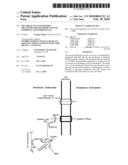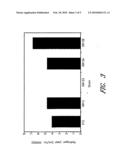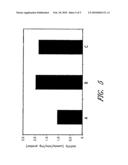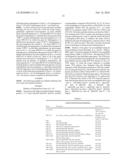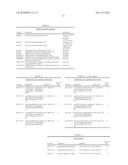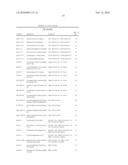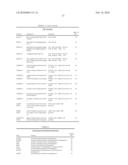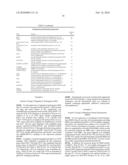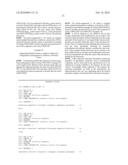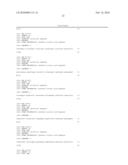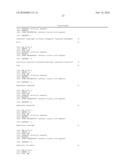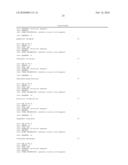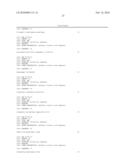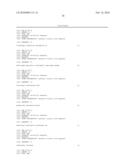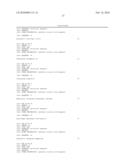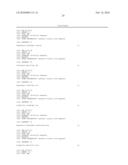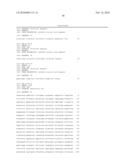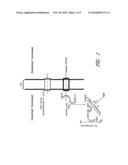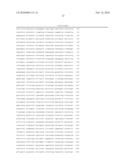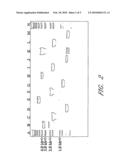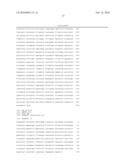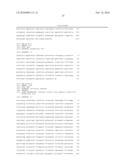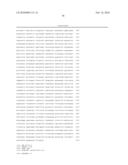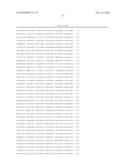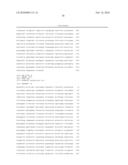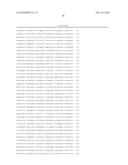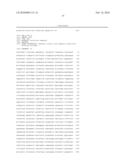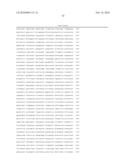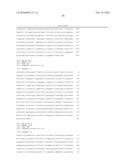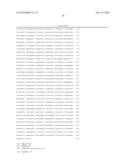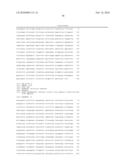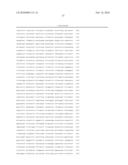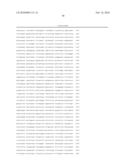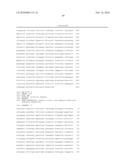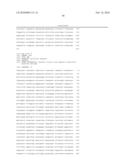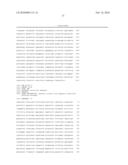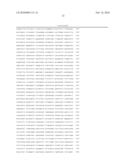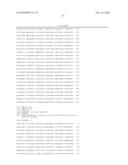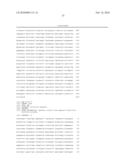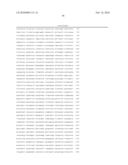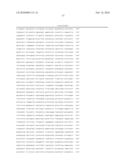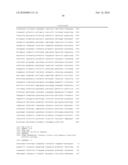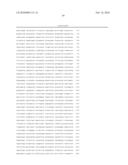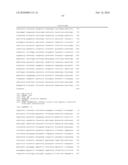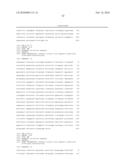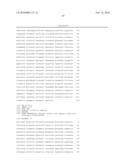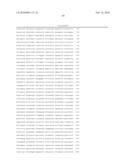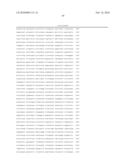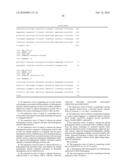Patent application title: METABOLICALLY ENGINEERED ORGANISMS FOR THE PRODUCTION OF HYDROGEN AND HYDROGENASE
Inventors:
Guangyi Wang (Honolulu, HI, US)
Assignees:
University of Hawaii
IPC8 Class: AC12N1570FI
USPC Class:
435168
Class name: Chemistry: molecular biology and microbiology micro-organism, tissue cell culture or enzyme using process to synthesize a desired chemical compound or composition preparing element or inorganic compound except carbon dioxide
Publication date: 2010-02-18
Patent application number: 20100041121
Claims:
1. An expression vector comprising one or more nucleic acid sequences
associated with biosynthesis of a hydrogenase enzyme, wherein expression
of the vector within a predetermined host results in altered hydrogenase
activity that is different from native hydrogenase activity within the
host.
2. The expression vector of claim 1, comprising one or more nucleic acid sequences encoding a hydrogenase enzyme or a fragment thereof.
3. The expression vector of claim 1, wherein the altered hydrogenase activity comprises elevated total hydrogenase activity within the host.
4. The expression vector of claim 1, wherein the altered hydrogenase activity comprises a hydrogenase activity with at least one distinct property as compared with the native hydrogenase activity within the host, and wherein the distinct property is selected from: increased enzyme yield, increased specific activity, improved temperature-independent stability, improved pH-independent stability, increased catalytic efficiency, increased hydrogen evolution rate.
5. The expression vector of claim 1, wherein the host is a hydrogenase-null microbial strain, and wherein the altered hydrogenase activity comprises restoration of detectable hydrogenase activity within the host.
6. The expression vector of claim 1, wherein the host is selected from E. coli strains: GW12, GW12A, GW1234, GW12AP, GW1234P, GW12APN, GW1234PN, GW0123HE and GW0123HEP.
7. The expression vector of claim 1, comprising a nucleic acid sequence derived from a microbial species selected from: R. eutropha, E. coli, and C. acetobutylicum.
8. The expression vector of claim 1, comprising a sequence of a gene or gene fragment, or a derivative thereof, selected from: hoxBC, hoxFUYH, hoxKGZ, hycEG, hydAEFG, hypRE, hoxMLOQRTV, and hoxWI.
9. The expression vector of claim 1, wherein the altered hydrogenase activity is associated with a condition selected from the group consisting of: increased enzyme yield, improved expression levels of hydrogenase, improved specific activity, improved temperature-independent stability, improved pH-independent stability, increased catalytic efficiency, increased hydrogen evolution rate, improved host compatibility, elevated cofactor levels, light energy-dependent ATP production.
10. (canceled)
11. The expression vector of claim 1, comprising at least one of: SEQ ID NO: 62, 66, 72-76, and 81.
12. A hydrogenase-null microorganism for heterologous expression of active hydrogenase.
13. The microorganism of claim 11, transformed with the expression vector of claim 1.
14. The microorganism of claim 11, wherein the microorganism is E. coli.
15. The microorganism of claim 11, wherein a portion of the genome is deleted, and wherein said portion comprises at least one sequence selected from: SEQ ID NO: 56, 57, 61, 63, 64 and 65.
16. The microorganism of claim 11 transformed with one or more expression vectors comprising at least one of: SEQ ID NO: 62, 66, 72-76 and 81.
17. The microorganism of claim 11 wherein one or more of SEQ ID NO: 62, 70-76, 81 and 82 is integrated into the genome of the microorganism.
18. A fuel cell system for oxidation of molecular hydrogen comprising the microorganism of claim 12.
19. A recombinant fuel-cell catalyst comprising at least one hydrogenase enzyme, wherein the hydrogenase enzyme is at least one of: a regulatory hydrogenase, a soluble hydrogenase, and a membrane-bound hydrogenase.
20. The catalyst of claim 18, wherein the hydrogenase is encoded by one or more of SEQ ID NO: 72, 73 and 74.
21. The catalyst of claim 18, comprising hydrogenase produced by expression of the expression vector of claim 1.
22. The catalyst of claim 18, comprising: hydrogenase expressed in the microorganism of claim 12.
23. A method of producing hydrogen, comprising:providing the microorganism of claim 12;growing the microorganism in a cell culture medium; andrecovering hydrogen produced by the microorganism.
Description:
CROSS-REFERENCE TO RELATED APPLICATIONS
[0001]The application present application claims priority to U.S. Provisional Application No. 60/764,519, filed Feb. 1, 2006, which is hereby incorporated by reference in its entirety.
BACKGROUND OF THE INVENTION
[0003]1. Field of the Invention
[0004]This invention relates to the field of enzymes for use in hydrogen-based fuel cells. More specifically, the invention relates to recombinantly-expressed hydrogenases and their applications for use in hydrogen-based fuel cells as well as production of hydrogen in engineered E. coli strains.
[0005]2. Description of the Related Art
[0006]There has been an increasing interest in alternative fuels due to rising petroleum costs, escalating diplomatic tensions with oil producing countries, and the rising levels of greenhouse gases in the atmosphere (Kessel, D. G. 2000. J. Pet. Sci. Eng. 26:157-168, which is incorporated herein by reference in its entirety). As a solution to these problems, hydrogen is an ideal fuel due to its high energy content and nonpolluting nature (Lin, C. Y., and C. H. Lay. 2004. Int. J. Hydrog. Energy 29:275-281; Oh, S. E. et al. 2003. Environ. Sci. Technol. 37:5186-5190, each of which is incorporated herein by reference in its entirety). The key to a hydrogen economy is finding an efficient, inexpensive, and renewable process for the production of hydrogen (Hallenbeck, P. C., and J. R. Benemann. 2002. Int. J. Hydrog. Energy 27:1185-1193, which is incorporated herein by reference in its entirety) while also achieving the equally important goal of economically converting hydrogen into usable energy (Karyakin, A. A. et al. 2005. Biochem. Soc. Transact. 33:73-75, which is incorporated herein by reference in its entirety).
[0007]Platinum is the most commonly used catalyst for fuel cells. Currently, platinum catalysts are used to split hydrogen into two protons and two electrons. However, it is expensive and with limited availability, contributes greatly to the cost of fuel cells. Platinum is also easily poisoned by impurities, such as carbon monoxide (CO) and sulfur (S), which are commonly present in industrial hydrogen (Karyakin, A. A. et al. 2002. Electrochem. Commun. 4:417-420, which is incorporated herein by reference in its entirety).
[0008]Several hydrogenases have been proposed as candidates for a good bioelectrocatalyst in hydrogen oxidation that can potentially hold promise as an inexpensive alternative to platinum in fuel cell development (Jones, A. K. et al. Chem. Commun. 21:866-867; Morozov, S. V. et al. 2002. Bioelectrochemistry 55:169-171; Vincent, K. A. et al. 2005. Proc. Natl. Acad. Sci. USA 102:16951-16954, each of which is incorporated herein by reference in its entirety). For example, the [NiFe] hydrogenase from the purple bacterium Allochromatium vinosum is a remarkably active electrocatalyst. The electrode coated with the hydrogenase catalyzes hydrogen oxidation with a turnover number exceeding 1500 sec-1 under a partial pressure of 0.1 bar of H2 at 30° C. (Pershad, H. R. et al. 1999. Biochemistry 38:8992-8999, which is incorporated herein by reference in its entirety). The oxidative activity of the active site is comparable to that of a platinum fuel cell catalyst (Jones, A. K. et al. 2002. supra), but unlike the costly platinum electrode, the hydrogenase-coated electrode is less susceptible to CO poisoning. Finally, hydrogenase confers fuel specificity and greater turnover rates than their metal counterparts, and its use in place of metal catalysts will allow fuel cells to be operated at neutral pH and ambient temperatures, which are the conditions much more favorable for the handling of fuel cells (Ikeda, T., and K. Kano. 2001. J. Biosci. Bioeng. 92:9-18, which is incorporated herein by reference in its entirety; Karyakin, A. A. 2002. supra). Therefore, the [NiFe]-hydrogenases are a promising electrocatalyst in fuel cells, offering an alternative to platinum.
[0009]Though [NiFe]-hydrogenases exhibit promise, there remain problems associated with use of these and other hydrogenase enzymes. The stability of hydrogenases has been one of the major disadvantages in their use in enzyme fuel cells (Sasaki, S., and I. Karube. 1999. Trends Biotechnol. 17:50-52, which is incorporated herein by reference in its entirety). Furthermore, though the enzymes demonstrate less susceptibility to CO poisoning than does platinum, commercial use requires further improvement in terms of both the sensitivity to CO as well as to oxygen. In addition, the lack of hydrogenase availability in large quantities limits their potential application in enzyme fuel cells (Kessel, D. G. 2000. supra). Therefore, production of stable hydrogenase in large quantities and with desired catalytic properties will greatly enhance the application of this interesting bioelectrocatalyst for hydrogen fuel.
SUMMARY OF THE INVENTION
[0010]The invention relates generally to expression vectors, microorganisms, methods and reactor systems to produce hydrogen and active hydrogenase enzymes for energy- and electricity-generating applications. The expression vectors and microorganism can be used in fermentation methods to produce the products of interest. Both the hydrogen and active hydrogenase products can be incorporated into a system such as, for example, a fuel cell system for producing electricity from hydrogen.
[0011]In various embodiments of the invention, an expression vector comprising one or more nucleic acid sequences associated with biosynthesis of a hydrogenase enzyme, wherein expression of the vector within a predetermined host results in altered hydrogenase activity that is different from native hydrogenase activity within the host, is provided. The expression vector can comprise one or more nucleic acid sequences encoding a hydrogenase enzyme or a fragment thereof. The altered hydrogenase activity can comprise elevated total hydrogenase activity within the host. In some embodiments, the altered hydrogenase activity comprises a hydrogenase activity with at least one distinct property as compared with the native hydrogenase activity within the host, wherein the distinct property is selected from: increased enzyme yield, increased specific activity, improved temperature-independent stability, improved pH-independent stability, increased catalytic efficiency, increased hydrogen evolution rate. In some embodiments, the altered hydrogenase activity is associated with a condition selected from the group consisting of: increased enzyme yield, improved expression levels of hydrogenase, improved specific activity, improved temperature-independent stability, improved pH-independent stability, increased catalytic efficiency, increased hydrogen evolution rate, improved host compatibility, elevated cofactor levels, light energy-dependent ATP production.
[0012]In various embodiments of the invention, the predetermined host is selected from E. coli strains: GW12, GW12A, GW1234, GW12AP, GW1234P, GW12APN, GW1234PN, GW0123HE and GW0123HEP.
[0013]In various embodiments of the invention, the expression vector comprises a nucleic acid sequence derived from a microbial species selected from: R. eutropha, E. coli, and C. acetobutylicum. In some embodiments, the expression vector comprises a gene or gene fragment, or a derivative thereof, selected from: hoxBC, hoxFUYH, hoxKGZ, hycEG, hydAEFG, hypRE, hoxMLOQRTV, and hoxWI. In further embodiments, the expression vector comprises at least one sequence selected from the group: SEQ ID NO: 62, 66, 72, 73, 74, 75, 76 and 81.
[0014]In various embodiments of the invention, an expression vector for the expression of an uptake hydrogenase enzyme is provided. The vectors comprise one or more nucleic acid sequences encoding an uptake hydrogenase enzyme, an uptake hydrogenase enzyme accessory gene and fragments thereof.
[0015]The uptake hydrogenase enzyme expressed by the vector is preferably a hydrogenase enzyme from R. eutropha. The hydrogenase enzyme from R. eutropha can be, for example, regulatory hydrogenase, membrane-bound hydrogenase, or soluble hydrogenase. In some embodiments, the hydrogenase enzyme is regulatory hydrogenase. In some embodiments, the hydrogenase enzyme is membrane-bound hydrogenase. In some embodiments, the hydrogenase enzyme is soluble hydrogenase. In addition, the vector can comprise one or more nucleic acid sequences selected from the group: SEQ ID NO: 72, 73 and 74. In some embodiments, the vector comprises SEQ ID NO:72. In some embodiments, the vector comprises SEQ ID NO: 73. In some embodiments, the vector comprises SEQ ID NO: 74.
[0016]The uptake hydrogenase enzyme accessory gene of the vector is preferably involved in the maturation and expression of active uptake hydrogenase enzyme. The accessory gene can comprise one or more of the following: hypRE, hoxMLOQRTV, or hoxWI. In some embodiments, the accessory gene comprises hypRE. In some embodiments, the accessory gene comprises hoxMLOQRTV. In some embodiments, the accessory gene comprises hoxWI. In addition, the vector can comprise one or more nucleic acid sequences selected from the group: SEQ ID NO: 66, 75 and 76. In some embodiments, the vector comprises SEQ ID NO: 66. In some embodiments, the vector comprises SEQ ID NO: 75. In some embodiments, the vector comprises SEQ ID NO: 76.
[0017]In various embodiments of the invention, a vector for the expression of a hydrogenase enzyme that catalyzes a reaction to evolve hydrogen is provided. The vector can comprise one or more nucleic acid sequences associated with biosynthesis of a hydrogenase enzyme selected from the group: hydrogenase 3 from E. coli, Fe-hydrogenase from C. acetobutylicum. In some embodiments, the vector comprises a nucleic acid that encodes hydrogenase 3 from E. coli. In some embodiments, the vector comprises a nucleic acid that encodes Fe-hydrogenase from C. acetobutylicum. In some embodiments, the vector comprises nucleic acids that encode hydrogenase 3 from E. coli and Fe-hydrogenase from C. acetobutylicum. Furthermore, the vector can comprise at least one nucleic acid sequence selected from the group: SEQ ID NO: 62 and 81. In some embodiments, the vector comprises SEQ ID NO: 62. In some embodiments, the vector comprises SEQ ID NO: 81. In some embodiments, the vector comprises SEQ ID NO: 62 and 81.
[0018]In various embodiments of the invention, a hydrogenase-null microorganism for heterologous expression of active hydrogenase is provided. The hydrogenase-null microorganism can be, for example, E. coli. In some embodiments, the hydrogenase-null microorganism is transformed with an expression vector comprising one or more nucleic acid sequences associated with biosynthesis of a hydrogenase enzyme, wherein expression of the vector within a predetermined host results in altered hydrogenase activity that is different from native hydrogenase activity within the host.
[0019]In various embodiments of the invention, there is provided an E. coli microorganism, wherein a portion of the genome is deleted, and wherein said portion comprises at least one sequence selected from: SEQ ID NO: 56, 57, 61, 63-65.
[0020]In various embodiments of the invention, there is provided an E. coli microorganism wherein one or more sequences associated with a hydrogenase enzyme is deleted from the host genome. The hydrogenase enzyme can be, for example, hydrogenase 1, hydrogenase 2, hydrogenase 3 or hydrogenase 4. In some embodiments, one sequence is deleted from the genome. In some embodiments, two sequences are deleted from the genome. In some embodiments, three or more sequences are deleted from the genome. In some embodiments, a sequence associated with hydrogenase 1 is deleted from the genome. In some embodiments, a sequence associated with hydrogenase 2 is deleted from the genome. In some embodiments, sequences associated with hydrogenase 1 and hydrogenase 2 are deleted from the genome. In some embodiments, a sequence associated with hydrogenase 3 is deleted from the genome. In some embodiments, a sequence associated with hydrogenase 4 is deleted from the genome. In some embodiments, sequences associated with hydrogenase 1, hydrogenase 2 and hydrogenase 3 are deleted from the genome. In some embodiments, sequences associated with hydrogenase 1, hydrogenase 2, hydrogenase 3 and hydrogenase 4 are deleted from the genome.
[0021]In various embodiments of the invention, there is provided an E. coli microorganism wherein at least one sequence associated with a hydrogenase enzyme is deleted from the host genome, wherein the at least one sequence is selected from: SEQ ID NO: 56, 57, 61 and 63-65. In some embodiments, one sequence is deleted from the genome. In some embodiments, two sequences are deleted from the genome. In some embodiments, three or more sequences are deleted from the genome. In some embodiments, SEQ ID NO: 56 is deleted from the genome. In some embodiments, SEQ ID NO: 57 is deleted from the genome. In some embodiments, SEQ ID NO: 56 and 57 are deleted from the genome. In some embodiments, SEQ ID NO: 56, 57 and 61 are deleted from the genome. In some embodiments, SEQ ID NO: 63 is deleted from the genome. In some embodiments, SEQ ID NO: 64 is deleted from the genome. In some embodiments, SEQ ID NO: 56, 57 and 63 are deleted from the genome. In some embodiments, SEQ ID NO: 56, 57, 63 and 64 are deleted from the genome.
[0022]In various embodiments of the invention, a hydrogenase-null microorganism is transformed with one or more expression vectors comprising: SEQ ID NO: 62, 66, 72-76 and 81.
[0023]In various embodiments of the invention, a hydrogenase-null microorganism is provided wherein one or more of SEQ ID NO: 62, 70-76, 81 and 82 is integrated into the genome of the microorganism.
[0024]In various embodiments of the invention, a host selected from E. coli strains: GW12, GW12A, GW1234, GW12AP, GW1234P, GW12APN, GW1234PN, GW0123HE and HW0123HEP is transformed with one or more expression vectors comprising: SEQ ID NO: 62, 66, 72-76 and 81.
[0025]In various embodiments of the invention, a host selected from E. coli strains: GW12, GW12A, GW1234, GW12AP, GW1234P, GW12APN, GW1234PN, GW0123HE and HW0123HEP is provided, wherein one or more of SEQ ID NO: 62, 72-76 and 81 is integrated into the genome of the microorganism.
[0026]In various embodiments of the invention, a fuel cell system for oxidation of molecular hydrogen comprising a hydrogenase-null microorganism for heterologous expression of an active hydrogenase, wherein the microorganism is transformed with one or more expression vectors comprising one or more nucleic acid sequences associated with biosynthesis of a hydrogenase enzyme, wherein expression of the at least one vector within a predetermined host results in altered hydrogenase activity that is different from native hydrogenase activity within the host, is provided. The nucleic acid sequences can be associated with uptake hydrogenase enzymes, including, but not limited to: regulatory hydrogenase, membrane-bound hydrogenase and soluble hydrogenase. In some embodiments, the one or more expression vectors comprise a sequence selected from: SEQ ID NO: 66 and 72-76.
[0027]In various embodiments of the invention, a recombinant fuel-cell catalyst comprising one or more hydrogenase enzymes selected from: a regulatory hydrogenase, a soluble hydrogenase and a membrane-bound hydrogenase, is provided. The one or more hydrogenase is encoded by one or more of SEQ ID NO: 72, 73 and 74. In some embodiments, the catalyst comprises one or more hydrogenase enzymes produced by expression of an expression vector comprising one or more nucleic acid sequences associated with biosynthesis of a hydrogenase enzyme, wherein expression of the vector within a predetermined host results in altered hydrogenase activity that is different from native hydrogenase activity within the host. The catalyst can also comprise one or more hydrogenase enzymes expressed in a hydrogenase-null microorganism comprising such an expression vector.
[0028]In various embodiments of the invention, a method of producing hydrogen is provided. A hydrogenase-null microorganism transformed with an expression vector comprising one or more nucleic acid sequences associated with biosynthesis of a hydrogenase enzyme, wherein expression of the at least one vector within a predetermined host results in altered hydrogenase activity that is different from native hydrogenase activity within the host, is provided. The microorganism is grown in a cell culture medium, followed by recovery of the hydrogen produced by the microorganism.
BRIEF DESCRIPTION OF THE DRAWINGS
[0029]FIG. 1 illustrates the biochemical and enzymatic activities involved in the generation of hydrogen in an engineered E. coli strain.
[0030]FIG. 2 is a gel that illustrates the gene knock-out of the large and small subunits of hydrogenase 1, 2, 3, and 4 in engineered E. coli strains.
[0031]FIG. 3 is a bar graph that illustrates hydrogen yields among native and engineered E. coli strains.
[0032]FIG. 4 is a graph that illustrates the effect of deleting the uptake hydrogenases 1 and 2 on the production of hydrogen in genetically engineered E. coli strains.
[0033]FIG. 5 is a bar graph that illustrates enzymatic hydrogenase activity among various genetically engineered E. coli strains.
DETAILED DESCRIPTION OF THE PREFERRED EMBODIMENT
[0034]Biological production of hydrogen is promising due to its reliance on renewable resources such as solar energy and organic wastes. Particularly, dark fermentation of organic substrates under anaerobic conditions seems to hold the best promise for biohydrogen production due to low operating costs, relative high production efficiency, and relatively stable hydrogen evolving enzymes (Das, D., and T. N. Veziroglu. 2001. Int. J. Hydrog. Energy 26:13-28; Hallenbeck, P. C., and J. R. Benemann. 2002. Int. J. Hydrog. Energy 27:1185-1193, each of which is incorporated herein by reference in its entirety). Organic wastes from agriculture or sewage can be fed into anaerobic bioreactors, achieving the dual goals of waste management and hydrogen production (Benemann, J. 1996. Nat. Biotechnol. 14:1101-1103, which is incorporated herein by reference in its entirety; Chittibabu, G. et al. 2006. supra). However, several obstacles such as inhibition of hydrogen-evolving enzymes by oxygen, hydrogen consumption by uptake hydrogenases, overall low production yield, and the gas impurities still exist as main stumbling blocks for the viable macroscale utilization and production of hydrogen from renewable sources (Pinto, F. A. L. et al. 2002. Int. J. Hydrog. Energy 27:1209-1215, which is incorporated herein by reference in its entirety; Das, D., and T. N. Veziroglu. 2001. supra; Hallenbeck, P. C., and J. R. Benemann. 2002. supra).
[0035]Hydrogenases have found use in a variety of biotechnological applications, including biohydrogen production, applications in biofuel cells, biosensors, wastewater treatment, the prevention of microbial-induced corrosion, and the generation and regeneration of NADP cofactors (Mertens, R., and A. Liese. 2004. Curr. Opin. Biotechnol. 15:343-348, which is incorporated herein by reference in its entirety). Because of their remarkable electrochemical characteristics, hydrogenases have tremendous potential to be used in hydrogen production and oxidation as a bioelectrocatalyst. First, hydrogenases, such as the Fe-only hydrogenase, have been a key enzyme involved in biohydrogen production and are used as a catalyst in photoinduced hydrogen production (Hallenbeck, P. C., and J. R. Benemann. 2002. supra; Qian, D. J. et al. 2002. Int. J. Hydrog. Energy 27:1481-1487, which is incorporated herein by reference in its entirety). Second, hydrogenases, such as the [NiFe] hydrogenase, are good bioelectrocatalysts in hydrogen oxidation and have implications for fuel cell development (Jones, A. K. et al. 2002; Morozov, S. V. et al. 2002. supra).
[0036]As herein described, host bacterial strains were engineered in order to produce hydrogenases for use as biocatalysts as well as to produce hydrogen. Four hydrogenases responsible for the utilization and production of hydrogen in Escherichia coli were sequentially deleted from the organism genome using genetic engineering tools. It was demonstrated that engineered strains in which hydrogen-uptake genes were deleted produced much higher levels of hydrogen than the parental strain. In addition, all four hydrogenase genes were deleted in E. coli to engineer a hydrogenase-null host, from which strains for hydrogenase enzyme production and hydrogen evolution were developed.
[0037]The hydrogenase-null strain was used to produce functional hydrogenase as a biocatalyst for hydrogen fuel cells and is envisioned as a platform strain for protein engineering of hydrogenases with improved catalytic and stability properties. Using [NiFe] hydrogenase genes obtained from Ralstonia eutropha, the genes for regulatory hydrogenase (RH), membrane-bound hydrogenase (MBH) and soluble hydrogenase (SH) of R. eutropha were successfully introduced and expressed in the hydrogenase-null strain. In addition, accessory (or maturation) genes or proteins were co-expressed in the hydrogenase-null strain to improve expression of the active forms of hydrogenase.
[0038]In addition, as herein described, "mixotrophic" strains can be developed from the hydrogenase-null host strain to produce hydrogen through biological means and to optimize the biochemical processes by which hydrogen is evolved. For example, using the hydrogenase-null strain platform, Fe-hydrogenase genes obtained from Clostridium acetobutylicum, is introduced and expressed to increase hydrogen output. Additional developments include the engineering of strains to generate ATP (the energy currency of biological activities) from light energy in order to aid the evolution of hydrogen, which is an endergonic biological process. Furthermore, the strains can be engineered to increase production of cofactors involved in hydrogen production, such as, for example, NAD+ and NADH. Strains containing hydrogen-evolution enzymes can be used to produce hydrogen in a fermenter.
Expression of Hydrogenase in Heterologous Hosts
[0039]The development of a heterologous host for the production of hydrogenases can aid in producing large quantities of the enzymes for use in fuel cells and for making improvements in their bioelectrocatalytic properties. Although efforts have been made to express hydrogenase in heterologous hosts, limited progress has previously only been achieved (Casalto, L., and M. Rousset. 2001. Trends Microbiol. 9:228-237; Friedrich, B., and E. Schwartz. 1993. Annu. Rev. Microbiol. 47:351-383; Maier, T., and A. Bock. 1996. In R. P. Hausinger, G. L. Eichhor, and L. C. Marilli (ed.), Mechanism of metallocenter assembly, New York, p. 173-192, each of which is incorporated herein by reference in its entirety). The main obstacle is that assembly of the active hydrogenase requires complicated biological processes, including careful coordination of cofactor biosynthesis and insertion, subunit recruitment, and protein target processes (Paschos, A. et al. 2002. J. Biol. Chem. 277:49945-49951, which is incorporated herein by reference in its entirety; Vignais, P. M. et al. 2001. supra). These processes are involved in the products of three functional classes of genes that encode structural proteins, regulatory proteins, and maturation (or accessory) proteins. All genes encoding bacterial hydrogenase and products involved in the maturation of hydrogenase are clustered, either on chromosome or on a megaplasmid (Vignais, P. M. et al. 2001. supra).
[0040]There are two main groups of maturation genes which are differentiated by the phenotypes resulting from their mutation (Casalto, L., and M. Rousset. 2001. supra). The first group of genes is mainly located on the same transcription unit as the structural genes. Disruption of this group of genes specifically impairs the processing or activity of the hydrogenase encoded in cis in the operon without affecting the maturation of other isoenzymes. The maturation processes mediated by the products of this family of accessory genes can not be complemented in trans by homologous genes from the other isoenzyme operons, regardless of the degree of similarity (Bernhard, M. et al. 1996. J. Bacteriol. 178:4522-4529, which is incorporated herein by reference in its entirety; Menon, N. K. et al. 1994; Sauter, M. et al. 1992. supra). This specific barrier is considered to be the key reason for the failure of the active hydrogenase production in heterologous hosts. The second group of genes is another set of the hyp (`p` for pleiotrophic) genes which encode proteins involved in the insertion of Ni, Fe, CO and CN into the active site of hydrogenase enzymes (Chaudhuri, A., and A. I. Krasna. 1990. Gen. Microbiol. 136:1153-1160; Dernedde, J. et al. 1996. Eur. J. Biochem. 235:351-358; Jacobi, A. et al. 1992. Arch. Microbiol. 158:444-451; Maier, T. et al. 1996. Arch. Microbiol. 165:333-341; Wolf, I. et al. 1998. Arch. Microbiol. 170:451-459, each of which is incorporated herein by reference in its entirety). Mutations of these genes pleiotropically affect the synthesis and activity of all the hydrogenase isoenzymes. However, the functions of this set of genes can be complemented in trans by heterologous genes (Chaudhuri, A., and A. I. Krasna. 1990. supra).
[0041]Thus far, only few cases of studies have been reported in which functional hydrogenases were successfully expressed in heterologous hosts (Asada, Y. et al. 2000. Biochim. Biophys. Acta-Gene Struct. Expression 1490:269-278; Rousset, M. et al. 1998(b). Plasmid 39:114-122, each of which is incorporated herein by reference in its entirety; Boehm, R. et al. 1990. supra). The first case was the expression of the Fe-only hydrogenase from the strict anaerobe bacterium C. pasteurianum, enhancing the H2 evolution of the expression host cyanobacterium Synechococcus sp. PCCC7942 (Asada, Y. et al. 2000. supra). The second case of heterologous expression involved a cloned [NiFe] hydrogenase and was achieved by interspecies transfer of the hyn genes from the Desulfovibrio gigas into Desulfovibrio fructosovorans MR400, although only low activity was observed (Rousset, M. et al. 1998(b). supra). The third case involved the expression of a functional NAD+-reducing [NiFe] hydrogenase from the gram-positive Rhodococcus opacus in gram-negative R. eutropha (Porthun, A. et al. 2002. Arch. Microbiol. 177:159-166, which is incorporated herein by reference in its entirety). A plasmid carrying the four subunit genes and an accessory gene of a bidirectional NAD+-reducing [NiFe] hydrogenase from R. opacus was transformed into an R. eutropha mutant impaired in H2-oxidizing ability, restoring lithoautotrophic growth.
[0042]Despite these limited successes, none of the above-referenced expression hosts are conventional expression hosts. Non-conventional expression hosts are difficult to culture and genetically manipulate (Rousset, M. et al. 1998(a). Plasmid 39:114-122, which is incorporated herein by reference in its entirety). In addition, although subunits or domains of several hydrogenases have been heterologously expressed in E. coli, functional hydrogenases have not been produced in this conventional host (Atta, M. et al. 1998. Biochemistry 37:15974-15980; Deluca, G. et al. 1998. Biochemistry 37:2660-2665; Mura, G. M. et al. 1996. Microbiology 142:829-836; Verhagen, M. et al. 2001. Biochim. Biophys. Acta-Bioenerg. 1505:209-219; Voordouw, G. et al. 1987. Eur. J. Biochem. 162:31-36, each of which is incorporated herein by reference in its entirety; Asada, Y. et al. 2000; Rousset, M. et al. 1998(b). supra). Heterologous expression of active hydrogenases failed in most cases due to protein-associated maturation processes in the assembly of the active centers. Consequently, engineering hydrogenase with desirable electrochemical properties has been a nearly untapped area. Metabolic engineering can hold the answer to these production and expression problems by providing a way to eliminate bottle necks and to engineer the maturation pathway of heterologous hydrogenases (Bailey, J. E. 1991. Science 252:1668-1675; Chittibabu, G. et al. 2006. Process Biochem. 41:682-688; Kumar, N. et al. 2001. Biotechnol. Lett. 23:537-541; Li, Q. Z., and G. Y. Wang. 2005. Hydrogen and hydrogen bioelectrocatalyst production in synthetic E. coli strains, Industrial Microbiology and Biotechnology. Society for Industrial Microbiology, Chicago, Ill.; Stafford, D. E., and G. Stephanopoulos. 2001. Curr. Opin. Microbiol. 4:336-340, each of which is incorporated herein by reference in its entirety).
Hydrogen Utilization and Candidate Hydrogenases for Expression in Heterologous Hosts
[0043]The proteobacterium Ralstonia eutropha H 16 (formerly Alcaligenes eutrophus) is one of the best studied facultative chemolithoautotrophs and well adapted to the changing chemical environment (Lenz, O., and B. Friedrich. 1998. Proc. Natl. Acad. Sci. USA 95:12474-12479, which is incorporated herein by reference in its entirety). It can grow on wide ranges of organic substrates and alternatively utilizes H2 as the sole energy source (Friedrich, B., and E. Schwartz. 1993. supra).
[0044]R. eutropha possesses two energy-linked [NiFe] hydrogenases: a membrane-bound hydrogenase (MBH) and a soluble cytoplasmic hydrogenase (SH). The MBH is primarily involved in electron transport-coupled phosphorylation through coupling to the respiratory chain via a b-type cytochrome, whereas the SH is able to reduce NDA+ to generate reducing equivalents (Schink, B., and H. G. Schlegel. 1979. Biochim. Biophys. Acta 567:315-324; Schneider, K., and H. G. Schlegel. 1976. Biochim. Biophys. Acta 452:66-80, each of which is incorporated herein by reference in its entirety). The genes encoding the two hydrogenases are clustered in two separate operons (SH and MBH) together with accessory and regulatory genes involved in hydrogenase biosynthesis on megaplasmid pHG1, which has recently been completely sequenced (Schultz, M. G. et al. 2003. Science 302:624-627; Schwartz, E. et al. 1998. J. Bacteriol. 180:3197-3204, each of which is incorporated herein by reference in its entirety). The SH operon comprises the structural genes (hoxFUYH) of the heterotetrameric hydrogenase, two accessory genes (hoxW, hoxI) (Schwartz, E. et al. 2003. J. Mol. Biol. 332:369-383, which is incorporated herein by reference in its entirety). The MBH operon consists of the structural genes (hoxKGZ) and accessory genes (hoxMLOZRTV) (Bernhard, M. et al. 1997. Eur. J. Biochem. 248: 179-186, which is incorporated herein by reference in its entirety). The precise function of most of the conserved MBH accessory genes is not known. Unlike the `regular` oxygen-sensitive hydrogenases from other organisms, the physiologically distinct [NiFe] hydrogenases of R. eutropha are fully active in the presence of molecular oxygen (Lenz, O., et al. 2002. J. Mol. Microbiol. Biotechnol. 4:255-262, which is incorporated herein by reference in its entirety). Recently, it was discovered that one of four cyanides is responsible for the insensitivity of SH towards oxygen.
[0045]A third hydrogenase, regulatory hydrogenase (RH), was identified in R. eutropha and classified as belonging to the subclass of H2-sensing [NiFe] hydrogenases (Kleihues, L. et al. 2000. J. Bacteriol. 182:2716-2724; which is incorporated herein by reference in its entirety; Lenz, O., and B. Friedrich. 1998. supra). The RH is stable in presence of O2, CO, and C2H2. However, its rate of hydrogen oxidation is one to two orders of magnitude lower than that of standard [NiFe] hydrogenase (Pierik, A. J. et al. 1998. FEBS Lett. 438:231-235, which is incorporated herein by reference in its entirety). The RH contains an active size like that in standard [NiFe] hydrogenase. Unlike the `standard` hydrogenases, the RH has only two active states Nia--S and Nia--C*. Furthermore, the RH possesses only one binding sites for H2 while normal [NiFe] hydrogenases have two such sites (Coremans, J. M. C. C. et al. 1992. Biochim. Biophys. Acta 1119:157-168, which is incorporated herein by reference in its entirety). The hoxB and hoxC genes encode the large and small subunit, respectively, of RH. The hyp genes (hypA1B1F1CDEX) are responsible for the maturation of RH in R. eutropha are located between the MBH genes and hoxA. To distinguish the hyp genes of R. eutropha from those of E. coli, hyp genes from R. eutropha are herewith designated as hypRE while those from E. coli are herewith designated as hypEC.
[0046]As herein described, MBH, SH and RH are produced in genetically engineered E. coli strains, and the catalytic properties are improved using protein engineering approaches.
Biohydrogen Production in E. coli
[0047]The model organism and facultative anaerobe, Escherichia coli, is a well-known microbial host for the production of diverse chemicals and proteins. E. coli is capable of three alternative modes of energy generation: aerobic respiration, anaerobic respiration, and fermentation. It utilizes two modes of hydrogen metabolism: (1) respiratory hydrogen oxidation (uptake) linked to quinine reduction, and (2) non-energy conserving hydrogen evolution during fermentative growth (Sawers, G. 1994. Antonie van Leeuwenhoek 66:57-88; Skibinski, D. A. G. et al. 2002. J. Bacteriol. 184:6642-6653, each of which is incorporated herein by reference in its entirety). Four hydrogenase isoenzymes have been identified in the E. coli genome. (Self, W. T. et al. 2004. J. Bacteriol. 186:580-587, which is incorporated herein by reference in its entirety). Two hydrogenases (hydrogenases 1 and 2) are involved in periplasmic hydrogen uptake, while the others (hydrogenases 3 and 4) are part of cytoplasmically oriented formate hydrogenase complexes that evolve hydrogen (Sawers, G. 1994. supra; Self, W. T. et al. 2004. supra; Sawers, R. G. 2005. Biochem. Soc. Transac. 33:42-46; Vignais, P. M. et al. 2001. FEMS Microbiol. Rev. 25:455-501, each of which is incorporated herein by reference in its entirety).
[0048]The uptake hydrogenases 1 and 2 are multi-subunit, membrane-bound, nickel-containing Fe/S proteins (Vignais, P. M. et al. 2001. supra). The function of hydrogenase 1 is thought to cycle hydrogen produced by hydrogenase 3 during fermentation (Sawers, G. 1994. supra). The hya operon encoding hydrogenase 1 comprises six open reading frames, hyaABCDEF (Menon, N. K. et al. 1990. J. Bacteriol. 172: 1969-1977, which is incorporated herein by reference in its entirety). Hydrogenase 1 is a transmembrane protein which is purified as a heterodimer of a 64 kDa large subunit and a 35-kDa small subunit (Sawers, R. G., and D. H. Boxer. 1986. Eur. J. Biochem. 156:265-276, which is incorporated herein by reference in its entirety). The hyaA gene encodes the 40.6 kDa Fe/S protein with a large N-terminal signal sequence. In its maturation process, the loss of the N-terminal signal results in the membrane-bound 35 kDa small subunit. The hyaB encodes the Ni/Fe-containing large subunit. The other genes encode the accessory proteins for the processing of these subunits into the active form. Hydrogenase 2 is involved in H2-dependent fumarate reduction (Ballantine, S. P., and D. H. Boxer. 1986. Eur. J. Biochem. 156:277-284; Menon, N. K. et al. 1994. J. Bacteriol. 176:4416-4423; Sawers, R. G. et al. 1985. J. Bacteriol. 164: 1324-1331, each of which is incorporated herein by reference in its entirety). It is encoded by the hyb operon, containing 8 open reading frames, hybOABCEEFG (29, 44). The core catalytic dimer of hydrogenase 2 consists of the hybOC complex, in which hybC encodes 60 kDa large subunit and hybO encodes the 35 kDa small subunit (Menon, N. K. et al. 1994. supra; Sargent, F. et al. 1998. Eur. J. Biochem. 255:746-754, which is incorporated herein by reference in its entirety). The other genes encode its accessory proteins.
[0049]Under anaerobic conditions, E. coli cells carry out a mixed-acid fermentation and excrete formate (via the formate channel, FocA), acetate, succinate, lactate and ethanol when growing on glycolic carbon sources in absence of electron acceptors. Formate can be metabolized to H2 and CO2 by the membrane-associated formate dehydrogenase (FHL) complex.
##STR00001##
[0050]Thus, the FHL complex offsets the potentially deleterious effects of formate accumulation on fermentation by maintaining pH homeostasis (Boehm, R. et al. 1990. Mol. Microbiol. 4:231-244; Rossmann, R. et al. 1991. Mol. Microbiol. 5:2807-2814; Sauter, M. et al. 1992. Mol. Microbiol. 6:1523-1532, each of which is incorporated herein by reference in its entirety). The FHL 1 complex contains formate dehydrogenase H and the hydrogenase 3. This pathway is only active at low pH and high formate concentration and is thought to provide a detoxification/deacidification system countering the buildup of formate during fermentation. The seven subunits of the hydrogenase 3 are encoded by the hycABCDEFGHI operon (Sauter, M. et al. 1992. supra). The hycE and hycG genes encode the hydrogenase large subunit, containing the [NiFe] center, and the hydrogenase small subunit, respectively. The other gene encodes proteins related to the maturation of hydrogenase 3.
[0051]Analysis of the E. coli genome sequences has revealed the proton-translocating formate hydrogenase 4 (FHL-2), which is encoded by the hyfABCDEFGHIK operon (Andrews, S. C. et al. 1997. Microbiology 143:3633-3647; Bagramyan, K., and A. Trchounian. 2003. Biochem.-Moscow 68:1159-1170, each of which is incorporated herein by reference in its entirety). FHL-1 and FHL-2 appear to have different functions during fermentation. Under fermentation conditions at slightly acidic pH, the production of H2 mostly results from the hydrogenase 3 that is part of FHL-1. On the other hand, at slightly alkaline pH, the H2 production largely depends on the hydrogenase 4 that is part of FHL-2 (Bagramyan, K. et al. 2002. FEBS Lett. 516:172-178, which is incorporated herein by reference in its entirety; Bagramyan, K. et al. 2003. supra). However, expression of hydrogenase 4 is not significant in the wild-type strain (Self, W. T. et al. 2004. supra). Apparently, the function of the hydrogenase 4 needs to be further elucidated.
[0052]Up-regulation of the FHL system in E. coli has previously been reported by blocking the synthesis of the FHL complex repressor, HycA (Penfold, D. W. et al. 2003. Enzyme Microb. Technol. 33:185-189, which is incorporated herein by reference in its entirety). Using glucose as a substrate, this E. coli HD701 strain evolved hydrogen at twice the rate of its counter part wild-type strain. A combination of hycA inactivation with the overexpression of the FHL activator fhlA also reportedly produced a 2.8-fold increase in hydrogen activity compared to the wild-type (Yoshida, A. et al. 2005. Appl. and Environ. Microbiol. 71:6762-6768, which is incorporated herein by reference in its entirety). The engineering and regulation of these hydrogenases has the potential to lead to a strain of E. coli that is capable of producing large quantities of hydrogen (Chittibabu, G. et al. 2006. supra). However, large-scale manipulation of the E. coli genome using metabolic approaches has been not reported for biohydrogen and hydrogenase production. As herein described, we have metabolically engineered E. coli strains for the production of molecular hydrogen and the expression of active hydrogenases from R. eutropha and from C. acetobutylicum.
Biohydrogen Production Using Fe-Hydrogenase from Clostridium acetobutylicum
[0053]Fe-hydrogenase from C. acetobutylicum has been identified as one of the fastest hydrogen-evolving enzymes, which are found in many photosynthetic algae and anaerobic bacteria. The enzyme generates molecular hydrogen by oxidizing NADH to NAD+ (FIG. 1). It has been demonstrated that limiting iron (Fe) in cultures contributes to a decrease in hydrogenase concentration (Junelles, A. M. et al. 1988. Curr. Microbiol. 17:299-303; Peguin, S. and P. Soucaille. 1995. Appl. Environ. Microbiol. 61:403-405, each of which is incorporated herein by reference in its entirety). More recently, accessory genes hydEFG have been shown to be involved in biosynthesis of the active Fe-hydrogenase (HydA) from C. acetobutylicum (King, P. W. et al., 2006. J. Bacteriol. 188:2163-2172, which is incorporated herein by reference in its entirety). As herein described, Fe-hydrogenase from C. acetobutylicum can be expressed in E. coli to increase levels of hydrogen evolved by this common host.
Proteorhodopsin Proteins from Uncultured Marine Bacteria for ATP Generation
[0054]Proteorhodopsin (PR) is an integral membrane protein which binds retinal (vitamin A aldehyde) and functions in light-driven proton pumps in marine organisms (Beja, O. et al. 2000. Science 289:1902-1906; Beja et al. 2001. Nature 411:786-789, each of which is incorporated herein by reference in its entirety). It was first discovered on a large genome DNA fragment derived from uncultured marine γ-proteobacteria of the SAR86 group (Pernthaler, A. et al. 2002. Appl. Environ. Microbiol. 68:5728-5735, which is incorporated herein by reference in its entirety). In addition to proteobacteria, many types of marine plankton have also been found to harbor PR genes (Man, D. et al. 2003. EMBO J. 22:1725-1731); Sabehi G. et al. 2003. Environ. Microbiol. 5:842-849; Sabehi G. et al. 2004. Environ. Microbiol. 6:903-910; de La Torre, J. R. et al. 2003. PNAS 100:12830-12835; Venter, J. C. et al. 2004. Science 304:66-74, each of which is incorporated herein by reference in its entirety). E. coli cells harboring the proteorhodopsin gene acquire protons in the presence of retinal and light (Beja, O. et al. 2000. supra). Recent analysis revealed that PR genes of BAC clones (e.g. MED66A03) are linked to a carotenoid biosynthesis gene cluster, which encodes proteins responsible for converting geranylgeranyl diphosphate to β-carotene (Sabehi G. et al. 2005. PLoS Biol. 3:1409-1417, which is incorporated herein by reference in its entirety). Furthermore, the gene coding for a homolog of the bacteriorhodopsin-related-protein-like homolog protein (Blh) from the archaeon Halobacterium sp. NRC-1 was found in the cluster clone. Blh has been shown to be involved in retinal biosynthesis (Peck, R. F. et al., 2001. J. Biol. Chem. 276:5739-5744). Expression of the blh gene in the β-carotene-producing E. coli cells induces the conversion of β-carotene to retinal (Sabehi, G. et al. 2005. supra). Thus, proteorhodopsin is able to couple the harvesting of light energy to the generation of a membrane potential. This generated membrane potential can then be used to synthesize ATP, which serves as energy currency for biological processes that include hydrogen evolution (FIG. 1).
Production and Function of Cofactors in E. coli for Hydrogen Evolution
[0055]The cofactor NADH plays a major role in cellular metabolism, and its availability can be a limiting factor in enzyme-catalyzed, cofactor-dependent production systems such as, for example, hydrogen evolution systems. It has been demonstrated that cofactor manipulations can be used as an additional tool for metabolic engineering (San, K. Y. et al. 2002. Metabolic Eng. 4:182-192, which is incorporated herein by reference in its entirety).
[0056]In E. coli, the total intracellular NADH/NAD+ pool is maintained by synthesizing NAD through two pathways: (1) the de novo pathway, and (2) the pyridine nucleotide salvage pathway. In the de novo pathway, NAD is synthesized from aspartate and dihydroxyacetone phosphate. The pyridine nucleotide salvage pathway produces NAD by recycling intracellular NAD metabolic products (e.g. nicotinamide mononucleotide (NMN)) and other preformed pyridine compounds from the environment (e.g. nicotinamide and nicotinic acid (NA)) in an ATP-dependent process (Susana, J. B., et al. 2002. Metabolic Eng. 4:238-247, which is incorporated herein by reference in its entirety). The gene pncB encodes the enzyme phosphoribosyl transferase (NAPTTase) in the salvage pathway. It has been shown that overexpression of the pncB gene from Salmonella typhimurium and addition of NA to minimal medium results in an increase in total intracellular NAD levels (Wubbolts et al., 1990. J. Biol. Chem. 265:17665-17672, which is incorporated herein by reference in its entirety). To balance production of NAD for enhancement of hydrogen production in E. coli, the bacterial cells can be engineered to overexpress, for example, phosphoribosyl transferase, Fe-hydrogenase from C. acetobutylicum, hydrogenase 3, or NAD+-dependent formate dehydrogenase (FDH) from Candida boidinii in order to increase NADH levels (Susana, J. B. et al., 2002. Metabolic Eng. 4:217-229, which is incorporated herein by reference in its entirety).
Generation of an E. coli Hydrogenase Null Strain for Engineering of Biocatalytic Hydrogenases and Optimization of Hydrogen Evolution
[0057]The E. coli genome harbors four hydrogen isoenzymes, hydrogenase 1, 2, 3, and 4 (Bagramyan, K. et al. 2002; Bagramyan, K., and A. Trchounian. 2003. supra). These indigenous hydrogenases can cause potential problems for the assay of any heterologously expressed hydrogenase enzyme. To avoid the potential problems of these indigenous hydrogenases, large and small subunits of hydrogenase 1, 2, 3, and 4 were deleted in the genome of the E. coli strain BW25113, generating the hydrogenase null strain (GW1234) using the red recombinase system (Datsenko, K. A., and B. L. Wanner. 2000. Proc. Natl. Acad. Sci. USA 97:6640-6645, which is incorporated herein by reference in its entirety). To verify the correct deletions of resulting strains, PCR primers were designed based on sequences flanking target genes to verify the completion of each gene knock-out (FIG. 2).
Enhancement of Hydrogen Production in Engineered E. coli Strains
[0058]Hydrogenases 1 and 2 have been shown to be involved in periplasmic hydrogen uptake (Vignais, P. M. et al. 2001. supra). The strain GW12 (ΔhyaAB ΔhybABC), which does not express uptake hydrogenase 1 and 2, displayed increased hydrogen production by 17.1% under anaerobic fermentation conditions (Temp=37° C.; pH=7, dissolved oxygen=0.14%, CO2=9.3%). See FIG. 3. In a further experiment, the gene hycA (SEQ ID NO: 61), which encodes repressor of hydrogenase 3 expression (Sauter, M. et al. 1992. supra), was deleted in GW12 for comparison of hydrogen evolution. The resulting strain GW12A displayed no significant increase in the hydrogen production rate in comparison with that of GW12. This is inconsistent with the report that the strain HD701 (ΔhycA) evolved several times more hydrogen than the wild-type parent strain MC4100 (Penfold, D. W. et al. 2003. supra). Currently, the hydrogen production rate of GW12A is being analyzed under different fermentation conditions.
[0059]To further increase the hydrogen production yield, genes encoding two subunits of hydrogenase 3 (hycEG) were overexpressed in strains GW12. The expression plasmid pHycEG was constructed by cloning the two genes of hycEG (SEQ ID NO: 62) into pTrc99A and transformed into E. coli strain GW12. The GW12 cells harboring pHycEG showed significant increase in hydrogen production rates compared with K12 and GW12 by 68.1% and 43.6%, respectively.
Construction and Expression of RH Biosynthetic Operons in Engineered E. coli for Production of Biocatalytic Hydrogenase
[0060]To express RH from R. eutropha in a genetically engineered E. coli strain, hoxBC genes were amplified from the megaplasmid pHG1, which was enriched from cultures of R. eutropha H16 grown in FN medium (Nies, D. et al. 1987. J. Bacteriol. 169:4865-4868, which is incorporated herein by reference in its entirety). Genes of HoxBC (hoxBC; SEQ ID NO: 72) were cloned into pBAD24. The expression plasmid pHoxBC was constructed by cloning the pBAD promoter and HoxBC into pBBR1MCS-3. At the same time, hypRE genes (SEQ ID NO: 66) were also amplified into two fragments from pHG1 via PCR. The two fragments were then assembled into one fragment using SOE-PCR (Horton, R. M. et al. 1990. Biotechniques 8:528-535, which is incorporated herein by reference in its entirety). The SOE products were cloned into pBAD33 to generate plasmid pRUhyp. The plasmid pHoxBC was transformed into the strain GW1234, the hydrogenase-null strain. In a separate transformation, pHoxBC and pRUhyp were co-transformed into strain GW1234. The empty vector pBAD24 was transformed into strain GW1234 as a control. Cells harboring these plasmids were cultured in LB broth at 37° C. and induced with 0.2% arabinose. Cells were then harvested by centrifugation and suspended with 50 mM Tris-HCl buffer (pH 7). The cell suspension was sonicated with Branson Sonifier 450 equipped with a double stepped microtip (3 mm, diameter). The resulting cell lysates were centrifuged at 14,000 rpm at 4° C. for 10 min. The supernatant was analyzed by uptake hydrogenase assay. The enzyme activity was detected by following the reduction of methyl viologen by hydrogen using a spectrophotometer (DeLacey, A. L. et al. 2003. J. Biol. Inorg. Chem. 8:129-134; Fernandez, V. M. et al. 1985. Biochim. Biophys. Acta 832:69-79, each of which is incorporated herein by reference in its entirety).
[0061]The GW1234 cells harboring pHoxBC displayed significant uptake hydrogen activity (FIG. 5). The cells containing pHoxBC and pRUhyp also showed similar uptake hydrogen activity, but slightly lower than that of cells harboring pHoxBC. The reduction of methyl viologen in the assay for cells harboring pBAD24 is a result indicative of activity from other redox proteins in the crude extract of the E. coli strain. Also, the low activity is ascribed to the nature of RH. Nevertheless, the results demonstrate that functional RH was expressed in the genetically engineered E. coli strain.
Construction and Expression of MBH and SH from R. eutropha for Production of Biocatalytic Hydrogenase
[0062]It has been demonstrated that a graphite electrode coated with membrane-bound hydrogenase (MBH) from R. eutropha can carry out rapid electrocatalytic oxidation of hydrogen. This oxidation reaction is unaffected by CO poisoning (conditions: pressure=0.9 bar, 9-fold excess of CO) and is only partially inhibited by oxygen (Vincent K. A. et al. 2005. PNAS. 102:16951-16954, which is incorporated herein by reference in its entirety). In order to construct and express an expression vector for MBH, the accessory genes for MBH (hoxMLOQRTV; SEQ ID NO: 75) and SH (hoxWI; SEQ ID NO: 76) were amplified from pHG1 into two DNA fragments using the following primers: hoxM-f, hoxVr, hoxW-f, hoxVI SOE-f, and hoxI-r (SEQ ID NO: 33 through 37). The two fragments were spliced together as a single operon via SOE-PCR (Horton, R. M. et al. 1990. supra). The SOE products were then cloned into pBAD33 to generate the plasmid pCISMBSH.
[0063]To express MBH in an engineered bacterial strain, the structural genes encoding MBH (hoxKGZ+pHG004, SEQ ID NO: 74) were amplified from pHG1 via PCR and cloned into pASK, generating the plasmid pHoxKGZ4. The engineered strain GW1234 was then co-transformed with pCISMBSH and pHoxKGZ4 to produce active MBH.
[0064]Likewise, to express SH in an engineered bacterial strain, the structural genes of soluble hydrogenase (SH) from R. eutropha (hoxFUYH; SEQ ID NO: 73) were also amplified from pHG1 via PCR and cloned into pASK, generating pHoxFUYH. The engineered strain GW1234 was then co-transformed with pCISMBSH and pHoxFUYH to produce active SH.
Construction and Expression of Fe-Hydrogenase (HydA) from Clostridium acetobutylicum for Hydrogen Evolution
[0065]Three genes (hydE, hydF and hydG) have recently been linked to the functional biosynthesis of Fe-hydrogenase (King, P. W. et al. 2006. J. Bacteriol. 188:2163-2172; Posewitz, M. C. et al. 2004. J. Biol. Chem. 279: 25711-25720, each of which is incorporated herein by reference in its entirety). To construct and express functional Fe-hydrogenase in engineered bacterial strains, the genes hydA, hydE, hydF and hydG (SEQ ID NO: 77 through 80) were isolated and amplified as four separate fragments from the genomic DNA of C. acetobutylicum using the following primers: CaHydA-f, CaHydA-r, CaHydE-f, CaHydE-r, CaHydF-f, CaHydF-r, CaHydG-f and CaHydG-r (SEQ ID NO: 45 through 52). The four fragments were then spliced together as a single operon via SOE-PCR (Horton, R. M. et al. 1990. supra) using the primers hydAE SOE-r, hydFG SOE-r, and hydAE/FG SOE-r (SEQ ID NO: 53 through 55). The SOE products were cloned into pBAD24 and pTrc99A, generating the plasmid pHYDCH24 and pHYDCH99, respectively. The bacterial strains GW12, GW12A and GW1234 transformed with either pHYDCH24 or pHYDCH99 can yield significant increases in hydrogen production.
Engineering "Mixotrophic" E. coli for Hydrogen Production
[0066]The gene cluster encoding a light-driven proton pump from the BAC (Bacterial artificial chromosome) clone MED66A03 (Sabehi, G. et al. 2005. supra) was subcloned using BAC Subcloning Kit (Gene Bridges) according to the manufacturer's manual, generating the plasmid pEIBYBP. To place the gene cluster under control of the synthetic promoter eS1 (Salaiman, D. K. Y and G. A. Somkuti. 1995. Appl. Microbiol. Biotechnol. 43:285-290, which is incorporated herein by reference in its entirety), the 63-bp eS1 promoter was spliced together with the minimal vector of the kit (Gene Bridges) before the subcloning procedure. Using the Quick and Easy Conditional knockout kit (Gene Bridges), the synthetic operon, which include the promoter eSI and the genes encoding the light-driven proton pump (crtE, crtI, crtB, crtY, blh and pr), was integrated into the genomes of engineered bacterial strains GW12A and GW1234, generating new strains GW12AP and GW1234P, respectively.
[0067]E. coli can maintain its total NADH/NAD+ intracellular pool by synthesizing NAD through the de novo pathway and the pyridine nucleotide salvage pathway. The first gene encoding phosphoribosyl transferase (NAPTTase) in the salvage pathway (pncB) is tightly controlled at the transcription level. E. coli bacteria harboring plasmid pSBN, which carries the pncB gene from Salmonella typhimurium (SEQ ID NO: 71) under control of its native promoter, has been shown to increase NAD+ production levels using ATP as an energy source (Berrios-Revera et al. 2002. Metabolic Eng. 4:238-247, which is incorporated herein by reference in its entirety). Plasmid pSBN is integrated into the genomes of strains GW12AP and GW1234P using the kit, generating new strains GW12APN and GW1234PN, respectively. Consequently, the resulting strains can use light as an energy source to produce ATP, which can be used to produce NAD+. Finally, the increased NAD+ can be used to produce H2 via the E. coli hydrogenase 3 (FIG. 1).
Recombinant Evolution of Hydrogen Using Engineered E. coli
[0068]A reactor system can be set up to produce hydrogen from engineered hydrogen-evolving microorganisms. For example, strains GW12 and GW12A, can be cultured under standard fermentation conditions to produce hydrogen for use in, for example, fuel cells. In some embodiments, the microorganisms are cultured at from about 10° C. to about 45° C., more preferably from about 25° C. to about 45° C., most preferably from about 35° C. to about 45° C. The microorganisms can be cultured in standard media such as, for example, LB media. The media optionally includes appropriate antibiotics, based on the antibiotic resistance of the cultured strain. Typically, the pH of the media is from about 3 to about 9, more preferably from about 5 to about 8.5.
[0069]A hydrogen gas collection system can be included in the reactor system such that the hydrogen gas generated is collected and is optionally stored for use. Alternatively, the generated hydrogen gas can be directed to a point of use, such as, for example, to a hydrogen fuel powered device. In some embodiments, a hydrogen gas collection unit includes one or more hydrogen gas conduits for directing a flow of hydrogen gas produced in the reactor system to a storage container or directly to a point of use. In other embodiments, a hydrogen gas conduit is optionally connected to a source of a sweep gas, wherein the hydrogen gas is collected using the sweep gas. An exemplary sweep gas is nitrogen. For example, as hydrogen gas is initially produced, a sweep gas can be introduced into a hydrogen gas conduit, flowing in the direction of a storage container or point of hydrogen gas use. In further embodiments, a hydrogen collection system can include a container for collection of hydrogen from the reactor system. In still other embodiments, a collection system can further include a conduit for passage of hydrogen. The conduit and/or container can be in gas flow communication with a channel provided for outflow of hydrogen gas from the reaction chamber.
[0070]Embodiments of the reactor system include primary and secondary fermentation reactors. An organism is used to carry out the primary fermentation reaction. For example, a primary reaction can include the anaerobic breakdown of sugar, feedstocks or organic wastes into formate by yeast or bacteria, wherein the formate is used as a substrate in a secondary fermentation reaction. The term "primary fermentation reaction" is used to describe a process that results in a by-product. A secondary fermentation reaction takes place when an organism metabolizes a by-product of a primary fermentation reaction. The by-product is used in what is termed herein a "secondary fermentation reaction" indicating that the by-product can be metabolized in order to produce hydrogen gas. Alternatively, the E. coli strains can be engineered to utilize biomass, such as, for example, cellulose, hemicellulose and the like, to dramatically lower the production cost of hydrogen. Research is currently being conducted to investigate these options.
Recombinantly-Produced Biocatalysts in Fuel Cells and Their Operation
[0071]As herein described, the fuel cell of the present subject matter is envisaged as a source of electrical energy which can replace conventional platinum electrode-based fuel cells.
[0072]Fuel cells are electrochemical devices that convert the energy of a fuel directly into electrochemical and thermal energy. Typically, a fuel cell consists of an anode and a cathode, which are electrically connected via an electrolyte. A fuel such as, for example, hydrogen, is fed to the anode where it is oxidized with the help of an electrocatalyst. At the cathode, the reduction of an oxidant such as oxygen (or air) takes place. The electrochemical reactions which occur at the electrodes produce a current and thereby electrical energy. Commonly, thermal energy is also produced which may be harnessed to provide additional electricity or for other purposes. Currently, the most common electrochemical reaction for use in a fuel cell is that between hydrogen and oxygen to produce water. Molecular hydrogen itself can be fed to the anode where it is oxidized, and the electrons produced are passed through an external circuit to the cathode where oxidant is reduced. Ion flow through an intermediate electrolyte maintains charge neutrality. Fuel cells can also be adapted to utilize the hydrogen from other hydrocarbon sources such as methanol or natural gas.
[0073]The fuel cells of the present subject matter utilize hydrogen as a fuel. The source of hydrogen can be hydrogen gas itself, or the hydrogen can be derived from an alternative source such as an alcohol, including methanol and ethanol, or from fossil fuels such as natural gas. Typically, hydrogen itself is used. In some embodiments, the hydrogen is derived from the hydrogen product evolved from the engineered E. coli strains of the present subject matter. In other embodiments, the hydrogen is in a crude form and thus can contain impurities. In still other embodiments, purified hydrogen can be used.
[0074]The fuel source can be a gas which includes hydrogen and which is provided to the anode. In some embodiments, the fuel is provided in liquid form. Generally, the fuel source also includes an inert gas, although substantially pure hydrogen can also be used. For example, a mixture of hydrogen with one or more gases such as nitrogen, helium, neon or argon can be used as the fuel source.
[0075]The fuel source can optionally comprise further components, such as, for example, alternative fuels or other additives. The additives which can be present are preferably those which do not react with the catalyst, which is coated on the positive electrode. If other entities are present which react with the catalyst, these are made to be present in as small an amount as possible. For example, carbon monoxide (CO), which can react with the catalysts used in the present subject matter, is preferably present in an amount of less than about 30% by volume, more preferably less than about 10% by volume, for example less than about 5% or less than about 1% by volume. Higher concentrations of CO can lead to lower hydrogen oxidation currents. However, the effect of CO is reversible, and the removal of CO from the fuel gas can lead to the restoration of the oxidation current.
[0076]Typically, hydrogen is present in the fuel source in an amount of at least about 2% by volume, preferably at least about 5% and more preferably at least about 10% by volume, for example about 25%, 50%, 75% or 90% by volume. Where an inert gas is used to form part of the fuel gas, the inert gas is typically present in an amount of at least about 10%, such as at least about 25%, 50% or 75% by volume, most preferably at least about 80% by volume.
[0077]Generally, the fuel source is supplied from an optionally pressurized container of the fuel source in gaseous or liquid form. The fuel source is supplied to the electrode via an inlet, which can optionally comprise a valve. An outlet is also provided which enables used or waste fuel source to leave the fuel cell.
[0078]The oxidant typically includes oxygen, although any other suitable oxidant can be used. The oxidant source typically provides the oxidant to the cathode in the form of a gas which includes the oxidant. In some embodiments, the oxidant can be provided in liquid form. Generally, the oxidant source also includes an inert gas, although the oxidant in its pure form can also be used. For example, a mixture of oxygen with one or more gases such as nitrogen, helium, neon or argon can be used. The oxidant source can optionally comprise further components, for example alternative oxidants or other additives. An example of a suitable oxidant source is air.
[0079]Typically, oxygen is present in the oxidant source in an amount of at least about 2% by volume, preferably at least about 5% and more preferably at least about 10% by volume.
[0080]Generally, the oxidant source is supplied from an optionally pressurized container of the oxidant source in gaseous or liquid form. The oxidant source is supplied to the electrode via an inlet, which optionally comprises a valve. An outlet is also provided which enables used or waste oxidant source to leave the fuel cell.
[0081]The anode can be made of any conducting material for example stainless steel, brass or carbon, which can be graphite. The surface of the anode can, at least in part, be coated with a different material which facilitates adsorption of the catalyst. The surface onto which the catalyst is adsorbed is of a material which does not cause the hydrogenase to denature. Suitable surface materials include graphite, such as, for example, a polished graphite surface or a material having a high surface area such as carbon cloth or carbon sponge. Materials with a rough surface and/or with a high surface area are generally preferred.
[0082]The cathode can be made of any suitable conducting material which will enable an oxidant to be reduced at its surface. For example; materials used to form the cathode in conventional fuel cells can be used. An electrocatalyst can, if desired, be present at the cathode. This electrocatalyst can, for example, be coated or adsorbed on the cathode itself, or it can be present in a solution surrounding the cathode. Suitable electrocatalysts include those used in conventional fuel cells such as platinum. Biological catalysts can also be used for this purpose.
[0083]The catalyst includes one, or a mixture of, hydrogenases. The catalyst can also include further additives, if desired. Suitable hydrogenases include those having a [Ni--Fe] and/or [Fe--Fe] active site, preferably a [Ni--Fe] active site. Hydrogenases having a [Ni--Fe] and/or [Fe--Fe] active site are found in many microorganisms and are reported to enzymatically catalyze the oxidation and/or reduction of hydrogen in those microorganisms. Examples of the microorganisms containing hydrogenases include methanogenic, acetogenic, nitrogen-fixing, photosynthetic, such as purple photosynthetic, and sulfate-reducing bacteria and those from purple photosynthetic bacteria are preferred. Examples of suitable hydrogenases include, but are not limited to, the hydrogenases from R. eutropha and Fe-hydrogenase from C. acetobutylicum.
[0084]The microorganism discussed above can generally be obtained commercially. The microorganism can be cultured to provide a sufficient quantity of enzyme for use in the fuel cell. This can be carried out, for example, by culturing the enzyme in a suitable medium in accordance with known techniques. Cells can then be harvested, isolated and purified by any known technique.
[0085]The catalyst containing a hydrogenase is adsorbed onto the anode. This ensures that the hydrogenase is in direct electronic contact with the anode. The term "direct electronic contact", as used herein, means that the catalyst is able to exchange electrons directly with the electrode. In this manner, the fuel cell of the present subject matter can operate without the need for an independent electron mediator to transfer charge from the catalyst to the electrode. A further advantage of the adsorption of the catalyst onto the anode resides in the availability of the hydrogenase for reaction. Adsorption of the catalyst onto the electrode avoids a rate-limiting diffusion step through the solution to the electrode in order for a reaction to take place. Further, the hydrogenase can be present in either an active or inactive state. A low electrode potential, such as is found at the anode surface, encourages the existence of the active site. Thus, hydrogenase molecules which are adsorbed to the anode are generally activated as long as the conditions are favorable.
[0086]The anode can be immersed in a suitable medium. This medium can be a solution of the catalyst, or an alternative medium, such as water, which does not contain hydrogenase or contains only very low concentrations of hydrogenase. If hydrogenase is present in the medium, exchange can take place between the hydrogenase molecules adsorbed to the-anode and those in solution. To avoid the exchange of active molecules at the anode with inactive molecules in solution, the concentration of hydrogenase in the medium is minimized. The concentration of hydrogenase in the medium is preferably kept at a minimum, preferably below about 1 mM, more preferably below about 0.1 μM or 0.01 μM.
[0087]Typically, the catalyst layer is adsorbed to the surface of the electrode using an attachment means. The attachment means is typically a polycationic material. Examples of suitable attachment means include large polycationic materials such as, for example, polyamines including polymixin and neomycin. The catalyst can be attached to the electrode surface as a submonolayer, a monolayer or as multiple layers, for example 2, 3, 4 or more layers. Preferably, at least about 10% of the available surface of the anode is coated with catalyst. The "available surface" of the anode is the surface which is in contact with the fuel source. More preferably, at least about 25%, 50% or 75% and particularly preferably at least about 90% of the available surface of the anode is coated with catalyst.
[0088]Any suitable technique for preparing and coating the anode can be used. Where the surface of the anode is a polished graphite surface, this surface can be polished using a suitable polishing means, for example an aqueous alumina slurry, prior to coating with the catalyst. Coating can be carried out by, for example, directly applying a concentrated solution of catalyst, optionally mixed with an attachment means, to the electrode surface, such as, for example, by pipette. Alternatively, the catalyst, optionally together with the attachment means, can be made up into a dilute aqueous solution (for example, about 0.1 to about 1.0 μM solution of hydrogenase). The electrode is then inserted into the solution and left to stand. A potential can be applied to the electrode during this period if desired. The potential enables the degree of coating with the catalyst to be easily monitored. Typically, the potential will be increased and then subsequently decreased within a range of from approximately -0.5 to 0.2V vs. SHE and the potential cycled in this manner for up to about 10 minutes at a rate of about 0.01 V/s, typically for about 5 or 6 minutes.
[0089]The fuel cells of the present subject matter include an electrolyte suitable for conducting ions between the two electrodes. The electrolyte is preferably one which does not require the fuel cell to be operated under extreme conditions which would cause the hydrogenase to denature. Thus, electrolytes which rely on high temperature or extreme pH are avoided. Other than these requirements, any suitable electrolyte can be used for this purpose. For example, a proton exchange membrane such as Nafion® can be used or any other suitable electrolyte which is known in the art.
[0090]The conditions under which the fuel cell is operated are important in terms of the amount of current that can be generated from the cell. In particular, the conditions are an important consideration in keeping the hydrogenase in its active state. The presence of oxidants is one condition which causes inactivation of the hydrogenase. Thus, the anode of the fuel cell having catalyst adsorbed thereon is physically separated from the oxidant.
[0091]The partial pressure of hydrogen supplied to the anode and the pH of the medium surrounding the anode also affect the active state of the hydrogenase. Preferably, the conditions are maintained such that the maximum amount of hydrogenase is maintained in the active state. For example, at least about 50%, preferably at least about 70%, 80%, 90% or 95% of the hydrogenase adsorbed to the anode is in the active state. This can be achieved by adjusting the conditions such that the potential at the anode is not above about 0.3V vs. SHE, preferably not above about 0.2V, 0V or -0.2V or -0.4V, all vs. SHE.
[0092]The pH of any medium which is in contact with the hydrogenase is typically maintained at approximately 7. However, the pH can generally be from approximately 6 to 8, typically from about 6.5 to 7.5. Variation within these limits can be used to increase the proportion of hydrogenase which is in the active state.
[0093]The partial pressure of hydrogen which is supplied to the anode can also be varied to ensure that the hydrogenase is active. An increased partial pressure can maintain the hydrogenase in its active form. Suitable hydrogen partial pressures for use in the cell are at least about 1×104 Pa, preferably at least about 2×104 Pa, such as at least about 5×104, 1×105 or 1×106 Pa.
[0094]The fuel cell of the present subject matter is typically operated at a temperature of at least about 25° C., more preferably at least about 30° C. It is preferred that the fuel cell is operated at a temperature of from about 35° C. to about 65° C., such as from about 40° C. to about 50° C. A higher temperature increases the rate of reaction and leads to a higher oxidation current. However, temperatures which are above about 65° C. can lead to damage to the hydrogenase.
[0095]A fuel cell, as described above, can be operated under the conditions described above, to produce a current in an electrical circuit The fuel cell is operated by supplying hydrogen to the anode and supplying an oxidant to the cathode. The fuel cell of the invention is capable of producing current densities of at least about 0.5 mA, typically at least about 0.8 mA, 1 mA or 1.5 mA per cm2 of surface area of the positive electrode. For example, the fuel cell of the invention can produce a current of at least about 2 mA, such as at least about 3 mA per cm2 of surface area of the positive electrode.
[0096]Fuel cells are also described in U.S. patent application Ser. No. 10/562,198, published as U.S. Patent Application Publication No. 2006-0251959, which is incorporated herein by reference in its entirety.
[0097]Accordingly, an expression vector can be constructed to produce a biocatalyst for use in a fuel cell or fuel cell system. The fuel cell or fuel cell system uses hydrogen as a fuel source to generate electricity. The biocatalyst can be, for example, a hydrogenase enzyme. Embodiments of the present subject matter include an expression vector that contains a gene encoding a hydrogenase enzyme. In some embodiments, the hydrogenase enzyme is regulatory hydrogenase (RH) from R. eutropha. In other embodiments, the hydrogenase is any other hydrogenase that can be expressed in the engineered strains. For example, the hydrogenase can be membrane-bound hydrogenase (MBH) obtained from R. eutropha or soluble hydrogenase (SH) from R. eutropha.
[0098]The expression vector can be transformed into a conventional expression host for the production of hydrogenase for use in a fuel cell or fuel cell system. The host is typically a genetically engineered microorganism. In some embodiments, the host is E. coli strain BW25113 in which the gene for hydrogenase 1 is deleted from the genome. In other embodiments, the host is E. coli strain BW25113 in which the gene for hydrogenase 2 is deleted from the genome. Embodiments of the host also include E. coli strain BW25113 in which the gene for hydrogenase 3 is deleted from the genome. In still other embodiments, the host can be E. coli strain BW25113 in which the gene for hydrogenase 4 is deleted from the genome. In further embodiments, the host can be E. coli strain BW25113 in which at least two, three or all of the genes selected from the group of hydrogenase 1, 2, 3, and 4 are deleted from the genome. In preferred embodiments, the host is E. coli strain BW25113 in which the genes for hydrogenase 1, 2, 3 and 4 are deleted from the genome.
[0099]The expression host transformed with the expression vector can be cultured under standard culture conditions, and a hydrogenase product can be isolated and purified from the culture using standard protein purification techniques. The term "purified" does not require absolute purity; rather, it is intended as a relative definition. Isolated proteins have been conventionally purified to electrophoretic homogeneity by Coomassie staining, for example. Purification of hydrogenase to at least one order of magnitude, preferably two or three orders, and more preferably four or five orders of magnitude is expressly contemplated. In some embodiments of the invention, the term "purified" describes a hydrogenase of the subject matter which has been separated from other compounds including, but not limited to nucleic acids, lipids, carbohydrates and other proteins. A substantially pure hydrogenase typically comprises about 50%, preferably 60 to 90% weight/weight of a protein sample, more usually about 95%, and preferably is over about 99% pure. Protein purity or homogeneity is indicated by a number of means well known in the art, such as agarose or polyacrylamide gel electrophoresis of a sample, followed by visualizing a single polypeptide band upon staining the gel. For certain purposes higher resolution can be provided by using HPLC or other means well known in the art.
[0100]The hydrogenase product can be used, for example, in a fuel cell. The hydrogenase can be part of a catalyst that is in direct contact with an anode in a fuel cell. The fuel cell can be operated as described herein.
[0101]Furthermore, an expression vector can be constructed to produce hydrogen for use in a fuel cell or fuel cell system, wherein the fuel cell or fuel cell system uses hydrogen as a fuel source to generate electricity. Embodiments of the present subject matter include an expression vector that contains a gene encoding a hydrogenase enzyme. In some embodiments, the hydrogenase enzyme is hydrogenase 3 from E. coli. In other embodiments, the hydrogenase is Fe-hydrogenase from Clostridium acetobutylicum. In other embodiments, the hydrogenase is any other hydrogenase that can be expressed in the engineered strains. For example, the hydrogenase can be hydrogenase 4 obtained from E. coli. In still other embodiments, the expression vector contains genes that express at least one of the enzymes selected from the following group: hydrogenase 3 from E. coli, hydrogenase 4 from E. coli and Fe-hydrogenase from C. acetobutylicum.
[0102]A reactor system can be set up and used to produce hydrogen for use in a fuel cell or fuel cell system using a genetically engineered microorganism. In some embodiments, the microorganism is E. coli strain BW25113 in which the gene for hydrogenase 1 is deleted from the genome (strain "GW1"). In other embodiments, the microorganism is E. coli strain BW25113 in which the gene for hydrogenase 2 is deleted from the genome (strain "GW2"). Embodiments of the microorganism also include E. coli strain BW25113 in which the gene for hydrogenase 3 is deleted from the genome (strain "GW3"). In still other embodiments, the microorganism can be E. coli strain BW25113 in which the gene for hydrogenase 4 is deleted from the genome (strain "GW4"). In further embodiments, the microorganism can be E. coli strain BW25113 in which at least two, three or all of the genes selected from the group of hydrogenase 1, 2, 3, and 4 are deleted from the genome. In preferred embodiments, the microorganism is E. coli strain BW25113 in which the genes for hydrogenase 1 and 2 are deleted from the genome. In some embodiments, the microorganism. is optionally transformed with the expression vector containing genes that encode one or more of the following: hydrogenase 3 from E. coli, hydrogenase 4 from E. coli, Fe-hydrogenase from C. acetobutylicum. The reactor system is operated as described herein.
Examples
[0103]The following examples are offered to illustrate, but not to limit, the claimed invention.
Example 1
Deletion of Hydrogenase Genes in E. coli
[0104]The genes for the large and small subunits of hydrogenase 1, 2, 3, and 4 (hyaAB, hybABC, hycEFG, hyfGHI, corresponding to respective SEQ ID NOs: 56, 57, 63, 64) as well as hydrogenase 3 repressor (hycA; SEQ ID NO: 61) were sequentially deleted from the genome of E. coli strain BW25113 to generate strains GW12, GW12A, GW123 and GW1234. The strains and their deletions are listed in Table 1. The resulting strain GW12 contains only hydrogen-evolving enzymes (hydrogenases 3 and 4), while the strain GW1234 is a hydrogenase-null strain. In addition, the strain GW12A further has the gene for hydrogenase 3 repressor (hycA; SEQ ID NO: 61) removed and is thus able to produce increased levels of hydrogen-evolving enzyme (hydrogenase 3).
[0105]Deletion of the genes was accomplished using the red recombinase system (Datsenko, K. A., and B. L. Wanner. 2000. supra). The genes targeted for deletion were amplified using primers (Table 2, SEQ ID NO: 1 through SEQ ID NO: 10) designed for the individual target genes. The PCR products were gel-purified using Qiagen Kit and assembled into gene-deletion cassette using SOE PCR (Horton, R. M. et al. 1990. supra). To verify the correct deletions of resulting strains, PCR primers were designed using the flanking sequences of the deleted genes and used to verify the completion of each gene knock-out. The PCR primers used for verification are listed in Table 3 (SEQ ID NO: 11 to SEQ ID NO: 20) based on sequences flanking target genes. The products from the PCR reactions were separated on 1% agarose gel. FIG. 2 illustrates the results of the PCR reactions and confirms that the gene knock-outs were accomplished (0.8% gel , lane A--1 kb ladder, lane B--hyaAB, lane C--ΔhyaAB::cat, lane D--ΔhyaAB, lane E--hybABC, lane F--ΔhybABC::cat, lane G--ΔhybABC, lane H--hycEFG, lane I--ΔhycEFG::cat, lane J--ΔhycEFG, lane K--hyfGHI, lane L--ΔhyfGHI::cat, lane M--ΔhyfGHI, lane N--1 kb ladder).
TABLE-US-00001 TABLE 1 Strains of bacteria used and/or generated Strain Description Ref. Source E. coli K12 Wanner, B. L. 1983 J. Mol. Biol. 166: 283-308. BW25113 lac1q rrnBT14 ΔlacZ.sub.WJ16 hsdR514 ΔaraBAD.sub.AH33 ΔrhaBAD.sub.LD78 Datsenko, K. and B. Wanner. 2000. PNAS 97: 6640-6645. GW1 ΔhyaAB this study GW12 ΔhyaAB ΔhybABC this study GW12A ΔhyaAB ΔhybABC ΔhycA this study GW12B Strain GW12 transformed with pHycEG this study GW123 ΔhyaAB ΔhybABC ΔhycEFG this study GW1234 ΔhyaAB ΔhybABC ΔhycEFG ΔhyfGHI this study GW0123 ΔhyaAB ΔhybOABC ΔhycEFG ΔhyfGHI this study GW0123H ΔhyaAB ΔhybOABC ΔhycEFG ΔhyfGHI ΔhypEC::ΔhypRE this study GW0123HE ΔhyaAB ΔhybOABC ΔhycEFG ΔhyfGHI this study ΔhypEC::ΔP.sub.HPEChypRE GW0123HEP ΔhyaAB ΔhybOABC ΔhycEFG ΔhyfGHI this study ΔhypEC::ΔP.sub.HPEChypRE ΔrpoH, Δlon, ΔompT GW12AP ΔhyaAB ΔhybABC ΔhycA ΔhyaD:: ΔEIBYBP this study GW1234P ΔhyaAB ΔhybABC ΔhycEFG ΔhyfGHI ΔhyaD:: ΔEIBYBP this study GW12APN ΔhyaAB ΔhybABC ΔhycA ΔhyaD:: ΔEIBYBP ΔhyaF:: ΔpncB this study GW1234PN ΔhyaAB ΔhybABC ΔhycEFG ΔhyfGHI ΔhyaD:: ΔEIBYBP this study ΔhyaF:: ΔpncB
TABLE-US-00002 TABLE 2 Plasmids used and/or generated Plasmid Description Ref. Source pBAD24 broad-host expression plasmid; AmpR Guzman, L. M. et al. 1995. J. Bacterial. 177: 4121-4130. pBAD33 broad-host expression plasmid; CmR Guzman, L. M. et al. 1995. supra. pTcr99A high-copy expression plasmid; AmpR Amann, E. et al. 1988. Gene. 69: 301-315. pHycEG pTrc99A derivative containing hycEG; AmpR this study pHoxBC pBBR1MCS-3 derivative containing hoxBC; TcR this study pRUhyp pBAD33 derivative containing hypRE; CmR this study pHoxFUYH pASK derivative containing HoxFUYH, AmpR this study pHoxKGZ4 pASK derivative containing HoxKGZ and pGH004, AmpR this study pCISMBSH pTrc99A derivative containing accessory genes of MBH and this study SH from R. eutropha; CmR pHYDCH99 pTrc99A derivative containing Fe-hydrogenase production this study operon (hydAEFG); AmpR pHYDCH24 pBAD24 derivative containing Fe-hydrogenase production this study operon; AmpR
TABLE-US-00003 TABLE 3 Sequences for genome deletions SEQ ID Primer Sequence Deletion NO. Hya-KO-F atgaataacg aggaaacatt hya deletion 1 ttaccaggcc atgcggcgtc agggcgtgta ggctggagct gcttc Hya-KO-R agctcgctaccgtcgtcgccc hya deletion 2 agcacgtgtgttgaacaggcg aggcatatgaatatcctcctt ag Hyb-KO-F tgaacagacgtaattttatta hyb deletion 3 aagcagcctcctgcggggcat tgcgtgtaggctggagctgct tc Hyb-KO-R ttacagaaccttcactgaaac hyb deletion 4 cacttcgttgccgtcagcatc caccatatgaatatcctcctt ag Hyc-KO-F atgtctgaagaaaaattaggt hyc deletion 5 caacattatctcgccgcgctg aatgtgtaggctggagctgct tc Hyc-KO-R tcatcggatacgcgcctcttc hyc deletion 6 aacaacatgattcagatggct gaccatatgaatatcctcctt ag Hyf-KO-F aacgttaattcatcgtcaaat hyf deletion 7 cgtggcgaagcgattctcgcc gccgtgtaggctggagctgct tc Hyf-KO-R tcagtcatgtaacccccggag hyf deletion 8 tacgcgaaagagttgctgaac gatcatatgaatatcctcctt ag hycA-KO-F aaaaaatgcttaaagctggca hycA deletion 9 tctctgttaaacgggtaacct gacgtgtaggctggagctgct tc hycA-KO-R acactcatcgacacgcccatc hycA deletion 10 cccaaacaggcgtaacgcctg caa atatgaatatcctcctt ag
TABLE-US-00004 TABLE 4 PCR primers SEQ ID Primer Sequence Purpose NO. Hya2-S-F gcgacgtgcgccagtgcaga hya deletion confirmation 11 Hya2-S-R cggcacgataaacagctcgc hya deletion confirmation 12 Hyb2-S-F gcgctattggtttgctcggc hyb deletion confirmation 13 Hyb2-S-R agctgctatctcttcagtca hyb deletion confirmation 14 Hyc2-S-F ggtggactgctgctggcgc hyc deletion confirmation 15 Hyc2-S-R catgcagcatacttaacagc hyc deletion confirmation 16 Hyf-S-F tggctgcgcgggtgttaatggcg hyf deletion confirmation 17 Hyf-S-R gcttgctcctcttcgaccagtgc hyf deletion confirmation 18 hycA-S-F tgcggtgaat aatgtcgatg hycA deletion confirmation 19 hycA-S-R catcgacgcgggtgatggcg hycA deletion confirmation 20 hycE-F tctcgagctcatgtctgaagaaa amplification of hycE 21 aatta gg hycE-R tcatcagatggcctctttcaatg amplification of hycE 22 gcgattccttatttca hycG-F tgaaagaggccatctgatga amplification of hycG 23 hycG-R ctatgcatgccagttgactgaac amplification of hycG 24 accacct RH-SOE-F1 ccatggtaatgtctgacaagcag amplification of hoxB 25 gccactgttctt RH-SOE-R1 cagattctcggtcgccagcatca amplification of hoxB 26 ag RH-SOE-F2 cttgatgctg gcgaccgaga a amplification of hoxC 27 tctg RH-SOE-R2 tctagacggcaaccgatcaacgc amplification of hoxC 28 cggtctgcg Hyp-SOE-F1 gaattcaggaggatcgtccatgc hyp SOE primer 29 atgagctcagcctggcgggtgg H-SOE-R1 caatccggcttgcacgctggcgc hyp SOE primer 30 tc Hyp-SOE-F2 gagcgccagcgtgcaagccggat hyp SOE primer 31 tg Hyp-SOE-R2 aagcttagccgactcgctcaaca hyp SOE primer 32 aatgcgcgg hoxW-f atgaacgcgcccgctgag primer for amplification of 33 SH accessory genes hoxI-r gtcaagctt ctaaccccgtccc primer for amplification of 34 ctcc SH accessory genes hoxM-f atggtagttgcaatgggcattg Primer for amplification of 35 MBH accessory genes hoxV-r tcatgcatggacagtatctc Primer for amplification of 36 MBH accessory genes hoxVI SOE-f gagatactgtccatgcatgaatg SOE primer for MBLI and 37 aacgcgcccgctgag SH accessory genes HoxK-f agcccatggatggtcgaaacatt MBH primer 38 ttatgaag HoxZa-r agcaagctttcagcgaaaaaggg MBH primer 39 aaccgt HoxF-f agcccatggatggatagtcgtat SH primer 40 cacgac NoxH-r agcaagctttcagcgggcgcgtt SH primer 41 catc Spmin1f gaatgatataatggaaacatggt eS1 and minimal vector 42 atggatccgccgggagcggattt SOE primer (Ref. 51) gaacg Spmin1r ccgggagcagacaagcccg eS1 and minimal vector 43 SOE primer (Ref. 19) Spmin2f aattcggatccttttgcttttta eS1 and minimal vector 44 gctttaagaaatgatataatgga SOE primer (Ref. 53) aacatcg CaHydA-f agcccatggtgaaaacaataatc Primer for amplifyication 45 ttaaatggc of hydA CaHydA-r ttattcatgttttgaaacatttt Primer for amplifyication 46 tatc of hydA CaHydE-f atggataatataataaagttaat Primer for amplification of 47 taat hydE CaHydE-r ttaaccaatagattctttgtagc Primer for amplification of 48 hydE CaHydF-f atgaatgaacttaactcaacacc Primer for amplification of 49 hydF CaHydF-r ttagttcctactcgattgattaa Primer for amplification of 50 hydE CaHydG-f agcagtactatgtataatgttaa Primer for amplification of 51 atctaaagttg hydG CaHydG-r ttagaatctaaaatctctttgtc Primer for amplification of 52 c hydG hydAE attaattaactttattatattat hydA and hydE SOE 53 SOE-r ccatttattcatgttttgaaaca primer tttttatc hydFG caactttagatttaacattatac hydF and hydG SOE 54 SOE-r atttagttcctactcgattgatt primer aa hydAE/FG ggtgttgagttaagttcattcat hydAB and hydEG SOE 55 SOE-r ttaaccaatagattctttgtagc primer
TABLE-US-00005 TABLE 5 Hydrogenase and hydrogenase-related genes SEQ ID Gene Purpose NO. hyaAB encodes structural subunits of hydrogenase 1 56 hybABC encodes accessory proteins and large subunit of hydrogenase 2 57 hyaD encodes a maturation factor of hydrogenase 1 58 hyaF encodes a maturation factor of hydrogenase 1 59 hybO encodes small subunit of hydrogenase 2 60 hycA encodes repressor of hydrogenase 3 expression (HycA) 61 hycEG encodes structural subunits for hydrogenase 3 62 hycEFG encodes structural subunits and an accessory gene for 63 hydrogenase 3 hyfGHI encodes structural subunits of hydrogenase 4 64 hypEC encodes maturation genes for hydrogenase in E. coli 65 hypRE encodes maturation genes for metallocenter assembly of 66 regulatory hydrogenase (RH) in R. eutropha rpoH (source: E. coli encodes sigma subunit of RNA polymerase in E. coli 67 K12) lon (source: E. coli encodes the ATP-stimulated protease La in E. coli 68 K12) ompT encodes an outer membrane protease in E. coli 69 EIBYBP encodes a gene cluster sequence for the light-driven proton 70 pump from BAC clone MED66A03 pncB encodes gene for phosphoribosyl transferase (NAPTTase) 71 from S. typhimurium hoxBC encodes structural subunits of regulatory hydrogenase (RH) 72 from R. eutropha hoxFUYH encodes structural subunits of soluble hydrogenase (SH) 73 from R. eutropha hoxKGZ + pGH004 encodes structural subunits of membrane-bound hydrogenase 74 (MBH) from R. eutropha + small protein for MBH CISMBS encodes accessory genes for membrane-bound hydrogenase 75 (hoxMLOQRTV) (MBH) in R. eutropha CISSH (hoxWI) encodes accessory genes for soluble hydrogenase (SH) in 76 R. eutropha hydA encodes active Fe-hydrogenase (HydA) in C. acetobutylicum 77 hydE encodes accessory gene involved in the biosynthesis of 78 active Fe-hydrogenase (HydA) in C. acetobutylicum hydF encodes accessory gene involved in the biosynthesis of 79 active Fe-hydrogenase (HydA) in C. acetobutylicum hydG encodes accessory gene involved in the biosynthesis of 80 active Fe-hydrogenase (HydA) in C. acetobutylicum hydAEFG encodes an operon comprising hydA, hydE, hydF and hydG 81 from C. acetobutylicum Phypeu Encodes promoter of hyp genes from R. eutropha 82 PHYPEC Encodes promoter of hyp genes from E. coli 83
Example 2
Genetic Cloning of Regulatory Hydrogenase (RH)
[0106]For the expression of regulatory hydrogenase (RH) from R. eutropha, the genes hoxB and hoxC, which encode the large and small subunit of RH, respectively, was assembled into one expression unit, hoxBC (SEQ ID NO: 72), using the SOE PCR technique as described in Horton et al. (Horton, R. M. et al. 1990. supra). Briefly, megaplasmid pHG1 was enriched from cultures of R. eutropha H16 (ATCC17699) grown overnight in FN medium (Nies, D. et al. 1987. supra) and used as template for amplification of hoxB and hoxC. The two gene fragments were amplified using primers RH-SOE-F1/RH-SOE-R1 and RH-SOE-F2/RH-SOE-R2 (SEQ ID NOs: 25 through 28) before being spliced together as a single operon (hoxBC; SEQ ID NO: 72) using SOE PCR. Finally, pBAD promoter and hoxBC were cloned into pBBR1MCS-3, resulting in the expression plasmid pHoxBC.
[0107]In addition, using the megaplasmid pHG1 as a PCR template, DNA fragments containing the RH maturation genes hypA1B1F1 and hypCDEX were amplified using the primer pairs of Hyp-SOE-F1/Hyp-SOE-R1 and Hyp-SOE-F2/Hyp-SOE-R2 (Table 3, SEQ ID NO: 29 to SEQ ID NO: 32), respectively. The two fragments were assembled into hypRE (SEQ ID NO: 66) using SOE PCR as described in Horton et al. (Horton, R. M. et al. 1990. supra) and cloned into pBAD33, resulting in pRUhyp.
[0108]The plasmids were used to transform the engineered strain GW1234 (Example 1) using standard electroporation techniques, and the transformed strain was cultured in medium containing appropriate antibiotics (tetracycline, chloramphenicol).
Example 3
Genetic Cloning of Membrane Bound Hydrogenase (MBH)
[0109]For the expression of membrane bound hydrogenase (MBH) from R. eutropha, the structural genes encoding MBH were amplified from pHG1 via PCR. Briefly, megaplasmid pHG1 was enriched from cultures of R. eutropha H16 (ATCC17699) as described in Example 2 and used as template for amplification of hoxKGZ+pGH004, which encode the structural subunits for MBH and a small protein that complexes with MBH. The gene fragment was amplified using primers HoxK-f (SEQ ID NO: 38) and HoxZa-r (SEQ ID NO: 39). Finally, the structural genes encoding MBH and pGH004 (hoxKGZ+pGH004, SEQ ID NO: 74) were cloned into pASK, generating the plasmid pHoxKGZ4.
[0110]In addition, the accessory genes for MBH (hoxMLOQRTV; SEQ ID NO: 75) and soluble hydrogenase SH (hoxWI; SEQ ID NO: 76) were amplified from pHG1 in two separate DNA fragments using the following primers: hoxM-f, hoxVr, hoxW-f, hoxVI SOE-f, and hoxI-r (SEQ ID NO: 33 through 37). The two fragments were spliced together as a single operon via SOE-PCR (Horton, R. M. et al. 1990. supra). The SOE products were then cloned into pBAD33 to generate the plasmid pCISMBSH, which contains the gene cassette that encodes accessory genes for both MBH and SH.
[0111]To express MBH in an engineered bacterial strain, the engineered strain GW1234 (Example 1) is co-transformed with pCISMBSH and pHoxKGZ4 and cultured under standard fermentation conditions to produce active MBH.
Example 4
Genetic Cloning of Soluble Hydrogenase (SH)
[0112]For the expression of soluble hydrogenase (SH) from R. eutropha, the structural genes encoding SH were amplified from pHG1 via PCR. Briefly, megaplasmid pHG1 was enriched from cultures of R. eutropha H16 (ATCC17699) as described in Example 2 and used as template for amplification of hoxFUYH, which encode the structural subunits for SH. The gene fragment was amplified using primers Hoxf-f (SEQ ID NO: 40) and HoxH-r (SEQ ID NO: 41). Finally, the structural genes encoding SH (hoxFUYH, SEQ ID NO: 73) were cloned into pASK, generating the plasmid pHoxFUYH.
[0113]To express SH in an engineered bacterial strain, the engineered strain GW1234 (Example 1) is co-transformed with pCISMBSH (Example 3) and pHoxFUYH and cultured under standard fermentation conditions to produce active SH.
Example 5
Genetic Cloning of Hydrogenase 3
[0114]For the overexpression of hydrogenase 3, the genes hycE and hycG, which encode the large subunit and small subunit of hydrogenase 3, respectively, was assembled into one expression unit, hycEG (SEQ ID NO: 62), using SOE PCR (Horton, R. M. et al. 1990. supra.). Primers hycE-F/hycE-R and hycG-F/hycG-R (SEQ ID NOs: 21 through 24) were used to amplify the hycE and hycG genes using genomic DNA from E. coli strain BW25113 as template. The PCR products were then assembled into hycEG using SOE PCR and subsequently cloned into the plasmid pTrc99A, resulting in pHycEG. The plasmid was used to transform the engineered strain GW12 (Example 1) using standard electroporation techniques, producing strain GW12B. The transformed strain GW12B was cultured in medium containing ampicillin antibiotic.
[0115]The plasmid can also be used to transform engineered strains GW12A and GW1234 (Example 1) for culture under standard fermentation conditions in medium containing appropriate antibiotics (ampicillin) to produce hydrogen.
Example 6
Genetic Cloning of Fe-Hydrogenase
[0116]For expression of Fe-hydrogenase, the gene encoding Fe-hydrogenase (hydA; SEQ ID NO: 77) as well as the genes encoding accessory proteins for the biosynthesis of Fe-hydrogenase (hydE, hydF and hydG; SEQ ID NO: 78 through 80) were isolated and amplified as four separate fragments from the genomic DNA of C. acetobutylicum. The following primers were used for the amplification of the four gene fragments: CaHydA-f, CaHydA-r, CaHydE-f, CaHydE-r, CaHydF-f, CaHydF-r, CaHydG-f and CaHydG-r (SEQ ID NO: 45 through 52). The four fragments were then spliced together as a single operon via SOE-PCR (Horton, R. M. et al. 1990. supra) using the primers hydAE SOE-r, hydFG SOE-r, and hydAE/FG SOE-r (SEQ ID NO: 53 through 55). The SOE products were assembled into one operon (hydAEGF; SEQ ID NO: 81) cloned into pBAD24 and pTrc99A, generating the plasmids pHYDCH24 and pHYDCH99, respectively.
[0117]The plasmids are transformed into the engineered bacterial strains GW12, GW12A and GW1234 (Example 1) using standard electroporation techniques, and the transformed strains are cultured under standard fermentation conditions in medium contain appropriate antibiotics (ampicillin) for the production of hydrogen.
Example 7
Engineering of "Mixotrophic" Bacteria: Integration of Genes Encoding a Light-Driven Proton Pump
[0118]The gene cluster encoding a light-driven proton pump from the BAC (Bacterial artificial chromosome) clone MED66A03 (Sabehi, G. et al. 2005. supra) was subcloned using BAC Subcloning Kit (Gene Bridges) according to the manufacturer's manual, generating the plasmid pEIBYBP. To place the gene cluster (EIBYBP; SEQ ID NO: 70) under control of the synthetic promoter eS1 (Salaiman, D. K. Y and G. A. Somkuti. 1995. Appl. Microbiol. Biotechnol. 43:285-290, which is incorporated herein by reference in its entirety), the 63-bp eS1 promoter was spliced together with the minimal vector of the kit (Gene Bridges) before the subcloning procedure. The primers used to amplify the minimal vector and subclone the genes for the light-driven proton pump were Spmin1f (SEQ ID NO: 42), Spmin1r (SEQ ID NO: 43) and Spmin2f (SEQ ID NO: 44). Subsequent to the BAC subcloning procedure, the synthetic operon, which includes the promoter eS1 and the genes encoding the light-driven proton pump, was integrated into the genomes of engineered bacterial strains GW12A and GW1234 (Example 1) using the Quick and Easy Conditional knockout kit (Gene Bridges), generating new strains GW12AP and GW1234P, respectively. Upon transformation of strains GW12AP and GW1234P with plasmid pHycEG encoding hydrogenase 3 (Example 5) or with pHYDCH24 or pHYDCH99 encoding Fe-hydrogenase (Example 6), increased levels of H2 are produced. To maintain the stability of the genes for hydrogenase 3 and/or Fe-hydrogenase in the engineered bacteria, strains GW12AP and GW1234P can be engineered such that the genes for hydrogenase 3 or Fe-hydrogenase are integrated into the host organism genome.
Example 8
Engineering of "Mixotrophic" Bacteria: Integration of Genes for Increased Production of NAD+ Cofactor
[0119]The cofactor NAD can be synthesized through the pyridine nucleotide salvage pathway using ATP as an energy source. The first gene encoding phosphoribosyl transferase (NAPTTase), the enzyme that catalyzes the NAD synthesis reaction in the pyridine nucleotide salvage pathway is pncB (SEQ ID NO:71). pncB has been cloned under control of its native promoter into a plasmid known as pSBN (Berrios-Revera et al. 2002. supra). Using the pSBN plasmid, pncB is integrated into the genomes of strains GW12AP and GW1234P (Example 7) using the Quick & Easy E. coli Gene Deletion Kit (Gene Bridges), generating new strains GW12APN and GW1234PN, respectively. The resulting strains use light as an energy source to produce ATP, which is subsequently used to synthesize NAD+. Upon transformation of strains GW12APN and GW1234PN with plasmid pHycEG encoding hydrogenase 3 (Example 5) or with pHYDCH24 or pHYDCH99 encoding Fe-hydrogenase (Example 6), increased levels of H2 are produced. The production of hydrogen is enhanced in these transformed strains relative to the level produced by wild-type strains due to the engineered strains' ability to generate NAD+ using light energy. To maintain the stability of the genes for hydrogenase 3 and/or Fe-hydrogenase in the engineered bacteria, strains GW12APN and GW1234PN can be engineered such that the genes for hydrogenase 3 or Fe-hydrogenase are integrated into the host organism genome. See FIG. 1 for the biochemical pathway for hydrogen evolution.
Example 9
Measurement of Hydrogen Evolution
[0120]Hydrogen evolution measurements were performed on recombinant and engineered strains (Examples 1-3) by anaerobic batch fermentations using a 4 port assembly Bellco 500-ml spinner flask, filled with 250 mls of LB media only or LB media with antibiotics and grown at 37° C. in a circulating water bath. Fermentations were seeded by first making 1.8 ml aliquots consisting of the appropriate strain grown in LB or LB with appropriate antibiotics to an OD600 of 1.0 at 37° C. and stored at -80° C. with 16% glycerol. To start fermentation, an aliquot was individually thawed and injected into a spinner flask. Each spinner flask was equipped with a hydrogen sensor constructed from a modified OX 700 Clark-type oxygen probe and modified YSI 5300 Biological Oxygen Monitor as described previously (Coremans, J. M. C. C. et al. 1992. supra; Wang, R. et al. 1971. Plant Physiol. 48:108-110, which is incorporated herein by reference in its entirety).
[0121]Hydrogen evolution was also measured using gas chromatography by injecting a 200 μl volume of headspace gas into a G1540N/6890N network GC system (Agilent). The pH was monitored by using a Benson pH probe fitted in the spinner flask. Both pH and dissolved hydrogen measurements were recorded using LabVIEW software. Cell density was recorded by taking a 2-ml sample from the spinner flask and recording the OD at 600 nm.
Example 10
RH Activity Assay
[0122]Recombinant and engineered strains were grown in LB with appropriate antibiotic at 37° C. to an OD600 of 0.6 and induced with 0.2% arabinose for 5 hours at room temperature to induce expression of RH. For each strain, cells were harvested by centrifugation and suspended with 50 mM Tris-HCl buffer (pH 8). The cell suspension was sonicated using a Branson Sonifier 450 equipped with a double stepped microtip 3 mm in diameter. The resulting cell lysate was centrifuged at 14,000 rpm for 10 min at 4° C. The resulting supernatant was used for measurement of hydrogenase activity.
[0123]RH activity was detected spectrophotometrically by following the reduction of methyl viologen by hydrogenase according to the method described by Fernandez et al. (Fernandez, V. M. et al. 1985. supra). The total protein concentration was determined using the Bradford assay from BioRad (Hercules, Calif.) with BSA as the standard.
Example 11
MBH Activity Assay
[0124]Supernatant extracts from recombinant and engineered strains are prepared as described in Example 10 for the measurement of hydrogenase activity. MBH activity is detected spectrophotometrically by following the reduction of methyl viologen by hydrogenase according to the method described by Fernandez et al. (Fernandez, V. M. et al. 1985. supra). The total protein concentration is determined using the Bradford assay from BioRad (Hercules, Calif.) with BSA as the standard.
Example 12
SH Activity Assay
[0125]Supernatant extracts from recombinant and engineered strains are prepared as described in Example 10 for the measurement of hydrogenase activity. SH activity is determined by photometric recording of H2-dependent NAH reduction (Schneider, K. et al. 1979, Biochim. Biophys. Acta 578:445-461, which is incorporated herein by reference in its entirety). The total protein concentration is determined using the Bradford assay from BioRad (Hercules, Calif.) with BSA as the standard.
Example 13
Hydrogen Production is Enhanced by Deletion of Uptake Hydrogenase Genes in the Engineered Strains
[0126]Hydrogen yields from batch fermentations were measured as described in Example 9 and plotted against each other to compare yields between each engineered strain. (See FIG. 3). Hydrogenase 1 and 2 have been shown to be involved in periplasmic hydrogen uptake (Sawers, R. G. 2005. supra); therefore, elimination of these two hydrogenases is predicted to increase hydrogen production. The strain GW12 (ΔhyaAB ΔhybABC) (Example 1), which does not express uptake hydrogenase 1 and 2, displayed a higher level of hydrogen production compared to wild-type E. coli strain BW25113 during the early stages of fermentation (FIG. 4).
[0127]The gene hycA (SEQ ID NO: 61) encodes a repressor of hydrogenase 3 expression (Yoshida, A. et al. 2005. supra). It has been reported that the E. coli strain HD701, which is deficient for the hycA gene and the genes for uptake hydrogenase 1 and 2 (hya and hyb, respectively), evolved several times more hydrogen than its parental strain MC4100 at glucose concentrations ranging from 3 to 200 mM (Penfold, D. W. et al. 2003. supra). Therefore, deletion of the hycA gene encoding this repressor in conjunction with eliminating uptake hydrogenase enzymes is predicted to significantly increase hydrogen production. However, the strain GW12A (ΔhyaAB ΔhybABC ΔhycA) (Example 1), which does not contain the uptake hydrogenase and hycA genes, displayed no significant increase in the hydrogen production rate in comparison with that of GW12. This is inconsistent with the report on the strain HD701(ΔhycA) (Penfold, D. W. et al. 2003. supra). Detailed characterization of GW12A is currently in progress. Further information and molecular data including, but not limited to, expression and translation levels of the genes hycE and hycG in GW12A and GW12 is being gathered to better understand the hydrogen evolution behavior of the strains.
[0128]FIG. 3 illustrates enhanced hydrogen production in engineered E. coli strains (E. coli BW25113--wild type, GW12--derivative of BW2513 (ΔhyaAB ΔhybABC), GW123--derivative of GW12 (ΔhyaAB ΔhybABC ΔhycEFG), GW12A--derivative of GW12 (ΔhyaAB ΔhybABC ΔhycA), and GW12B ΔhyaAB ΔhybABC containing plasmid pHycEG). E. coli strains were grown in standard nutrient broth supplemented with 100 mM glucose in shake flasks. Hydrogen production was detected using HP 6890 series GC system. Hydrogen yields were calculated as the average of two replicates.
Example 14
Hydrogen Production is Enhanced by Transformation of Engineered Strains with the Hydrogenase 3 Gene
[0129]To further increase the hydrogen production yield, the genes encoding two subunits of hydrogenase 3 (hycEG; SEQ ID NO: 62), were overexpressed in GW12 by transforming the plasmid pHycEG (Example 5) into GW12 (Example 1). The GW12 cells harboring pHycEG, referred to as strain GW12B (Example 5), showed significant increase in hydrogen production rates compared with wild-type and GW12 (by 68.1% and 43.6%, respectively).
[0130]Currently, conditions are being explored for the optimization of fermentation conditions for the evolution of hydrogen production in strains GW12, GW12A and GW12B. For example, limiting other byproducts from pyruvate in anaerobic conditions can be used to increase the overall production of biohydrogen in the engineered E. coli strains.
Example 15
RH Expression in E. coli
[0131]The E. coli hydrogenase-null strain GW1234 (Example 1) was transformed with the plasmids pHoxBC alone or with pRUhyp (Example 2). The uptake hydrogenase activity was determined spectrophotometrically as described in Example 10. The GW1234 cells harboring pHoxBC displayed significant hydrogen uptake activity, illustrating that RH is capable of being expressed in an active form (FIG. 5). Maturation genes have been reported to affect the expression of hydrogenase in heterologous hosts (Casalto, L., and M. Rousset. 2001. supra). The cells containing pHoxBC and pRUhyp showed similar uptake hydrogen activity, but slightly lower than that of cells harboring pHoxBC. The results indicate that the hypRE genes of R. eutropha are not necessary for the maturation of RH in E. coli, due to the native hypEC genes (SEQ ID NO: 65) still found in strain GW1234. The reduction of methyl viologen in the assay for control cells harboring pBAD24 indicates that other redox proteins are present in the crude extract of strain GW1234. Furthermore, the low activity was ascribed to the nature of RH. Nevertheless, functional RH was expressed in the genetically engineered E. coli strain.
[0132]Purified hydrogenases can provide more conclusive information on the results of the expression. Hydrogenase-null strain GW1234 is used to express strep-tagged RH hydrogenase and other microbial hydrogenases. Strep-tagged RH is purified using standard methods and materials such as, for example, Strep-tactin Superflow (Qiagen) or Gravity flow Strep-Tactin Superflow column (IBA GmbH). Other standard tags known in the art can also be used to purify RH.
[0133]FIG. 5 illustrates expression of RH in the genetically engineered E. coli strain (A, GW1234 cells containing pBAD24; B, GW1234 containing pHoxBC; C, GW1234 containing pHoxBC and pRUhyp). The values of enzyme activity were the average of two independent assays.
Example 16
Purification of RH from E. coli
[0134]PCR amplification of the hoxB and hoxC genes is conducted as described in Example 2. The resulting PCR products are then cloned into a standard plasmid containing a strep tag, such as, for example, pASK-IBA3 (IBA GmbH).
[0135]GW1234 cells are then transformed with the strep-tagged plasmid containing the hoxBC (SEQ ID NO: 72) sequence using standard transformation techniques. In some embodiments, the GW1234 cells are co-transformed with both the strep-tagged hoxBC plasmid and pRUhyp (Example 2). The transformed GW1234 cells are then cultured according to standard fermentation techniques with appropriate antibiotics.
[0136]At an appropriate cell density, the cell culture is harvested and lysed according to standard protocols. The strep-tagged RH protein is purified by standard column chromatography using an appropriate column material, such as, for example, Strep-Tactin Superflow resin.
Example 17
Purification of MBH from E. coli
[0137]PCR amplification of the hoxKGZ+pGH004 genes is conducted as described in Example 3. The resulting PCR product is then cloned into a standard plasmid containing a strep tag, such as, for example, pASK-IBA3 (IBA GmbH).
[0138]GW1234 cells are then transformed with the strep-tagged plasmid containing the hoxKGZ+pGH004 (SEQ ID NO: 74) sequence using standard transformation techniques. In some embodiments, the GW1234 cells are co-transformed with both the strep-tagged hoxKGZ+pGH004 plasmid and pCISMBSH (Example 3). The transformed GW1234 cells are then cultured according to standard fermentation techniques with appropriate antibiotics.
[0139]At an appropriate cell density, the cell culture is harvested and lysed according to standard protocols. The strep-tagged MBH protein is purified by standard column chromatography using an appropriate column material, such as, for example, Strep-Tactin Superflow resin.
Example 18
Purification of SH from E. coli
[0140]PCR amplification of the hoxFUYH gene is conducted as described in Example 4. The resulting PCR product is then cloned into a standard plasmid containing a strep tag, such as, for example, pASK-IBA3 (IBA GmbH).
[0141]GW1234 cells are then transformed with the strep-tagged plasmid containing the hoxFUYH (SEQ ID NO: 73) sequence using standard transformation techniques. In some embodiments, the GW1234 cells are co-transformed with both the strep-tagged hoxFUYH plasmid and pCISMBSH (Example 3). The transformed GW1234 cells are then cultured according to standard fermentation techniques with appropriate antibiotics.
[0142]At an appropriate cell density, the cell culture is harvested and lysed according to standard protocols. The strep-tagged SH protein is purified by standard column chromatography using an appropriate column material, such as, for example, Strep-Tactin Superflow resin.
Example 19
Use of Purified RH in a Fuel Cell
[0143]The purified RH (Example 16) is coated on one or more anodes in a fuel cell. The fuel cell is assembled as is known in the art. A hydrogen fuel source is fed to the fuel cell, and the fuel cell is operated at ambient temperature and neutral pH to produce a current in an electrical circuit.
Example 20
Use of Purified MBH in a Fuel Cell
[0144]The purified MBH (Example 17) is coated on one or more anodes in a fuel cell. The fuel cell is assembled as is known in the art. A hydrogen fuel source is fed to the fuel cell, and the fuel cell is operated at ambient temperature and neutral pH to produce a current in an electrical circuit.
Example 21
Use of Purified SH in a Fuel Cell
[0145]The purified SH (Example 18) is coated on one or more anodes in a fuel cell. The fuel cell is assembled as is known in the art. A hydrogen fuel source is fed to the fuel cell, and the fuel cell is operated at ambient temperature and neutral pH to produce a current in an electrical circuit.
Example 22
Bioproduction of Hydrogen
[0146]In a reactor system for bioproduction of hydrogen, an engineered strain containing the gene for hydrogenase 3 or Fe-hydrogenase (Examples 5, 6, 7, 8, and 14) is cultured under standard fermentation conditions and in standard fermentation media that includes appropriate antibiotics. A hydrogen gas collection system is included in the reactor system to collect and optionally store hydrogen for use. Alternatively, the generated hydrogen gas is directed to a point of use.
[0147]For example, the reactor system can include primary and secondary fermentation reactors. An organism is used to carry out the primary fermentation reaction, such as the anaerobic breakdown of complex sugar, feedstocks or organic wastes into simple sugars (e.g. glucose, fructose, sucrose, maltose) or formate by yeast or bacteria. The formate or simple sugar is used as a substrate in a secondary fermentation reaction to produce hydrogen gas. Alternatively, the E. coli strains can be engineered to utilize biomass, such as, for example, cellulose, hemicellulose and the like, to dramatically lower the production cost of hydrogen.
Example 23
Bioproduction of Hydrogen through Simultaneous Expression of Hydrogenase 3 and Fe-Hydrogenase in Engineered Bacteria
[0148]PCR amplification of the hycE and hycG genes and assembly into and assembly into hycEG is conducted as described in Example 5. The resulting gene sequence is cloned into a standard plasmid containing an antibiotic resistant selection marker.
[0149]PCR amplification of the hydA, hydE, hydF and hydG genes and assembly into hydAEFG is conducted as described in Example 6. The resulting gene sequence is cloned into a standard plasmid containing an antibiotic resistant selection marker that is different from that used for the plasmid containing hycEG.
[0150]Using standard electroporation techniques, the plasmids containing hycEG and hydAEFG are co-transformed into an engineered bacterial strains selected from the following group: GW12, GW12A and GW1234 (Example 1). In a reactor system for the bioproduction of hydrogen as described in Example 22, the transformed strain is cultured under standard fermentation conditions and in medium containing the appropriate different antibiotics.
Example 24
Bioproduction of Hydrogen through Simultaneous Expression of Hydrogenase 3 and Fe-Hydrogenase in Mixotrophic Engineered Bacteria
[0151]PCR amplification of the hycE and hycG genes and assembly into and assembly into hycEG is conducted as described in Example 5. The resulting gene sequence is cloned into a standard plasmid containing an antibiotic resistant selection marker.
[0152]PCR amplification of the hydA, hydE, hydF and hydG genes and assembly into hydAEFG is conducted as described in Example 6. The resulting gene sequence is cloned into a standard plasmid containing an antibiotic resistant selection marker that is different from that used for the plasmid containing hycEG.
[0153]Using standard electroporation techniques, the plasmids containing hycEG and hydAEFG are co-transformed into an engineered mixotrophic bacterial strain selected from the following group: GW12AP (Example 7), GW1234P (Example 7), GW12APN (Example 8) and GW1234PN (Example 8). In a reactor system for the bioproduction of hydrogen as described in Example 22, the transformed strain is cultured under standard fermentation conditions in medium containing the appropriate different antibiotics.
Example 25
Engineering Bacteria Strains to Partition Expression of Regulatory Hydrogenase from the Host Regulatory System
[0154]In the heterologous host, the native hyp promoter is controlled by the host regulatory system. To determine whether the expression of active regulatory hydrogenase (RH) can be carried out independently of the regulatory system of the E. coli heterologous host, the hypEC genes in E. coli (SEQ ID NO: 65) were replaced by the hypRE genes from R. eutropha (SEQ ID NO: 66) under control of either the E. coli hyp promoter (SEQ ID NO: 83) or the R. eutropha hyp promoter (SEQ ID NO: 82). The new strains were labeled GW0123H (hypRE under control of the E. coli hyp promoter) and GW0123HE (hypRE under control of the R. eutropha hyp promoter).
[0155]The newly-engineered E. coli strains are cultured under standard fermentation conditions, and activity of RH is measured from the separate strains as described in Example 10. Strain GW0123HE is found to produce increased levels of active RH compared to the strain GW0123H.
Example 26
Engineering Bacteria Strains to Improve Expression of Regulatory Hydrogenase by Deletion of Protease Genes
[0156]To determine whether the expression of active regulatory hydrogenase (RH) in strain GW123HE (Example 25) can be improved by deletion of host protease genes that can degrade the expressed product, the genes for rpoH (SEQ ID NO: 67), lon (SEQ ID NO: 68) and ompT (SEQ ID NO: 69) were deleted from the host genome to produce the new strain GW0123HEP.
[0157]The newly-engineered E. coli strain is cultured under standard fermentation conditions, and activity of RH is measured as described in Example 10. Strain GW0123HEP is found to produce increased levels of active RH compared to strains GW0123HE and GW0123H (Example 25).
[0158]It will be apparent to one skilled in the art that varying substitutions and modifications can be made to the invention disclosed herein without departing from the scope and spirit of the invention. It is recognized that various modifications are possible within the scope of the invention disclosed. Thus, it is understood that although the present invention has been specifically disclosed by preferred embodiments and optional features, modification and variation of the concepts herein disclosed can be resorted to by those skilled in the art, and that such modifications and variations are considered to be within the scope of this invention as defined by the disclosure.
[0159]Unless otherwise indicated, all numbers expressing quantities of ingredients, properties such as experimental conditions, and so forth used in the specification are to be understood as being modified in all instances by the term "about." Accordingly, unless indicated to the contrary, the numerical parameters set forth in the specification are approximations that can vary depending upon the desired properties sought to be determined by the present invention.
Sequence CWU
1
83165DNAArtificial SequenceSynthetic nucleic acid sequence 1atgaataacg
aggaaacatt ttaccaggcc atgcggcgtc agggcgtgta ggctggagct 60gcttc
65265DNAArtificial SequenceSynthetic nucleic acid sequence 2agctcgctac
cgtcgtcgcc cagcacgtgt gttgaacagg cgaggcatat gaatatcctc 60cttag
65365DNAArtificial SequenceSynthetic nucleic acid sequence 3tgaacagacg
taattttatt aaagcagcct cctgcggggc attgcgtgta ggctggagct 60gcttc
65465DNAArtificial SequenceSynthetic nucleic acid sequence 4ttacagaacc
ttcactgaaa ccacttcgtt gccgtcagca tccaccatat gaatatcctc 60cttag
65565DNAArtificial SequenceSynthetic nucleic acid sequence 5atgtctgaag
aaaaattagg tcaacattat ctcgccgcgc tgaatgtgta ggctggagct 60gcttc
65665DNAArtificial SequenceSynthetic nucleic acid sequence 6tcatcggata
cgcgcctctt caacaacatg attcagatgg ctgaccatat gaatatcctc 60cttag
65765DNAArtificial SequenceSynthetic nucleic acid sequence 7aacgttaatt
catcgtcaaa tcgtggcgaa gcgattctcg ccgccgtgta ggctggagct 60gcttc
65865DNAArtificial SequenceSynthetic nucleic acid sequence 8tcagtcatgt
aacccccgga gtacgcgaaa gagttgctga acgatcatat gaatatcctc 60cttag
65965DNAArtificial SequenceSynthetic nucleic acid sequence 9aaaaaatgct
taaagctggc atctctgtta aacgggtaac ctgacgtgta ggctggagct 60gcttc
651064DNAArtificial SequenceSynthetic nucleic acid sequence 10acactcatcg
acacgcccat ccccaaacag gcgtaacgcc tgcaaatatg aatatcctcc 60ttag
641120DNAArtificial SequenceSynthetic nucleic acid sequence 11gcgacgtgcg
ccagtgcaga
201220DNAArtificial SequenceSynthetic nucleic acid sequence 12cggcacgata
aacagctcgc
201320DNAArtificial SequenceSynthetic nucleic acid sequence 13gcgctattgg
tttgctcggc
201420DNAArtificial SequenceSynthetic nucleic acid sequence 14agctgctatc
tcttcagtca
201519DNAArtificial SequenceSynthetic nucleic acid sequence 15ggtggactgc
tgctggcgc
191620DNAArtificial SequenceSynthetic nucleic acid sequence 16catgcagcat
acttaacagc
201723DNAArtificial SequenceSynthetic nucleic acid sequence 17tggctgcgcg
ggtgttaatg gcg
231823DNAArtificial SequenceSynthetic nucleic acid sequence 18gcttgctcct
cttcgaccag tgc
231920DNAArtificial SequenceSynthetic nucleic acid sequence 19tgcggtgaat
aatgtcgatg
202020DNAArtificial SequenceSynthetic nucleic acid sequence 20catcgacgcg
ggtgatggcg
202130DNAArtificial SequenceSynthetic nucleic acid sequence 21tctcgagctc
atgtctgaag aaaaattagg
302239DNAArtificial SequenceSynthetic nucleic acid sequence 22tcatcagatg
gcctctttca atggcgattc cttatttca
392320DNAArtificial SequenceSynthetic nucleic acid sequence 23tgaaagaggc
catctgatga
202430DNAArtificial SequenceSynthetic nucleic acid sequence 24ctatgcatgc
cagttgactg aacaccacct
302535DNAArtificial SequenceSynthetic nucleic acid sequence 25ccatggtaat
gtctgacaag caggccactg ttctt
352625DNAArtificial SequenceSynthetic nucleic acid sequence 26cagattctcg
gtcgccagca tcaag
252725DNAArtificial SequenceSynthetic nucleic acid sequence 27cttgatgctg
gcgaccgaga atctg
252832DNAArtificial SequenceSynthetic nucleic acid sequence 28tctagacggc
aaccgatcaa cgccggtctg cg
322945DNAArtificial SequenceSynthetic nucleic acid sequence 29gaattcagga
ggatcgtcca tgcatgagct cagcctggcg ggtgg
453025DNAArtificial SequenceSynthetic nucleic acid sequence 30caatccggct
tgcacgctgg cgctc
253125DNAArtificial SequenceSynthetic nucleic acid sequence 31gagcgccagc
gtgcaagccg gattg
253232DNAArtificial SequenceSynthetic nucleic acid sequence 32aagcttagcc
gactcgctca acaaatgcgc gg
323318DNAArtificial SequenceSynthetic nucleic acid sequence 33atgaacgcgc
ccgctgag
183426DNAArtificial SequenceSynthetic nucleic acid sequence 34gtcaagcttc
taaccccgtc ccctcc
263522DNAArtificial SequenceSynthetic nucleic acid sequence 35atggtagttg
caatgggcat tg
223620DNAArtificial SequenceSynthetic nucleic acid sequence 36tcatgcatgg
acagtatctc
203738DNAArtificial SequenceSynthetic nucleic acid sequence 37gagatactgt
ccatgcatga atgaacgcgc ccgctgag
383831DNAArtificial SequenceSynthetic nucleic acid sequence 38agcccatgga
tggtcgaaac attttatgaa g
313929DNAArtificial SequenceSynthetic nucleic acid sequence 39agcaagcttt
cagcgaaaaa gggaaccgt
294029DNAArtificial SequenceSynthetic nucleic acid sequence 40agcccatgga
tggatagtcg tatcacgac
294127DNAArtificial SequenceSynthetic nucleic acid sequence 41agcaagcttt
cagcgggcgc gttcatc
274251DNAArtificial SequenceSynthetic nucleic acid sequence 42gaatgatata
atggaaacat ggtatggatc cgccgggagc ggatttgaac g
514319DNAArtificial SequenceSynthetic nucleic acid sequence 43ccgggagcag
acaagcccg
194453DNAArtificial SequenceSynthetic nucleic acid sequence 44aattcggatc
cttttgcttt ttagctttaa gaaatgatat aatggaaaca tcg
534532DNAArtificial SequenceSynthetic nucleic acid sequence 45agcccatggt
gaaaacaata atcttaaatg gc
324627DNAArtificial SequenceSynthetic nucleic acid sequence 46ttattcatgt
tttgaaacat ttttatc
274727DNAArtificial SequenceSynthetic nucleic acid sequence 47atggataata
taataaagtt aattaat
274823DNAArtificial SequenceSynthetic nucleic acid sequence 48ttaaccaata
gattctttgt agc
234923DNAArtificial SequenceSynthetic nucleic acid sequence 49atgaatgaac
ttaactcaac acc
235023DNAArtificial SequenceSynthetic nucleic acid sequence 50ttagttccta
ctcgattgat taa
235134DNAArtificial SequenceSynthetic nucleic acid sequence 51agcagtacta
tgtataatgt taaatctaaa gttg
345224DNAArtificial SequenceSynthetic nucleic acid sequence 52ttagaatcta
aaatctcttt gtcc
245354DNAArtificial SequenceSynthetic nucleic acid sequence 53attaattaac
tttattatat tatccattta ttcatgtttt gaaacatttt tatc
545448DNAArtificial SequenceSynthetic nucleic acid sequence 54caactttaga
tttaacatta tacatttagt tcctactcga ttgattaa
485546DNAArtificial SequenceSynthetic nucleic acid sequence 55ggtgttgagt
taagttcatt catttaacca atagattctt tgtagc
46562909DNAEscherichia coli 56atgaataacg aggaaacatt ttaccaggcc atgcggcgtc
agggcgttac ccggcgcagc 60tttctcaaat attgtagtct ggctgccacg tcgctgggat
taggcgcggg aatggcacca 120aagattgcct gggcgctgga gaacaaaccg cgcattccgg
tggtatggat ccacggtctg 180gaatgcacct gctgtaccga atcttttatc cgctccgctc
acccactggc gaaggacgtc 240atcctttccc tgatttccct cgattacgac gatactttga
tggctgccgc cggaacccag 300gcggaagaag tctttgaaga catcatcacg caatacaatg
gcaaatatat cctcgcagta 360gaaggtaatc cgccgctggg cgagcagggg atgttctgta
tcagcagcgg tcgaccgttt 420attgagaaac tcaaacgtgc cgctgccgga gccagcgcga
ttatcgcctg gggaacctgc 480gcgtcctggg gctgcgtgca ggccgcgcga cccaatccga
cgcaggcaac gcctatcgac 540aaagtcatca ccgacaaacc cattatcaaa gtacctggct
gcccgccgat cccggatgtg 600atgagcgcca tcattactta catggtgacc tttgatcgct
tgccagatgt cgacagaatg 660ggccgtccgc tgatgttcta tggtcagcga atccacgata
aatgctatcg ccgcgcccac 720ttcgacgccg gagagttcgt ccagagttgg gatgatgacg
ctgcccgcaa aggttactgc 780ctgtacaaaa tgggctgcaa agggcctacc acctataacg
cctgttcctc cacacgctgg 840aatgatggcg tttctttccc aatccagtct ggtcacggct
gcctgggctg tgcggaaaat 900ggtttctggg atcgcggttc gttctacagc cgcgtggtcg
atattccgca aatgggtact 960cattccaccg ccgataccgt cggtttaacc gcgcttggcg
tggtggcagc ggctgttggt 1020gtgcacgcag tcgccagcgc cgttgaccag cgcagacgtc
ataaccagca acctacagaa 1080accgaacatc agccaggcaa tgaggataaa caggcatgag
cactcagtac gaaactcagg 1140gatacaccat caataatgcc ggacgccgcc tggtggtcga
cccgattacg cgcatcgaag 1200gccacatgcg ctgcgaagtg aatattaacg atcagaatgt
gatcaccaat gccgtctcct 1260gcggcaccat ctttcgcggg ctggagatca tcctacaagg
gcgcgacccg cgcgatgcgc 1320gggcgttcgt tgaacgtatc tgcggcgtct gtactggcgt
acacgccctg gcttcggttt 1380acgccatcga agatgctatc ggtattaaag tgccggacaa
cgccaatatc atccgcaaca 1440ttatgctggc aacgctctgg tgccacgatc atctggtgca
cttctatcag cttgccggga 1500tggactggat cgatgtgtta gatgcgctga aagccgaccc
gcggaaaacc tccgaactgg 1560cgcaaagtct ctcctcttgg ccgaaatcat cccctggcta
tttcttcgac gtacaaaacc 1620gcctgaaaaa atttgttgaa ggcgggcagt tggggatctt
ccgcaatggc tactgggggc 1680acccgcagta caaactgccg ccagaagcta acctgatggg
ctttgcccac tatctcgaag 1740ctctcgattt ccagcgtgaa attgtcaaaa tccacgcggt
ctttggcggt aaaaacccgc 1800atccaaactg gattgtcggc gggatgcctt gcgccatcaa
cattgacgaa agcggcgcgg 1860tcggggcagt caatatggaa cgcctgaacc tggtgcagtc
aattatcacc cgcacggcgg 1920acttcattaa caacgtgatg atccccgacg ccttagccat
cggtcagttc aacaaaccgt 1980ggagcgaaat cggcactggt ctttctgata aatgcgttct
cagctacggc gcattcccgg 2040atattgccaa cgactttggc gagaaaagtc tgctgatgcc
tggcggcgcg gtgattaacg 2100gcgacttcaa caatgtgctg ccagtggatt tggttgatcc
gcagcaggtg caggagtttg 2160tcgaccacgc ctggtatcga tatcccaacg atcaggtcgg
gcgtcatccg ttcgatggca 2220tcaccgaccc gtggtacaac cccggcgatg tcaaaggcag
cgataccaac attcagcagc 2280tgaatgaaca ggaacgctac tcgtggatca aagcgccacg
ctggcgcggt aacgcgatgg 2340aagtggggcc gctggcgcgc acgttaatcg cttatcacaa
aggcgatgct gcgaccgttg 2400agtcggtcga tcgcatgatg tcggcgttga acctgccgct
ttccggtatc cagtcaacgt 2460taggccgcat tttgtgccgc gcgcacgaag cgcagtgggc
cgcaggtaag ttgcagtatt 2520tcttcgacaa gctgatgacc aacctgaaaa acggcaatct
cgccactgct tccacggaaa 2580aatgggaacc tgcaacctgg ccgacagagt gccgtggtgt
cggttttacc gaagcgccgc 2640gcggggcgtt aggccactgg gccgccattc gcgatggcaa
gattgatctc taccagtgcg 2700tggtgccgac cacctggaac gccagcccgc gcgatcccaa
agggcagatt ggcgcttatg 2760aagcggcgct gatgaacacc aaaatggcga tccccgagca
accgctggag atcctgcgta 2820ctctgcacag ctttgacccg tgcctcgcct gttcaacaca
cgtgctgggc gacgacggta 2880gcgagctgat ctccgtgcag gtgcgttaa
2909573855DNAEscherichia coli 57gtgaacagac
gtaattttat taaagcagcc tcctgcgggg cattgctgac gggcgcgctg 60ccgtctgtca
gtcatgcggc tgctgaaaac cgcccgccaa ttccgggatc gctggggatg 120ttgtacgact
cgaccttgtg cgtaggctgc caggcttgcg tcaccaagtg tcaggatatc 180aatttccctg
aacgtaaccc gcaaggggaa cagacctggt cgaacaacga caaactgtcg 240ccgtatacca
ataacatcat tcaggtgtgg accagcggca caggggtcaa caaagaccag 300gaggagaacg
gctacgcgta cattaagaaa cagtgtatgc actgcgtcga tccgaactgt 360gtctctgtgt
gcccggtctc tgcactgaaa aaagatccga aaaccggcat tgtccattac 420gacaaagatg
tgtgcaccgg ctgccgttac tgcatggtcg cctgtccgta caacgtgccg 480aagtacgact
acaacaaccc gtttggtgcg ctgcataagt gcgagctgtg caaccagaaa 540ggtgtggaac
gtctcgataa aggcggtcta cctggctgcg tagaagtgtg cccggcgggc 600gcggtgattt
tcggtacgcg tgaagagctg atggcggagg cgaaaaaacg tctggcgctg 660aagcctggca
gcgaatacca ctatccgcgt cagacgctga aatctggcga cacttacctg 720catacggtgc
cgaaatatta tccgcatctg tacggcgaga aagagggcgg cggtactcag 780gttctggtac
tgacgggtgt gccttatgaa aatctcgacc tgccgaaact ggacgatctt 840tctaccggtg
cgcgttccga aaatattcaa cacaccctgt ataaaggcat gatgctacca 900ctggctgtgc
tggcgggctt aaccgtgctg gttcgtcgca acaccaaaaa cgaccatcac 960gacggaggag
acgatcatga gtcatgatcc acaaccgctg ggcggcaaaa tcatcagtaa 1020accggtcatg
atttttggac cgttaatcgt catctgtatg ctcctgattg tgaagcgtct 1080ggtgttcggt
ctgggctctg tctctgacct gaacggcggc ttcccgtggg gcgtgtggat 1140cgcgtttgac
ctgctgattg gcaccggctt tgcctgtggc ggctgggcgc tggcgtgggc 1200ggtatacgtc
tttaaccgtg ggcaatacca tccgctggtg cgtccggcgc tgttggcgag 1260tctgtttggt
tactcactgg gtggcttgtc gatcactatc gacgtgggtc gctactggaa 1320cctgccgtac
ttctacattc cgggtcactt caacgtgaac tcggtactgt tcgagacggc 1380ggtctgtatg
accatctata tcggcgtgat ggcactggag tttgctccgg cactgtttga 1440acgtctgggg
tggaaggtgt cgctacagcg actaaacaag gtgatgttct tcatcatcgc 1500gctcggtgcg
ctgctgccga ccatgcacca gtcttcaatg gggtcgctga tgatctcggc 1560gggctacaag
gtgcatccgt tgtggcagag ctatgaaatg ttgccgctgt tctcgctgct 1620gacggcgttc
atcatgggct tctcgattgt catctttgaa ggttcgctgg tgcaggcggg 1680tctgcgtggc
aacggtccgg atgaaaagag tctgtttgtt aagctgacca acaccatcag 1740tgtgttgctg
gcgattttca tcgtgctgcg ctttggcgag cttatctatc gcgacaagct 1800gtcgttagcg
tttgccggtg acttctactc cgtgatgttc tggattgaag tcctgctgat 1860gctcttcccg
ctggtcgttc tgcgtgtggc gaacgtgcgt aatgattccc gcatgctgtt 1920cctgtcagca
ctgagcgcac tgttaggttg tgcaacctgg cgtctgacct attcgctggt 1980ggcattcaac
ccgggcggcg gttacgccta cttcccgacc tgggaagaac tgttgatttc 2040tattggtttt
gtggctattg agatttgcgc ttacatcgta ctcattcgtc tactgccgat 2100acttcctcct
ttaaaacaaa acgatcataa tcgtcatgag gcgagcaaag catgagccag 2160agaattacta
ttgatccggt aacccgtatt gaggggcatt tacgcatcga ttgcgaaatc 2220gaaaatggcg
tcgtttcgaa agcatgggct tccggtacca tgtggcgcgg catggaagag 2280atcgtgaaaa
accgcgatcc gcgcgatgca tggatgattg tgcaacgtat ctgtggcgta 2340tgtactacca
ctcacgcgct gtcttccgtt cgtgcggcag aaagtgcgct gaatatcgac 2400gttccggtta
acgcgcaata catccgtaac atcattctgg ctgcgcacac cacgcatgac 2460catattgttc
atttctatca gctttcggcg ctggactggg tggacatcac ttctgcactg 2520caagctgacc
caaccaaagc ctccgaaatg ctgaaaggcg tttcgacctg gcacctgaac 2580agtccggaag
agttcaccaa agttcagaac aagatcaaag atctggttgc cagcggtcag 2640ttgggtattt
tcgctaatgg ctactggggt catccggcga tgaaactgcc gccggaagtg 2700aacctgattg
cggtagcgca ctacctgcaa gcgttggagt gccagcgtga cgctaaccgc 2760gtcgtggcgc
tgctgggcgg taaaacgccg cacattcaga acctggcggt aggtggtgtc 2820gcgaacccga
tcaacctcga cggtttgggc gtgctgaacc ttgagcgcct gatgtacatc 2880aagtctttca
tcgacaaact gagcgacttt gttgagcagg tttataaggt tgataccgca 2940gttattgccg
cgttctaccc ggaatggctg acacgcggta aaggtgcggt gaactacctg 3000agcgtgccgg
aattcccgac cgacagtaaa aacggcagct tcctgttccc gggcggctac 3060attgagaatg
cggatctgtc ctcgtatcgt ccgatcactt ctcattccga tgaatacctg 3120atcaaaggca
ttcaggaaag cgcgaagcac tcctggtata aagacgaagc gccgcaggca 3180ccgtgggaag
gcaccaccat tccggcttat gatggttggt ctgacgacgg gaaatattcc 3240tgggtgaaat
caccgacttt ctacggcaaa acggtagaag tggggccact ggctaatatg 3300ctggtgaaac
tggcggcagg tcgcgaatct acccagaaca aactgaatga aatcgttgcg 3360atttatcaga
aactgactgg caacacgctg gaagtggcac agctgcactc cacgctgggc 3420cgtattattg
gtcgtaccgt tcactgctgt gaattgcagg atatcctgca aaaccaatac 3480agtgcactga
tcaccaatat cggcaaaggc gatcacacca cctttgtgaa gccgaacatt 3540ccggcaacgg
gtgaattcaa aggtgttggc ttcctcgaag cgccgcgcgg tatgctctct 3600cactggatgg
ttattaaaga cggtatcatc agcaactacc aggcggttgt tccatcaacc 3660tggaactctg
gtccgcgtaa cttcaatgat gacgtcggtc cttacgagca gtcgctggtg 3720ggtacaccgg
ttgccgatcc gaataaaccg ctggaagtgg tgcgtaccat tcactccttt 3780gacccgtgca
tggcctgtgc ggtacacgta gtggatgctg acggcaacga agtggtttca 3840gtgaaggttc
tgtaa
385558588DNAEscherichia coli 58atgagcgagc aacgcgtggt ggtcatgggg
ctgggcaacc tgctgtgggc cgatgaaggc 60ttcggcgtgc gggtggcgga acggctgtat
gcccattacc actggcccga gtatgtggag 120attgtcgatg gcggtactca gggactgaac
ttgctggggt atgtcgaaag cgccagccat 180ctgttgattc tcgatgccat tgactacggg
ctggaacctg gaacgctgcg aacctatgcc 240ggagaacgca ttccggctta tctcagcgcg
aagaaaatga gcctgcatca gaacagtttc 300tccgaagtgt tggcgctggc ggatatccgc
ggacatctgc cagcacatat tgccctcgtc 360ggtctgcaac ccgcaatgct cgacgactac
ggcggtagcc tgagcgaact ggcacgggag 420caactgcccg ctgcggaaca ggcggcgctg
gcgcagcttg ctgcgtgggg aattgtgccg 480caaccggcta atgaatcgcg ctgtctcaat
tatgactgtc tgtcgatgga aaattacgaa 540ggcgttcgct tgcgccagta ccggatgaca
caggaggagc agggatga 58859858DNAEscherichia coli
59atgagcgaaa cttttttcca tctgctgggg ccaggaacgc aaccgaacga tgacagtttc
60agcatgaatc cactgccgat cacctgtcag gtgaatgatg aaccgagtat ggcggccctg
120gagcaatgtg ctcacagccc gcaggtgatt gcgctgttaa acgagttaca acatcaacta
180agcgaacgcc aaccgccgtt gggcgaggtg ctggcagtcg atctgttaaa tctcaacgcc
240gacgatcgtc actttatcaa tacgcttctc ggggaagggg aagtgtcagt gcgcattcag
300caggctgacg acagtgaaag tgaaatacag gaggcgatct tctgcggatt atggcgggtg
360cgcagacgtc gcggcgaaaa gttgctggag gacaaactgg aggctggctg cgcgccgctg
420gcgttgtggc aggcggcaac gcaaaatctc ttgccgacag attcgctgtt accgccgccc
480attgatggcc tgatgaatgg cctaccgttg gcgcatgagt tactggcaca tgtacgtaac
540cccgacgcgc agccgcacag cattaatctg acgcaattac ccatcagcga ggctgatcgg
600ctttttctct cacgtctctg tgggccggga aatattcaga ttcgtaccat tggctatggc
660gagagctata tcaacgccac ggggttacgc catgtctggc atttacgctg tacggacacc
720ttaaaaggcc cgttactgga aagttatgaa atctgcccaa taccggaagt ggtgctggca
780gcgccagaag atttggtcga ctctgcgcag cggcttagcg aggtatgtca gtggctggcg
840gaagctgcac cgacgtaa
858601118DNAEscherichia coli 60atgactggag ataacaccct catccattct
cacggcatta accgtcgtga tttcatgaag 60ctttgtgcag cattagccgc caccatgggg
ttaagtagca aagccgctgc agagatggcc 120gaatcggtta ctaacccgca gcgtccgcca
gttatctgga ttggcgcgca ggagtgcacc 180ggttgtacgg aatctctgct tcgtgcaacg
catccaacgg tagaaaacct cgtactggag 240actatctctc tggagtatca cgaagtgctt
tccgccgcct tcggtcatca ggtcgaagag 300aacaaacata acgctctcga gaagtacaaa
gggcagtatg tgttagtggt ggatggttcc 360atcccattaa aagataacgg tatttattgc
atggttgccg gtgagccgat tgtggatcac 420atccgcaaag cggcggaagg cgcagcagcc
attatcgcta tcggttcctg ctctgcgtgg 480ggcggtgttg ccgcagctgg agttaaccca
actggcgcag tcagcctgca agaagttctg 540ccaggcaaaa ccgttatcaa tattccgggc
tgcccgccga acccgcacaa cttcctcgcg 600accgttgcgc acatcatcac ttacggcaaa
ccgccgaact ggatgacaaa aaccgtccga 660ccttcgccta tggccgtctg attcacgaac
actgcgaacg tcgcccgcac ttcgatgctg 720gtcgttttgc caaagagttc ggtgatgaag
gccaccgcga aggctggtgc ctgtaccacc 780tcggctgtaa agggccagaa acttacggca
actgctcaac gctgcaattc tgcgatgttg 840gcggtgtgtg gccggtggcg attggtcacc
cttgctatgg ctgtaacgaa gaaggtatcg 900gcttccataa aggcatccat cagcttgcca
acgtcgaaaa tcaaactccg cgttcacaga 960aaccggatgt taacgctaaa gagggcggca
acgtctctgc aggcgctatt ggtttgctcg 1020gcggtgtggt tgggttggtt gccggtgtca
gcgtgatggc ggtgcgtgaa ctgggtcgtc 1080agcaaaagaa agataacgct gactcacggg
gagaataa 111861462DNAEscherichia coli
61atgactattt gggaaataag cgagaaagcc gattacatcg cacagcggca tcgtcgccta
60caggaccagt ggcacatcta ctgcaattcg ctggttcagg ggatcacgtt atcgaaagcg
120cgcctgcatc acgccatgag ctgcgcgccg gacaaagaac tctgtttcgt cctttttgaa
180cattttcgca tttacgtcac cctggcggat ggctttaaca gccacaccat cgagtattac
240gtcgaaacaa aagatggcga agacaaacag cggattgcgc aggcgcaact gagcattgac
300ggcatgattg atggcaaggt caacatccgc gatcgcgaac aggttctgga acactatctc
360gaaaaaatcg ctggcgttta cgacagctta tacaccgcta ttgaaaacaa tgtgccggtg
420aatttaagcc aactggtaaa gggacaaagc ccggcagcat ga
462623029DNAArtificial SequenceSynthetic nucleic acid sequence cloned
from Escherichia coli 62atgtctgaag aaaaattagg tcaacattat ctcgccgcgc
tgaatgaggc atttccgggc 60gtcgtgctgg accacgcctg gcagaccaaa gatcagctga
ctgtcaccgt aaaggtgaac 120tacctgccgg aagtggtgga gtttctttac tacaaacagg
gtggctggct gtcggtgctg 180tttggtaacg acgaacgcaa actgaatggt cattacgccg
tttactacgt gctgtcgatg 240gagaagggca ctaagtgttg gattacggtt cgcgtcgaag
ttgacgccaa caaaccggaa 300tatccgtccg tgacgccgcg cgttccggcg gcggtgtggg
gcgagcgtga agtgcgcgat 360atgtacggtt tgattccggt tggtctgccg gatgaacgtc
gtctggtgct gccggatgac 420tggccggatg aactttatcc gctgcgtaaa gacagcatgg
attatcgtca gcgtccggca 480ccgaccaccg atgctgaaac ctacgagttc atcaacgaac
tgggcgacaa gaaaaacaac 540gtcgtgccga ttggtccgct gcacgtcact tctgatgaac
cgggccactt ccgtctgttc 600gtcgatggcg aaaacattat cgacgccgac taccgtctgt
tctacgtcca tcgcggcatg 660gaaaaactgg cggaaacccg tatgggttat aacgaagtga
ccttcctctc tgaccgtgtg 720tgcgggatct gcggctttgc ccacagcacc gcctacacca
cgtcggtgga aaacgcgatg 780ggtattcagg tgccagaacg tgcgcagatg atccgcgcca
ttctgctgga ggtagaacgc 840ttgcactcgc atctgctcaa ccttggcctg gcctgtcact
ttaccggctt cgactccggc 900tttatgcagt tcttccgcgt gcgtgaaacc tccatgaaaa
tggcagagat ccttaccggt 960gcgcgtaaaa cctacggcct gaacttgatc ggcgggattc
gtcgcgatct gctgaaagac 1020gacatgatcc agacccgcca gctggcacaa cagatgcgtc
gtgaagtgca ggagctggtg 1080gatgtgctgc tgagcactcc gaacatggaa cagcgcactg
tcggcattgg tcgtctggac 1140ccggaaatcg ctcgcgactt cagtaacgtc ggcccgatgg
tccgtgccag cggtcacgcc 1200cgtgataccc gcgccgatca cccgtttgtc ggctatggcc
tgctgccaat ggaagtccac 1260agcgagcagg gctgcgacgt tatttcccgt ctgaaagtgc
gtatcaacga agtctatacc 1320gcgctgaaca tgatcgacta cggtctggat aacctgccgg
gtggcccact gatggtggaa 1380ggctttacct acattccgca ccgctttgcg ctgggctttg
ccgaagcgcc gcgcggcgat 1440gatatccact ggagcatgac cggcgacaac cagaagctgt
accgctggcg ctgccgtgcc 1500gcgacctacg cgaactggcc gaccctgcgc tacatgctgc
gcggcaacac cgtttccgat 1560gcgccgctga ttatcggtag cctcgaccct tgctactcct
gtaccgaccg catgaccgtg 1620gtcgatgtgc gtaagaagaa gagcaaagtg gtgccgtaca
aagaactcga gcgttacagc 1680attgagcgta aaaactcgcc gctgaaataa ggaatcgcca
tgtttacctt tatcaaaaaa 1740gtcatcaaaa ccggcacggc gacctcgtct tatccgctgg
agccgattgc ggttgataaa 1800aacttccgtg gtaagccaga gcagaacccg cagcagtgca
tcggctgcgc ggcctgcgtc 1860aatgcctgcc cgtcaaacgc cttaacggtt gaaactgacc
tcgccacagg agagcttgcc 1920tgggagttta atcttgggca ctgcatcttc tgtggacgct
gcgaagaagt ctgcccgacg 1980gcggcgatca aactgtcgca agagtacgaa ctggcggtgt
ggaagaaaga agacttcctg 2040caacagtccc gcttcgcgct gtgcaactgc cgcgtctgca
atcgtccttt cgccgtccag 2100aaagagatcg actacgccat tgcgctgctt aagcacaacg
gcgacagccg cgcggaaaac 2160caccgcgaaa gctttgagac ttgcccggaa tgtaagcgcc
agaaatgcct ggtgccgtcc 2220gaccgtattg aactgactcg ccatatgaaa gaggccatct
gatgagcaat ttattaggcc 2280cccgtgacgc caacggcatt ccggtcccca tgacggtgga
tgaatccatc gccagcatga 2340aggcgtcgtt actgaaaaaa atcaaacgtt ctgcctatgt
ttaccgcgtg gactgcggcg 2400gctgcaacgg ttgcgaaatc gaaattttcg gcacgctttc
gccgctgttt gatgcagaac 2460gcttcggcat taaagtcgtt ccttcaccgc gtcatgcgga
tattttactg tttaccggcg 2520cggtcacccg tgcaatgcga tcccctgcgc tgcgtgcgtg
gcagtccgcg ccggacccga 2580aaatttgtat ctcctacggt gcctgcggta acagtggcgg
gatcttccac gatctctact 2640gcgtgtgggg cggtacggat aaaattgtcc ctgtggatgt
ttatatccct ggctgcccgc 2700caacgcctgc cgccacgctg tacggctttg caatggcgct
cggcctgctg gagcagaaaa 2760ttcacgcccg tgggccgggt gaactggatg aacaaccggc
ggagatcctg catggtgata 2820tggtgcagcc gctgcgcgtg aaagtggatc gcgaagcacg
tcgcctggcg ggttatcgtt 2880acggtcgtca gattgccgat gattacctta cacagttagg
gcagggcgaa gaacaggttg 2940cacgctggct ggaagcggaa aacgatccgc gtctgaacga
gattgtcagc catctgaatc 3000atgttgttga agaggcgcgt atccgatga
3029633029DNAEscherichia coli 63atgtctgaag
aaaaattagg tcaacattat ctcgccgcgc tgaatgaggc atttccgggc 60gtcgtgctgg
accacgcctg gcagaccaaa gatcagctga ctgtcaccgt aaaggtgaac 120tacctgccgg
aagtggtgga gtttctttac tacaaacagg gtggctggct gtcggtgctg 180tttggtaacg
acgaacgcaa actgaatggt cattacgccg tttactacgt gctgtcgatg 240gagaagggca
ctaagtgttg gattacggtt cgcgtcgaag ttgacgccaa caaaccggaa 300tatccgtccg
tgacgccgcg cgttccggcg gcggtgtggg gcgagcgtga agtgcgcgat 360atgtacggtt
tgattccggt tggtctgccg gatgaacgtc gtctggtgct gccggatgac 420tggccggatg
aactttatcc gctgcgtaaa gacagcatgg attatcgtca gcgtccggca 480ccgaccaccg
atgctgaaac ctacgagttc atcaacgaac tgggcgacaa gaaaaacaac 540gtcgtgccga
ttggtccgct gcacgtcact tctgatgaac cgggccactt ccgtctgttc 600gtcgatggcg
aaaacattat cgacgccgac taccgtctgt tctacgtcca tcgcggcatg 660gaaaaactgg
cggaaacccg tatgggttat aacgaagtga ccttcctctc tgaccgtgtg 720tgcgggatct
gcggctttgc ccacagcacc gcctacacca cgtcggtgga aaacgcgatg 780ggtattcagg
tgccagaacg tgcgcagatg atccgcgcca ttctgctgga ggtagaacgc 840ttgcactcgc
atctgctcaa ccttggcctg gcctgtcact ttaccggctt cgactccggc 900tttatgcagt
tcttccgcgt gcgtgaaacc tccatgaaaa tggcagagat ccttaccggt 960gcgcgtaaaa
cctacggcct gaacttgatc ggcgggattc gtcgcgatct gctgaaagac 1020gacatgatcc
agacccgcca gctggcacaa cagatgcgtc gtgaagtgca ggagctggtg 1080gatgtgctgc
tgagcactcc gaacatggaa cagcgcactg tcggcattgg tcgtctggac 1140ccggaaatcg
ctcgcgactt cagtaacgtc ggcccgatgg tccgtgccag cggtcacgcc 1200cgtgataccc
gcgccgatca cccgtttgtc ggctatggcc tgctgccaat ggaagtccac 1260agcgagcagg
gctgcgacgt tatttcccgt ctgaaagtgc gtatcaacga agtctatacc 1320gcgctgaaca
tgatcgacta cggtctggat aacctgccgg gtggcccact gatggtggaa 1380ggctttacct
acattccgca ccgctttgcg ctgggctttg ccgaagcgcc gcgcggcgat 1440gatatccact
ggagcatgac cggcgacaac cagaagctgt accgctggcg ctgccgtgcc 1500gcgacctacg
cgaactggcc gaccctgcgc tacatgctgc gcggcaacac cgtttccgat 1560gcgccgctga
ttatcggtag cctcgaccct tgctactcct gtaccgaccg catgaccgtg 1620gtcgatgtgc
gtaagaagaa gagcaaagtg gtgccgtaca aagaactcga gcgttacagc 1680attgagcgta
aaaactcgcc gctgaaataa ggaatcgcca tgtttacctt tatcaaaaaa 1740gtcatcaaaa
ccggcacggc gacctcgtct tatccgctgg agccgattgc ggttgataaa 1800aacttccgtg
gtaagccaga gcagaacccg cagcagtgca tcggctgcgc ggcctgcgtc 1860aatgcctgcc
cgtcaaacgc cttaacggtt gaaactgacc tcgccacagg agagcttgcc 1920tgggagttta
atcttgggca ctgcatcttc tgtggacgct gcgaagaagt ctgcccgacg 1980gcggcgatca
aactgtcgca agagtacgaa ctggcggtgt ggaagaaaga agacttcctg 2040caacagtccc
gcttcgcgct gtgcaactgc cgcgtctgca atcgtccttt cgccgtccag 2100aaagagatcg
actacgccat tgcgctgctt aagcacaacg gcgacagccg cgcggaaaac 2160caccgcgaaa
gctttgagac ttgcccggaa tgtaagcgcc agaaatgcct ggtgccgtcc 2220gaccgtattg
aactgactcg ccatatgaaa gaggccatct gatgagcaat ttattaggcc 2280cccgtgacgc
caacggcatt ccggtcccca tgacggtgga tgaatccatc gccagcatga 2340aggcgtcgtt
actgaaaaaa atcaaacgtt ctgcctatgt ttaccgcgtg gactgcggcg 2400gctgcaacgg
ttgcgaaatc gaaattttcg gcacgctttc gccgctgttt gatgcagaac 2460gcttcggcat
taaagtcgtt ccttcaccgc gtcatgcgga tattttactg tttaccggcg 2520cggtcacccg
tgcaatgcga tcccctgcgc tgcgtgcgtg gcagtccgcg ccggacccga 2580aaatttgtat
ctcctacggt gcctgcggta acagtggcgg gatcttccac gatctctact 2640gcgtgtgggg
cggtacggat aaaattgtcc ctgtggatgt ttatatccct ggctgcccgc 2700caacgcctgc
cgccacgctg tacggctttg caatggcgct cggcctgctg gagcagaaaa 2760ttcacgcccg
tgggccgggt gaactggatg aacaaccggc ggagatcctg catggtgata 2820tggtgcagcc
gctgcgcgtg aaagtggatc gcgaagcacg tcgcctggcg ggttatcgtt 2880acggtcgtca
gattgccgat gattacctta cacagttagg gcagggcgaa gaacaggttg 2940cacgctggct
ggaagcggaa aacgatccgc gtctgaacga gattgtcagc catctgaatc 3000atgttgttga
agaggcgcgt atccgatga
3029642978DNAEscherichia coli 64gtgaacgtta attcatcgtc aaatcgtggc
gaagcgattc tcgccgccct gaaaacgcag 60ttccccggcg cggtgctgga tgaagagcga
caaacgcctg aacaggtcac cattacggtg 120aaaatcaatc tgctgcctga cgttgtacag
tatctttatt atcaacatga tggctggctt 180ccggtcctgt ttggcaacga cgagcggaca
cttaacggtc attacgcggt ttattatgcc 240ctttcaatgg aaggggccga aaaatgctgg
attgtggtga aggcgctggt cgatgccgac 300agtcgggagt ttccgtcagt cacaccgcgc
gtccctgccg cggtctgggg cgagcgagaa 360attcgcgata tgtacgggct gattccggtt
ggcctgccgg atcagcgtcg cctggtgttg 420cccgatgact ggccggaaga tatgcatccg
ctgcgcaaag atgcgatgga ttatcgactg 480cgccctgaac cgacgactga ttccgaaacg
tatccgttta tcaatgaggg caacagcgat 540gcgcgggtga tccctgtcgg cccgctgcat
atcacctccg atgaaccggg tcacttccgc 600ttgtttgtgg atggcgagca aattgtcgat
gctgattacc gcctgtttta tgtccatcgc 660ggcatggaga aactggcaga aacgcggatg
ggctacaacg aagtgacctt cttatcggac 720cgcgtgtgtg ggatttgcgg ttttgcccac
agtgtggcct ataccaattc ggttgaaaat 780gcactgggga ttgaggtgcc gcaacgagca
catactattc gctcgattct gctggaagtc 840gaacggctac acagtcattt gcttaacctt
ggcctctcct gccatttcgt tggttttgat 900accggcttta tgcaattttt ccgcgtgcgg
gaaaagtcga tgacgatggc ggaattgctg 960atcgggtcgc gtaaaaccta cggtctgaat
ctgattggtg gtgttcgccg cgatattctc 1020aaagagcaac gtctgcaaac gctgaaactg
gtgcgcgaga tgcgcgccga cgtgtcggag 1080ctggtagaga tgctgcttgc tacgccgaat
atggaacaac gcactcaggg cattggcatt 1140ctcgaccgac aaatcgcccg tgatttgcgc
tttgatcacc cctacgccga ctacggcaat 1200attccaaaaa cactgtttac ctttaccggc
ggcgatgttt tctcccgcgt gatggtccgt 1260gtcaaagaga cgtttgattc gctggcaatg
ctggaatttg ccctcgacaa catgccggat 1320accccactgc tgaccgaagg ctttagctat
aaacctcacg cattcgcgct gggctttgtt 1380gaagcgccac gcggtgaaga cgtgcactgg
agcatgctcg gtgataacca aaaattgttc 1440cgctggcgct gccgtgccgc cacctacgcc
aactggccgg tgttgcgtta catgctgcgc 1500ggcaataccg tttctgacgc accgctgatt
atcggtagcc ttgatccctg ctactcctgt 1560accgaccgtg tgacgctggt agatgtgcgc
aagcgccagt caaaaaccgt gccgtataaa 1620gagatcgaac gctacggcat tgatcgtaac
cgttcgccgc tgaagtaagg acagaagatg 1680ctgaagttac tgaaaactat tatgcgcgcc
ggaaccgcga cggtgaaata tcccttcgcg 1740ccactggagg tcagccctgg ctttcgcgga
aaaccggacc tgatgcccag ccaatgtatt 1800gcctgcggtg cctgcgcctg tgcttgtccg
gcaaatgcgc tgactatcca gaccgacgac 1860cagcaaaatt cgcgcacctg gcagctctat
ctggggcgtt gtatttactg cggacgttgt 1920gaagaagtgt gcccgaccag agccatccag
cttaccaata actttgaact gaccgtcacc 1980aataaagccg atctctatac ccgcgcgacg
ttccatctac aacgttgcag ccgttgcgaa 2040cgcccgtttg ccccgcaaaa aaccatcgca
ctggctgctg aattgttagc acagcaacaa 2100aatgcgccac aaaaccgcga aatgttgtgg
gcgcaagcga gcgtctgccc ggaatgcaaa 2160caacgcgcga cgctgatcaa cgacgataca
gatgtactgc tggtggctaa ggagcagcta 2220tgagtccagt gcttacacaa catgtcagcc
agcccatcac gctggacgag caaacgcaaa 2280agatgaagcg gcatttgcta caggatatcc
gtcgctcggc ttacgtttat cgcgtcgatt 2340gcggcggctg caacgcctgt gaaatcgaaa
tttttgctgc cattacacca gtattcgacg 2400cagaacgttt tggcattaag gttgtttcat
caccgcgtca cgccgatatt ttgttattta 2460ctggcgcagt cacccgggcg atgcgtatgc
ctgcacttcg ggcgtatgag tctgcccccg 2520atcataaaat ttgtgtttcc tacggcgcgt
gcggtgtcgg cggcggtatt ttccacgatc 2580tctacagcgt ctggggcggt agcgacacca
ttgtccccat tgatgtttgg atccccggct 2640gcccgccaac accggccgcc accattcacg
gtttcgccgt ggcgctcggt ttgctgcaac 2700agaagattca cgctgtggat tatcgcgatc
ccaccggggt gactatgcaa ccgttgtggc 2760cgcagatccc gccatcacag cgtatcgcca
ttgagcgaga agcgcggcgg ctggcgggct 2820atcgtcaggg gcgagaaatt tgcgatcggc
tcctgcgcca tttaagcgac gatcctacag 2880gaaatcgggt taacacctgg ttgcgcgatg
ccgacgatcc acgtctcaat agtatcgttc 2940agcaactctt tcgcgtactc cgggggttac
atgactga 2978652622DNAEscherichia coli
65ctgctcaaca aagttgacct gttgccgtat ctcaactttg acgttgaaaa gtgcatcgcc
60tgcgcccgcg aagtcaatcc agaaattgaa atcatcctta tttccgccac cagcggcgaa
120gggatggacc agtggctgaa ctggctggag acacagcgat gtgcataggc gttcccggcc
180agatccgcac cattgacggc aaccaggcga aagtcgacgt ctgcggcatt cagcgcgatg
240tcgatttaac gttagtcggc agctgcgatg aaaacggtca gccgcgcgtg ggccagtggg
300tactggtaca cgttggcttt gccatgagcg taattaatga agccgaagca cgcgacactc
360tcgacgcctt acaaaacatg tttgacgttg agccggatgt cggcgcgctg ttgtatggcg
420aggaaaaata atgcgttttg ttgatgaata tcgcgcgccg gaacaggtga tgcagttaat
480tgagcatctg cgcgaacgtg cttcacatct ctcttacacc gccgaacgcc ctctgcggat
540tatggaagtg tgtggcggtc atacccacgc tatctttaaa ttcggcctcg accagttact
600gccggaaaac gttgagttta tccacggtcc ggggtgcccg gtgtgcgtac tgccgatggg
660tagaatcgac acctgcgtgg agattgccag ccatccggaa gtcatcttct gtacctttgg
720cgacgccatg cgcgtgccgg ggaaacaggg atcgctgttg caggcaaaag cacgcggtgc
780cgatgtgcgc atcgtttact cgccgatgga tgcgttgaaa ctggcgcagg agaatccaac
840ccgcaaagtg gtgttcttcg gcttaggttt tgaaaccact atgccgacca ccgctatcac
900tctgcaacag gcgaaagcgc gtgatgtgca gaatttttac ttcttctgcc agcacattac
960gcttatcccg acgttgcgca gtttgctgga acagccggat aacggtatcg atgcgttcct
1020cgcgccgggt cacgtcagta tggttatcgg caccgacgcc tataatttta tcgccagcga
1080ttttcatcgt ccgctggtgg ttgctggatt cgaacccctt gatctactac aaggcgtggt
1140catgctggtg cagcagaaaa tagcggccca cagcaaggta gagaatcagt atcgtcgagt
1200ggtaccggat gccggtaacc tgctggcgca acaggcgatt gccgatgtgt tctgtgtcaa
1260cggcgacagc gaatggcgcg gcttaggcgt gattgaatct tctggcgtgc acctgacgcc
1320ggattatcaa cgattcgatg ccgaagcaca tttccgcccg gcaccgcagc aggtctgcga
1380tgacccgcgc gcgcgttgtg gtgaggtatt aacgggcaaa tgtaagccgc atcaatgccc
1440gctgtttggt aacacctgta atcctcaaac cgcgtttggt gcgctgatgg tttcctccga
1500aggagcgtgc gccgcgtggt atcagtatcg tcagcaggag agtgaagcgt gaataatatc
1560caactcgccc acggtagcgg cggccaggcg atgcagcaat taatcaacag cctgtttatg
1620gaagcctttg ccaacccgtg gctggcagag caggaagatc aggcacgtct tgatctggcg
1680cagctggtag cggaaggcga ccgtctggcg ttctccaccg acagttacgt tattgacccg
1740ctgttcttcc ctggcggtaa tatcggcaag ctggcgattt gcggcacagc caatgacgtt
1800gcggtcagtg gcgctattcc gcgctatctc tcctgtggct ttatcctcga agaaggattg
1860ccgatggaga cactgaaagc cgtagtgacc agcatggcag aaaccgcccg cgcggcaggc
1920attgccatcg ttactggcga tactaaagtg gtgcagcgcg gcgcggtaga taaactgttt
1980atcaacaccg ctggcatggg cgcaattccg gcgaatattc actggggcgc acagacgcta
2040accgcaggcg atgtattgct ggtgagcggt acactcggcg accacggggc gactatcctt
2100aacctgcgtg agcagctggg gctggatggc gaactggtca gcgactgcgc ggtgctgacg
2160ccgcttattc agacgctgcg tgacattccc ggcgtgaaag cgctgcgtga tgccacccgt
2220ggtggtgtaa acgcggtggt tcatgagttc gcggcagcct gcggttgtgg tattgaactt
2280tcagaagcgg cactgcctgt taaacctgcc gtgcgtggcg tttgcgaatt gctgggactg
2340gacgccctga actttgccaa cgaaggcaaa ctagtaatag ctgttgaacg caacgcggca
2400gagcaagtgc tggcagcgtt acattcccat ccactgggga aagacgcggc gctgattggt
2460gaagtggtgg aacgtaaagg tgttcgtctt gccggtctgt atggcgtgaa acgaaccctc
2520gatttaccac acgccgaacc gcttccgcgt atatgctaat aaaattctaa atctcctata
2580gttagtcaat gaccttttgc accgctttgc ggtgctttcc tg
2622666950DNAArtificial SequenceSynthetic nucleic acid sequence cloned
from Ralstonia eutropha 66atgcatgagc tcagcctggc gggtggcatc
ttgcagttgc tcgaagacgc tgcgcggcgc 60gaacgatttg ctcgggtcac gctcttgcgc
ctcgaggcag gcaagttgtg tggcgtggag 120gtacgcgcgc tgcgtttcgc gctcgaggcc
attgcttcgg gaacctgcct ggagggcgct 180tgtatcgaga tcgaggaacc tgagggacag
gcctggtgcc tgcagtgcaa tgcagcggtt 240gctttggcgg agcgtggcgc accatgcagc
ggatgcggcg gctaccggct ccagcccact 300gcggggaccg agttgcgtgt tatggacatg
ctggtcgaag atcactggtg tcctgaatga 360aaaattcatt gaatcaggac accagggtga
agcgatctgc gagaagaaag gagtaggcga 420aaatgtgcgt catatgtgga tgcaatacca
atcacgagac tgcccggcaa gacgagaata 480agggcgaaca tgctcccggc cgtggcctcg
tcgataccgg caccgagccg ccgggcgcgg 540cgcatgtacg gatcgatgcg tccaccggtg
atctgcacta cggcgcgggg ccggcgcacg 600tgtctgtgcc gggtctcagt caagcgcgtg
cgatcaaact ggaacaggac gtgctgggtc 660acaacaatcg ccttgctgca cacaaccgtc
agcatttcgt cgcacatggt gtgcttgcac 720tgaatctcgt ttccagtccg gggtcgggca
agacgacctt gctctgcact accatcgaag 780ccttgcggcg gtgccgtgcg gacctgcagc
tggccgtgat cgagggcgac cagcagacca 840gtcatgacgc agagcgcatc cgggccacgg
gtgtacctgc gatccagatc aataccggca 900agggctgtca tctcgatgcg ctaatggttg
ccaatgcgta cgagcgcctc cccttgcacg 960ccgcggcaca tgcgcacacc catgagcacc
gtcaagagga cggacagcat tcccaccatc 1020atgaccacga gcatgctcgc cacgatcacc
acgatcaccg atccagcggc atcggcagcg 1080tcttgttcat agaaaacgtc ggcaatctgg
tgtgccctgc aatgtgggat ctgggcgaat 1140ccgcgaaggt ggcgatcctg tcggtgaccg
agggcgagga caagccgctc aagtatcccg 1200acatgttcgc cgccgccagc ctgatgatcc
tgaacaagat cgacctgctg ccacatctgc 1260gcttcgatgt agcacgctgc atcgaatatg
cgcggcaagt caatccgcac cttcaggtgc 1320tgcagctgtc ggccgcgaca ggagagggcg
tggacgagtg gctagactgg atgctggccg 1380gcggcgcggc ggcaggggct gctgccgcaa
cggatggcgc gcgcatgcgt atcgccgcgc 1440cggaggccgg aatcgctgcc ctcggaacgc
agttggctcc cggtccggcg gtgtcgaagg 1500agatgtgaga tgcgagcgca gaccttgcca
gccggcagcg accatgcgcc ggtgctggct 1560tgcggtgcat ggctgaagaa tgccgcatgc
ctgttgcggg gcgccgaggt cctctggtcc 1620ccgatacatg gcgatcttgg agatccggcc
aactgcgatg cgcttgacca gtcggtcgaa 1680cagttacttg acagcgctca cggccaggtg
caggcggtgg cgcatgatct gcacccggat 1740ttctatagca cgcaactcgc gcaacgcctg
gcggctcggc tttgcgtgcc ggcagtggcc 1800gtccagcacc atcacgcgca catcgccgcg
ctgatggcgg aatacgatct gagagaaccc 1860gtgatcggct tggcgctgga cggcgtcggt
cttggcacgg atggtacggc ttggggtggg 1920gagttgctat gggtttctcc gtcagagtgg
tgtcgcttgg ggcatctcca gtcgctgccg 1980ctgcctggcg gcgacgtggc agcgcgcgaa
ccctggcgca tggcagccgc agcgctacat 2040gtgctggacc gtacgggcga gatcgggcgg
cgctacggcg ccgttgtagg tgagcaggcg 2100gcccgtaccg tggcagcgat gctggaacgg
caactcaact gtccacgatc cagtagcgcc 2160gggcgctggt tcgacgccgc ggcgggtgcg
ctgggtgtca gtgtgcggca gcaggccgag 2220gcgcaggctg cgatcgccct ggaggcgctt
gcggccgact atctgtccgc gctgtcgccg 2280cctgaatgcg tcggtacgta cgtcgtggat
caggacggag ttctggatct gcgtgggctg 2340ctggagcagc tgtttgcgct ggccgatgag
ggtcaggcgg ggcaagcggc gcggggcgcg 2400gcgctgttcc atgtggcgct cgccgaggct
ctggtggggt gggccgctga cgcagcgcag 2460ggccacggac tgaagaccgt ggccctgggc
ggtggatgtt tcatgaatgg cattttgagc 2520gccagcgtgc aagccggatt ggcagcgcga
ggtttgcaag cgttgctgcc gcgcgcggta 2580tcgtgcggcg atgcagggct cgcgctgggg
caagcctggg tcgcggcccg ccagcctacg 2640gctgccctgg cgccgcaaac gcatctacag
gaggagggcg cgccatgtgc ctagcgattc 2700ccgcacgttt ggtggaactg caagcggacc
agcagggcgt agtcgacctg agcggtgtac 2760gtaagaccat atctctcgcg ctgatggccg
atgccgtagt cggtgactac gtcatcgtgc 2820atgtcggcta cgcgattggc aagatcgatc
cagaggaagc agaacgcacg ctgcgtctgt 2880tcgcggaatt ggagcgagtg cagccgcctg
cgtccgagcc gatgcatggg atgaacattc 2940atcaggagcc ggcatgaaat acatcgaaga
atttcgcgac ggcgagctgg cgcaacgcat 3000tgcggcgcac gttcgcgctg aggcgcggcc
ggggcaacgc tacaacttca tggagttctg 3060cggcggacac acgcatgcca tttcgcgtta
cggcgtgacc gaactgctgc ccgagaacgt 3120gcggatgatt cacgggccgg gctgcccagt
gtgcgtgctg ccgatcggcc gcattgacct 3180agcgctgcat ctggcgctgg agcgcgacgc
catcgtctgc acttacggcg acacgatgcg 3240ggtgccggcc tcggggggca tgtcgttgat
tcgggccaag gcgcacgggg ccgacatccg 3300catggtctac tcggccgctg atgcgctgaa
aattgcgcag cggcatccac agcgcgaggt 3360ggtgttcctt gccattggct tcgagactac
aacgcctcca actgcgctga ttattcgcga 3420ggcgaaggcg cgccaggtgg ataacttcag
tgtgttgtgt tgccacgtgc ttacgccgtc 3480ggccattacc cacatcctgg agtcgcccga
ggtgcgcgac tatggcactg tgcccatcga 3540cggattcgtt gggccggctc atgtgagtat
cgtgatcggt acccggccct atgagcattt 3600ttcacgcgag tacggtaagc cggtggtgat
cgcaggcttc gagccgctcg atgtgatgca 3660agccattctg atgttggtac gacaagtcaa
cagcggacgc gcagaggtgg aaaatgagtt 3720cgtgcgcgct gtcacccgcg atggcaacga
gagcgcgcag gccatggtgt cggaagtgtt 3780cgagctgcgg ccgtctttcg agtggcgagg
actcggcgag gtgccatata gcgccttgcg 3840catccgcgcg cagtttgcgc gtttcgacgc
tgagcaacgc ttcgatctgc gctaccggcc 3900ggtgcctgac aataaggctt gcgaatgcgg
cgcgatcttg cgtggcgtca agaagccaac 3960cgactgcaag ctgttcgcta ccgtctgcac
cccggagaat ccgatggggt cgtgcatggt 4020atccagcgaa ggtgcctgcg ccgcgcacta
ttcgtatggg cggttcaagg atatcccctt 4080ggtggcagca tgagcggcac cgttaaactg
ggctatcaac ggcccctgaa catcaagagc 4140ggcagaatcg acatgggcca cggcgcgggg
gggcgcgcag ccgcacaact tatccaggaa 4200ctgttcgttg ctgcgtttga caatgagtgg
ctgcgccagg gcaacgacca ggcggctttc 4260gccatgcctg ccggggccag aatggtgatg
gccaccgacg cgcacgtggt gtcgccgcta 4320ttcttccccg ggggtgacat cggtagcctg
tcggtgcacg gcaccattaa cgatgtggcg 4380atggccggtg ccaaaccgct gtatctggcc
gcgagtttca tcctcgagga agggtttccg 4440ctagcggatc ttaagcgcat tgtcgaatcg
atggccgggg ctgcgcgtga ggctggcgtg 4500cctatcgtga cgggtgacac gaaagtggtc
gagcaaggca agggtgatgg cgtattcatt 4560accactaccg gcgtcggcgt ggtgccagcg
ggcattctaa tcgacggcgc cggggccagg 4620cccggcgacg ctattctgct ctctggcact
atgggggagc atggcgtagc gatcctgtcc 4680aaacgcgagt cgcttgaatt tgacactgag
atccgctcgg acagcgccgc gctgcacgac 4740ttggtggcac agatgctggc cgtggtgccg
ggggtacgag tgctgcggga tcctacgcgc 4800ggcggactgg cgaccacgct caacgaaatt
tccagtcaat cgggagtggg catggtgttg 4860gacgaagcgg cgatccccgt cctgccacag
gtggacgcgg catgcgagct gctcgggctt 4920gatccgctgt acgtggcgaa cgaaggtaaa
ttggttgcca tttgcgcagc tgcggacgcg 4980gatgccctgc ttgccgccat gcgggggcat
ccgctcggtc gcgaggcacg gcgcatcgga 5040gaggtcatcg aggacgggcg ccactttgtg
cagatgcgca caaaattcgg cgggatgcgc 5100gtggtggact ggctgtccgg cgagcagctt
ccgcgcattt gttgagcgag tcggctatgc 5160gcatattgct cctcacccat agcttcaaca
gtctgacgca gcgactgttt gtcgagttgc 5220gccagcgcgg ccacctggtg tcggtggagt
tcgatattgc cgattccgtg accgaggagg 5280ccgtggcgct gttcgccccc gatctggtca
tcgccccttt tctcaagcgt gcgattccgg 5340aacgaatatg gagtcgactg gtctgtctgg
tggtgcatcc tggcattgtc ggcgatcgcg 5400gcccgagtgc gctggactgg gcgatcgttc
gagacgaacg aagttggggt gtgacggtgt 5460tgcaggccaa cggcgagatg gatgcaggtc
cggtatgggc tagcgccacg ttcccaatgc 5520gcgcggcacg caagagcagc ctgtatcgta
acgaggtgac ggtggcagca gtacaagctg 5580tgctggaggc gctggcggct tttgaagccg
gctggcgttc ggcgaatgat gcgcagagcg 5640gcccgggcac ctggaatcct gcaatgcggc
aggctgagcg cggcatcgac tgggcgcgtg 5700agtcgactgc cgccgtgctg gcaaagctac
atgcggccga tagctttccc ggcgtaccgg 5760atgccttgtt cggccagccg tgccggctgt
tcgacgccca cgccgcgacc ccgcagacgg 5820tcgcacgcgc gccgcgaggc cagcctggcg
atatcgttgc gcgccgtgag catgccgtgc 5880tgcgcctgac ggtggacgca ggcgtgtgga
tcggtcacgc caagctggcc gtgcgcgatg 5940agtgggaaaa cacaagcctg ccatctctca
agctgccggt ggcgcaagta tttcatgagg 6000cgtgggcgca attgccggac ctgtcgctgc
cgctggaaca cgacgccggc gagtggagcg 6060agttccggta ctgggaagac gattccggcg
cgggcctggt cggatacctc gccttcgact 6120gctataacgg ggcgatgtcg accgcgcaat
gccaacggct ttgcgccgcc ttgcgctacg 6180cgcgcggtcg ccagacgcgg gtgctggtgc
tgctgggggg agaggatttt ttcagcaatg 6240gtattcatct gcaccaaatc gaggcggcgg
agcaccgggg cgcggagagc gcggccgatg 6300cctcctggcg caatattcag gcgatggacg
acgtcgcgct ggaaatcctt gcgttttccg 6360atcgcatgac ggtgtcggcg ctgcgcggca
atgcgggagc gggcggcgtg ttcttggcgc 6420tggcggccga tcaggtatgg gcgcgcgaag
gtgtactcgt gaatccgcac tacaagaaca 6480tgggcaatct gtatggttcg gaatactgga
cctatctgtt gccgcaacgc gtcggtgcgc 6540aacgagccag tgatctgatg gacggccgtt
tgccaatgtc ggtccggcgg gcgatcgaga 6600ttgggctgat cgatgccagc ttggacggcg
acgcgcgctc gtgccttgcc gagattggcc 6660gccgcgccgt tgcgctggcc cgggcgccag
actatgctgc gcatattgac aacaagcggc 6720gaaaacgggc cgcagacgaa gcggcaaagc
cgctggccca gtatcgagag gaagaattgg 6780tgcatatgca tcggaatttc tatggattcg
atccgagcta tcacgtggca cgctatcatt 6840tcgtctacaa attaccccat gcacatacgc
ctcgccacct tgccatgcac cggggtggca 6900gcctgccggc ggcacaagag ttgcaggcac
ttgcggggaa acgatcttga 695067855DNAEscherichia coli
67atgactgaca aaatgcaaag tttagcttta gccccagttg gcaacctgga ttcctacatc
60cgggcagcta acgcgtggcc gatgttgtcg gctgacgagg agcgggcgct ggctgaaaag
120ctgcattacc atggcgatct ggaagcagct aaaacgctga tcctgtctca cctgcggttt
180gttgttcata ttgctcgtaa ttatgcgggc tatggcctgc cacaggcgga tttgattcag
240gaaggtaaca tcggcctgat gaaagcagtg cgccgtttca acccggaagt gggtgtgcgc
300ctggtctcct tcgccgttca ctggatcaaa gcagagatcc acgaatacgt tctgcgtaac
360tggcgtatcg tcaaagttgc gaccaccaaa gcgcagcgca aactgttctt caacctgcgt
420aaaaccaagc agcgtctggg ctggtttaac caggatgaag tcgaaatggt ggcccgtgaa
480ctgggcgtaa ccagcaaaga cgtacgtgag atggaatcac gtatggcggc acaggacatg
540acctttgacc tgtcttccga cgacgattcc gacagccagc cgatggctcc ggtgctctat
600ctgcaggata aatcatctaa ctttgccgac ggcattgaag atgataactg ggaagagcag
660gcggcaaacc gtctgaccga cgcgatgcag ggtctggacg aacgcagcca ggacatcatc
720cgtgcgcgct ggctggacga agacaacaag tccacgttgc aggaactggc tgaccgttac
780ggcgtttccg ctgagcgtgt acgccagctg gaaaagaacg cgatgaaaaa attgcgtgct
840gccattgaag cgtaa
855682355DNAEscherichia coli 68atgaatcctg agcgttctga acgcattgaa
atccccgtat tgccgctgcg cgatgtggtg 60gtttatccgc acatggtcat ccccttattt
gtcgggcggg aaaaatctat ccgttgtctg 120gaagcggcga tggaccatga taaaaaaatt
atgctggtcg cgcagaaaga agcttcaacg 180gatgagccgg gtgtaaacga tcttttcacc
gtcgggaccg tggcctctat attgcagatg 240ctgaaactgc ctgacggcac cgtcaaagtg
ctggtcgagg ggttacagcg cgcgcgtatt 300tctgcgctct ctgacaatgg cgaacacttt
tctgcgaagg cggagtatct ggagtcgccg 360accattgatg agcgggaaca ggaagtgctg
gtgcgtactg caatcagcca gttcgaaggc 420tacatcaagc tgaacaaaaa aatcccacca
gaagtgctga cgtcgctgaa tagcatcgac 480gatccggcgc gtctggcgga taccattgct
gcacatatgc cgctgaaact ggctgacaaa 540cagtctgttc tggagatgtc cgacgttaac
gaacgtctgg aatatctgat ggcaatgatg 600gaatcggaaa tcgatctgct gcaggttgag
aaacgcattc gcaaccgcgt taaaaagcag 660atggagaaat cccagcgtga gtactatctg
aacgagcaaa tgaaagctat tcagaaagaa 720ctcggtgaaa tggacgacgc gccggacgaa
aacgaagccc tgaagcgcaa aatcgacgcg 780gcgaagatgc cgaaagaggc aaaagagaaa
gcggaagcag agttgcagaa gctgaaaatg 840atgtctccga tgtcggcaga agcgaccgta
gtgcgtggtt atatcgactg gatggtacag 900gtgccgtgga atgcgcgtag caaggtcaaa
aaagacctgc gtcaggcgca ggaaatcctt 960gataccgacc attatggtct ggagcgcgtg
aaagatcgaa tccttgagta tcttgcggtt 1020caaagccgtg tcaacaaaat caagggaccg
atcctctgcc tggtagggcc gccgggggta 1080ggtaaaacct ctcttggtca gtccattgcc
aaagccaccg ggcgtaaata tgtccgtatg 1140gcgctgggcg gcgtgcgtga tgaagcggaa
atccgtggtc accgccgtac ttacatcggt 1200tctatgccgg gtaaactgat ccagaaaatg
gcgaaagtgg gcgtgaaaaa cccgctgttc 1260ctgctcgatg agatcgacaa aatgtcttct
gacatgcgtg gcgatccggc ctctgcactg 1320cttgaagtgc tggatccaga gcagaacgta
gcgttcagcg accactacct ggaagtggat 1380tacgatctca gcgacgtgat gtttgtcgcg
acgtcgaact ccatgaacat tccggcaccg 1440ctgctggatc gtatggaagt gattcgcctc
tccggttata ccgaagatga aaaactgaac 1500atcgccaaac gtcacctgct gccgaagcag
attgaacgta atgcactgaa aaaaggtgag 1560ctgaccgtcg acgatagcgc cattatcggc
attattcgtt actacacccg tgaggcgggc 1620gtgcgtggtc tggagcgtga aatctccaaa
ctgtgtcgca aagcggttaa gcagttactg 1680ctcgataagt cattaaaaca tatcgaaatt
aacggcgata acctgcatga ctatctcggt 1740gttcagcgtt tcgactatgg tcgcgcggat
aacgaaaacc gtgtcggtca ggtaaccggt 1800ctggcgtgga cggaagtggg cggtgacttg
ctgaccattg aaaccgcatg tgttccgggt 1860aaaggcaaac tgacctatac cggttcgctc
ggcgaagtga tgcaggagtc cattcaggcg 1920gcgttaacgg tggttcgtgc gcgtgcggaa
aaactgggga tcaaccctga tttttacgaa 1980aaacgtgaca tccacgtcca cgtaccggaa
ggtgcgacgc cgaaagatgg tccgagtgcc 2040ggtattgcta tgtgcaccgc gctggtttct
tgcctgaccg gtaacccggt tcgtgccgat 2100gtggcaatga ccggtgagat cactctgcgt
ggtcaggtac tgccgatcgg tggtttgaaa 2160gaaaaactcc tggcagcgca tcgcggcggg
attaaaacag tgctaattcc gttcgaaaat 2220aaacgcgatc tggaagagat tcctgacaac
gtaattgccg atctggacat tcatcctgtg 2280aagcgcattg aggaagttct gactctggcg
ctgcaaaatg aaccgtctgg tatgcaggtt 2340gtgactgcaa aatag
235569954DNAEscherichia coli
69atgcgggcga aacttctggg aatagtcctg acaaccccta ttgcgatcag ctcttttgct
60tctaccgaga ctttatcgtt tactcctgac aacataaatg cggacattag tcttggaact
120ctgagcggaa aaacaaaaga gcgtgtttat ctagccgaag aaggaggccg aaaagtcagt
180caactcgact ggaaattcaa taacgctgca attattaaag gtgcaattaa ttgggatttg
240atgccccaga tatctatcgg ggctgctggc tggacaactc tcggcagccg aggtggcaat
300atggtcgatc aggactggat ggattccagt aaccccggaa cctggacgga tgaaagtaga
360caccctgata cacaactcaa ttatgccaac gaatttgatc tgaatatcaa aggctggctc
420ctcaacgaac ccaattaccg cctgggactc atggccggat atcaggaaag ccgttatagc
480tttacagcca gaggtggttc ctatatctac agttctgagg agggattcag agatgatatc
540ggctccttcc cgaatggaga aagagcaatc ggctacaaac aacgttttaa aatgccctac
600attggcttga ctggaagtta tcgttatgaa gattttgaac tcggtggcac atttaaatac
660agcggctggg tggaatcatc tgataacgat gaacactatg acccgggaaa aagaatcact
720tatcgcagta aggtcaaaga ccaaaattac tattctgttg cagtcaatgc aggttattac
780gtcacaccta acgcaaaagt ttatgttgaa ggcgcatgga atcgggttac gaataaaaaa
840ggtaatactt cactttatga tcacaataat aacacttcag actacagcaa aaatggagca
900ggtatagaaa actataactt catcactact gctggtctta agtacacatt ttaa
954706640DNAArtificial SequenceSynthetic nucleic acid sequence cloned
from BAC clone MED66A03 70atgccggata gctattttat aagtgaaaag
cagcattcac catccaataa atacaccagt 60gatggatccc ataattttat atttaatcaa
ttttttaatt ctatcctgcc atcgaataaa 120caccccttat cagctgctgc aacccaccat
ttttcctcta agggaaagca attaagagca 180aagatagcgc taagtgcggg agaaaaattt
ggagcagatg atgctgcatg tcttcattgg 240gcttccgcag tcgaattact acataatgcg
tcattaattc atgatgatat ttgtgatgga 300gacactatac gcagaaataa cgcatctgtt
tgggctaaat atggccgaga tatagcgttg 360gctttgggag actggatgat cgcagaagct
tttcaacagg ccgcaaaagc cgctcatgta 420tcaaattcgt ttaatctcgt aaccaaactt
tcaaatcacg ttaaatccac tattgctgga 480caagccctag aatttgacaa tgcactatac
ccagatatag ataaatatct tgagattagc 540gctggaaaaa cagcaccatt attcgttgcc
gccatcgaag ggatagctga aattgcaggg 600agaagcgaat taatagagga aattaaccac
tattttgtaa cgatgggaat ttgttatcaa 660tttgcgaacg atattcaaaa tattctcgga
acagatggag cagcaagccc ctcctcagat 720ttaaaacgac gagcaccaaa tgctgtaatt
gtatattttc gtaattttct taaaagtccg 780gaacggtctc tattcgactc ctggctagcc
ggtaaatcac aaaataaagc taattattgg 840caaaagaaaa ttacggaatc tgatgcgatt
aatgaagttg caaaagaaat gtataaattg 900ttaaaacgag cagaaggtgt ttctggcact
ctcccaaaag aatgtattgg tgttattgcc 960ccaatccaaa aacaacttcg gaatgtttgt
gaacaaattg gtgcttcttg cccctaacct 1020ttgttattac ctgcatcaat ttatcgtatt
acaaaaaacc atttttttgg cgtttgtaac 1080tacatatttt acatataatt tgtattctta
actcaaataa aataagaaat gacaaatata 1140attatggtac aattttagta tgacacgttc
tttagttatt ggcgcaggac ttggtggaat 1200agcggccgcc ttgaggttac gcgcaaaagg
agatgaggta gaggttttag aaagactacc 1260tgcggctggc ggaagagctc aggtttttga
gaaaaacggt ttcaaacatg atgcgggacc 1320aactgtgatt actgccccgt ttttatttga
cgaattattc agcttgtttg gtgaaaaaag 1380acaagactac ttagagttca aacccttaga
tttgtggtat cgtttttact ttgactcgac 1440cggtgataca ttcgattaca ctgctagtat
tgaaaaaact aaagaagaaa tttctcgctt 1500taacagagaa gatacggaag gttatgatag
gttaattaat acatcggaaa agatctttaa 1560tattggtttt accaaacttg ctgataaacc
ttttacaaag tttagctcaa tgctcaaaca 1620aataccttct ttattgaaac ttaaaagcta
cctttccgta tctcagctgg ttaatagtca 1680tataaaacat cctcaaattc gccaagcttt
ctcaattcac cccctattag taggaggtaa 1740tccatttgac acaacatcta tttacgcact
cattcattat ctagagcgga aatggggtgt 1800atttttctgt atgggcggca ctggtaaatt
gattaaggag ctagaatcgt tgatgcttcg 1860acaaaatatt tctatccgtt ttaatacaga
tgttgaacag attttggttg aaaatgggcg 1920ttcaactggg gttgtaacta gttcaggaga
aataatttct tctaaccgaa tagtgtgtaa 1980tgcggataca ccagctgttt atgatgagct
attatctgca caaccaagac gccggaaaaa 2040ggccattcct gaaaaattta ctcgatattc
aatgggccta tatgtattat tttttggtac 2100gaatacgaaa tataaaaaag ttgcccatca
tacaatatgg atgggaaagc gttaccgtga 2160actgctctca gatatattca acgcaaaaat
attaacagat gacttttcct tgtaccttca 2220cagaccaact gcaacagatc cctcttttgc
tccggatggg tgcgatagct tttacgtgtt 2280gtgtcctgta cctaaccttc aaggtaacgt
aaattgggac gtgcaaggac ctgctttgca 2340ggaaagaatc ataaatgcac taaacagaac
cataatgcca aatttgaaag aaacaattgt 2400ggacccattt tggatgagcc cacgtgaatt
taagaccaac tatagagcaa aacatggcgc 2460tggattttct attgcaccaa tttttgcaca
atcagcctgg tttagatatc ataacagaga 2520ccctcatatt aataatttat tctttactgg
cgctggcaca catccaggtg cgggtatgcc 2580aggtgtttta tgttcagcaa aagttgttga
aaatttaatt gcagaagaac aagtaaagca 2640gtcaaaataa attgattttt gagggttttt
gcagaaaagg ataaaattag acgtgctttt 2700ggaagctgta acacataaaa cgtatgaggg
aatggacgca actattagcc ttcaaaaaaa 2760cggaaaaagt ttttattggg cttctcattt
tcttggccgt gaaatgtctg aaaatgcagc 2820caagttgtat tcctactgtc gtatactaga
tgacttcgca gactcagaaa ttgagtatgg 2880cccagatagg ctcaggaata tatatcagaa
tttaaaaaat aaaaaaaaat attctgaccc 2940gcttctggat gaaatcctta tgttttttga
agatatgaac ttacctttca gggctttgaa 3000ggacttaatt gagggacttc tgcaagatca
aaacgatgtt ctaattaaaa atgaggctga 3060attaattcaa tatagctatc atgttgctgg
atcagtggga tggatgatgt gtccaatact 3120taaatgcaga aataaaaaag catttgcttt
cgcagtagat ctcggaattg ctatgcaact 3180taccaatatt gcacgagatg tacgggaaga
tgcttacatg gggagacgat atttaccgtc 3240agattgggta aacgatatgt cgccaacaga
tattttagag gcttccaaaa aaccaaattc 3300aaaaaatgct caattagtta aaaaagcgat
tataaagcta ttatgtcttg cagatcagta 3360ttatcagagt ggcgtaaaag gattagtttt
tttaccatgg aaggcacatt tagctattgg 3420tgttgcagga tgtgtttatc aaaaaatagg
aacccaattg atcgctaaaa aagttaattg 3480gtatgatgga cgcacagtca cttccagttt
tgcaaaagtt ctatcaagct gcggtgtgtt 3540tcctctttta ttttcgaggt ttcttaaacc
tcctaaacat aatgctaaac tgcatcaata 3600ccttgcagaa aagctagata tgttatgagc
attcaaacca aaacggtaaa ggcaaaaacg 3660gtggcaattg ttggtggtgg ctgtgcaggc
tggtctcttg cagcaagagt cgaccaacta 3720tctgctaata cggtaactct ctacttaaaa
gaggaaacga acccttccca taattgggga 3780ttctggcaga tgccttggct ttctgatgcg
ttgtcgaaaa aaagggcaat gtggaatagt 3840tggcaaatca taactgacga gggaatagta
acccatcata gccgtaacca cgcttattgc 3900agtattacga gtgatgattg gttcgattgg
tgccaaaaaa gatttcattc cgcagctacc 3960acaacggaga tcataaggtt acctgtaact
aacacagata aaaatatgct aatgacatcg 4020aatcataaaa aaagatatga tttaatttat
gattctcgtc ctcctaaggc agataagaac 4080attctacttc agcattttaa aggtttggaa
atcaaaacat caatcccggt ttttaattct 4140aaggctgccg ttttaatgga cttcagagtg
tctcaagaaa acggtattca tttcatgtat 4200gtgctaggtt atgaccaata tacagctcta
gtagagtcaa cgttttttag cacatcaccc 4260catcgagaag aagtttatga cgaagcaata
agagactatt taagtcgtat ttataatgtt 4320accagcttcg aaatcgtcaa aagtgaaaaa
ggtataatcc caatggggga tgtaagacca 4380aaagatcaaa atcctttttt gtattctatt
ggaagcaatg ctggagctat tagaccctca 4440tctggctatg catttagctt tattcaaaag
caaattacac aatttttaga tcgtcaaaca 4500aaaccaacaa acccacataa aaaacatgac
ttaatgatgg atctcatatt tttagaggtt 4560cttaaatccc acccagaaaa agcacagaga
cttttcttta aattagcaag agcgttaaat 4620ggtgactcat ttgctcgatt tttaagtggt
gaggccaata ttaaagatta ttttttagtt 4680ataaactcaa tgcctaaatg gctatttatt
aatcaagccg ttagagttat catagaaaag 4740tggaaaagga tagctaaatg ggcttgatgt
taattgattg gtgtgcttta gcattggttg 4800tgtttattgg tttgccacat ggtgccttag
atgctgctat ttctttttca atgatttctt 4860cagcaaagag aattgctaga ttagcaggaa
tactattaat ttacctgttg ttagcaaccg 4920catttttttt aatttggtat caattaccag
cattttctct tcttattttt cttttgataa 4980gcataatcca ttttggaatg gctgatttca
atgcatcccc aagtaaactt aagtggcctc 5040atattattgc acatggcggc gttgttactg
tttggttgcc gcttatccaa aaaaatgaag 5100ttacgaagct attttcaata ttaacaaatg
gtccaactcc cattttatgg gacatactat 5160tgatattttt tttatgttgg agcataggag
tatgtcttca tacctatgaa actttacgtt 5220ctaaacatta taatatcgcc tttgaactta
ttggattaat ttttctagcc tggtatgcac 5280ccccactcgt tacttttgcc acatacttct
gctttatcca cagcagacgt cactttagtt 5340ttgtttggaa acagttacag catatgagtt
caaaaaaaat gatgataggt agtgccatta 5400ttttatcttg tacgagctgg ttgataggcg
gaggaatata ttttttcctc aattcgaaaa 5460tgattgccag tgaagctgct ttacaaactg
tctttattgg tcttgcagct ttaacagttc 5520ctcacatgat acttatcgac tttatattta
gaccacactc ttccagaatt aaaatcaaaa 5580attgagacag ttttttatga ttacccccac
cacaaaagat ttaatttctt ctgctcgtaa 5640agatattcat attgatttat ctaaatcaga
gctttctcgc ttcaatattg ttcacccttt 5700agacctaatt acgctaccac ataatgctct
tccagaaatg gattttgatg atgtagatac 5760ttcttgtgaa tttctaaaca aagaattatc
gtttccattt atgataacag gaatgacagg 5820tggtactcct cgcgggaata gactgaatct
cgcctttgca gaggtggcta accaatgcgg 5880tattgctttt ggtgtaggaa gtcaaagaag
tagcattgct aattgtaaaa gccaaaaaga 5940gttgaggaaa ttagctccaa aaattcccat
tattggtaac attggaggca ttcaacttgc 6000gcagaaaaat ggtttagaat tagctagggc
tgctatagaa gaccttgagg cagatgctct 6060tgcaattcat ttaaatccgc tccaagagat
catccaacca gagggagaat ctaattggag 6120gggcgttcta aattcgattg aaaaagcagt
aaaaacgtta ccatgtccta ttctcgtcaa 6180ggaagtgggt gcgggcataa gtttacctgt
ggccaaaaaa cttcataacg ttggagtcta 6240ccacattgat gttgcttgtg caggaggaac
aagttgggcg aggattgaag ctgaacgact 6300tccaaacagc cagcgtgagc tctatgagcc
atttcttgat tggggacacc taatcacaga 6360tattttgccc gaaatgcgac aaacccttca
gcaggtgact ataattggct ctggcggttt 6420acgtaatgga cttgatttag ctaaactatt
atatctcggc tgtcatattg gtggcggcgc 6480atctctttta ctaaaatcgt tggaaacaga
agaattagaa gttaaacaag agcacctttt 6540tcaatcactg aaaacaataa aagaacaatt
atccatctcc ttatttctta cgggaagcaa 6600taaagcagat gatttgatta gcttaaataa
gatgtcatag 6640711203DNAArtificial
SequenceSynthetic nucleic acid sequence cloned from Salmonella
typhimurium 71atgacacaat tcgcttctcc tgttctgcac tcgttgctgg atacagatgc
ttataagttg 60catatgcagc aagccgtgtt tcatcactat tacgatgtgc atgtcgcggc
ggagtttcgt 120tgccgaggtg acgatctgct gggtatttat gccgatgcta ttcgtgaaca
ggttcaggcg 180atgcagcacc tgcgcctgca ggatgatgaa tatcagtggc tttctgccct
gcctttcttt 240aaggccgact atcttaactg gttacgcgag ttccgcttta acccggaaca
agtcaccgtg 300tccaacgata atggcaagct ggatattcgt ttaagcggcc cgtggcgtga
agtcatcctc 360tgggaagttc ctttgctggc ggttatcagt gaaatggtac atcgctatcg
ctcaccgcag 420gccgacgttg cgcaagccct cgacacgctg gaaagcaaat tagtcgactt
ctcggcgtta 480accgccggtc ttgatatgtc gcgcttccat ctgatggatt ttggcacccg
tcgccgtttt 540tctcgcgaag tacaagaaac catcgttaag cgtctgcaac aggaatcctg
gtttgtgggc 600accagcaact acgatctggc gcgtcggctt tccctcacgc cgatgggaac
acaggcacac 660gaatggttcc aggcacatca gcaaatcagc ccggatctag ccaacagcca
gcgagctgca 720cttgctgcct ggctggaaga gtatcccgac caacttggca ttgcattaac
cgactgcatc 780actatggatg ctttcctgcg tgatttcggt gtcgagttcg ctagtcggta
tcagggcctg 840cgtcatgact ctggcgaccc ggttgaatgg ggtgaaaaag ccattgcaca
ttatgaaaag 900ctgggaattg atccacagag taaaacgctg gttttctctg acaatctgga
tttacgcaaa 960gcggttgagc tataccgcca cttctcttcc cgcgtgcaat taagttttgg
tattgggact 1020cgcctgacct gcgatatccc ccaggtaaaa cccctgaata ttgtcattaa
gttggtagag 1080tgtaacggta aaccggtggc gaaactttct gacagccctg gcaaaactat
ctgccatgat 1140aaagcgtttg ttcgggcgct gcgcaaagcg ttcgaccttc cgcatattaa
aaaagccagt 1200taa
1203722511DNAArtificial SequenceSynthetic nucleic acid
sequence cloned from Ralstonia eutropha 72atgaacgcgc ctgtatgtac
cggtcttgcc tcagcaaaac ccggcgtatt gaatgtgctc 60tggatacagt ccggcggctg
cggtggctgc agcatgtccc tgctttgcgc ggacactacc 120gatttcactg gcatgctcaa
gagtgcggga atccacatgc tttggcatcc ctcgctatcg 180ctggaaagcg gcgtggaaca
gctgcaaata ttggaagact gcttgcaagg ccgcgtcgca 240ctgcatgcct tgtgtgtcga
gggggcgatg ctgcgcggtc cgcatggtac cgggcgcttt 300catctcctcg ccggcactgg
tgtgccgatg atcgaatggg tcagccgcct ggcagcggtc 360gccgactaca cgctggcggt
cggcacctgt gccgcttatg gcggcatcac cgcaggtggc 420gggaacccga cggacgcctg
tggcctgcaa tacgaggggg accagcccgg aggactgctc 480ggcctcaact accgctcacg
cgccggcctg ccggtgatca atgtcgccgg ttgcccgacg 540catccgggtt gggtgacgga
tgcactggca ttgctgtcgg ctcgcctgct aaccgcgagc 600gacctggata ccctgggccg
gcctcgattc tatgctgatc agttggtgca tcacggttgc 660acgcgcaacg agtactatga
attcaaggct agtgcggaaa agccttcgga cctgggttgc 720atgatggaaa acatgggatg
caagggtacc caggctcacg ccgattgcaa tacccgccta 780tggaacggag agggttcctg
tacccgcggg gggtatgcct gcatcagttg cactgaaccc 840ggcttcgaag agcccggcca
ccccttccac caaacaccca aggttgccgg catcccgatc 900ggtttgccca ccgatatgcc
caaagcctgg tttgtcgcgc ttgcttcgtt gtccaagtca 960gccacgccca agcgagtgaa
acttaatgcc acggcagatc atccgctgat cgcgccagcc 1020attcgcaaga cgcggctgaa
ataggaggcg agcatggaac gtttggtggt ggggccgttc 1080aaccgcgttg agggcgacct
cgaggtgaac ctcgaggtcg ccagcggtcg ggtatgctca 1140gcacgtgtga atgccacgat
gtaccgcgga ttggaacaga tcctgctaca ccggcatccg 1200cttgacgcgc tggtctatgc
gccgcgtgtg tgcggtatct gctcggtgtc ccagtcggtc 1260gcggccagcc gcgcattggc
ggatcttgcc ggcgtgacgg tacccgctaa cggtatgctg 1320gcgatgaact tgatgctggc
gaccgagaat ctggccgacc atctgacgca cttctatctg 1380ttcttcatgc cggatttcac
gcgcgagata tatgctggcc gcccctggca caccgacgcg 1440acggcacgtt tttcgcccac
gcatggtaag caccacaggc tggcgattgc cgcaaggcag 1500cgatggttta ccttgatggg
caccctgggc ggcaaatggc cgcacacaga atcggtgcag 1560cccggtggtt cgtcgcgcgc
catcgacgcc gctgagcgcg ttcgcctgct gggccgggtg 1620cgcgaattcc ggtgctttct
cgagcagaca ctgtatgccg caccgctcga ggacgtcgtc 1680gcgctcgaca gcgaagtcgc
gttgtggcgc tggcatgcgc aggcgccgca ggccggagac 1740ctgcgatgtt tcctcacgat
cgcgcaggat gcggcgctgg accagatggg gcccggcccg 1800ggtacgtatc tgtcatatgg
cgcctacccc cagcccgaag gcggtttttg cttcgcacaa 1860ggtgtgtggc gtagcgcgca
agggcggctc gacgcgcttg atcttgccgc gatcagcgaa 1920gatgccacct ccgcctggtt
agtcgaccaa gggggggcgc gtcatcctgc caatggcctg 1980accgcgccag cacctgacaa
ggtgggcgcc tatacctgga acaaggcccc tcgattggcc 2040ggcgccgtgc tggagaccgg
tgcgatcgcc cggcagttgg ccggcgcaca gcccttggtg 2100cgtgacgcgg tggcgcgctg
cggcgccacc gtctatacgc gcgtattggc gcgactggtt 2160gaactggcgc gagtggtgcc
gttgatggaa gactggttac agtccctaga aatcggggcc 2220ccatattggg cgtcggccca
cctgccggat cagggcgctg gcgttggcct tacggaggcg 2280gcgcgcggca gcctggggca
ctgggtgtcg gtgcgcgatg ggcgaatcga caattaccag 2340atcgtcgcac ccacgtcctg
gaacttctcg ccgcgcgata tagccggcca gcccggggcc 2400gtggagaaag cactcgaggg
tgcgcctgtg ctgcaaggcg aaacaacgcc ggtcgccgtt 2460cagcacattg tccgctcctt
cgatccctgc atggtgtgca ccgtgcattg a 2511734620DNAArtificial
SequenceSynthetic nucleic acid sequence cloned from Ralstonia
eutropha 73atggatagtc gtatcacgac aatactcgag cgctaccgct cagaccgtac
acggctgatc 60gacatacttt gggatgttca gcatgagtat gggcacattc ccgatgcggt
actgccgcaa 120ctgggggctg ggttgaagct gtccccgctg gacattcgcg aaacggcgtc
gttctaccac 180tttttccttg acaagccgtc gggcaagtat cggatttact tgtgcaattc
cgtgattgcc 240aagatcaacg gctatcaggc ggtgcgtgag gcgctcgaac gcgagactgg
gattcgcttc 300ggcgaaaccg acccgaatgg gatgtttggc ctgttcgaca ccccctgtat
cggactcagc 360gatcaggaac cggcgatgct gatcgataag gtggtattca cccgcctgcg
acccggaaag 420atcacggaca tcatcgcgca gttgaaacaa ggacgatcgc cggccgagat
cgcgaacccg 480gccggtttgc ccagtcagga catcgcctat gtcgatgcca tggtcgagtc
caatgtccgc 540accaaggggc cggtgttctt ccgtggccgg acggatttga gatctttgct
cgaccaatgc 600ctgctgctca agcccgaaca agtgattgag accatcgtcg actccaggct
gcgcggacgt 660ggcggcgcag ggttctcgac cgggctgaag tggcggctgt gtcgggatgc
cgaaagcgag 720cagaagtatg taatctgcaa cgccgacgaa ggtgagcccg gcacgttcaa
ggatagggtc 780ctcctgacac gcgctcccaa gaaggttttc gtcggaatgg ttatcgccgc
gtatgcgatc 840ggctgccgca agggtatcgt ctatctgcgg ggggaatact tctacctcaa
ggattatctg 900gagcgacagc ttcaggaact tcgggaggac gggttgctgg ggcgcgctat
cggtggccgg 960gcgggctttg atttcgatat ccgtattcag atgggggccg gcgcttatat
ctgcggcgac 1020gaatcggcgc tcatcgagtc ctgcgagggg aaacggggca cgccacgggt
gaaacctccg 1080ttcccggtgc agcaagggta tctgggcaag cccaccagcg tcaacaacgt
tgagaccttt 1140gccgccgtgt cgcggatcat ggaggaaggc gcggactggt tccgggcgat
gggaacgcca 1200gactcggccg gcacccggct gctgagcgtg gctggcgatt gcagcaagcc
tggcatctac 1260gaggtggaat ggggggtcac cctcaacgaa gtgctggcga tggtcggagc
gcgggacgcg 1320cgggccgtcc agatcagcgg tccttccggt gaatgcgtgt cggtggcaaa
ggacggtgag 1380cgcaagctcg cgtacgaaga tctttcgtgc aatggcgcct tcaccatttt
caactgcaag 1440cgcgacctgc tggaaatcgt gcgtgaccac atgcagttct tcgtcgaaga
gtcctgcggc 1500atttgtgtgc catgtcgcgc cggcaacgtt gatctgcacc ggaaggtcga
atgggtcatc 1560gcgggcaagg cctgccagaa ggatctggac gatatggtca gttggggagc
gctggtgcgg 1620aggaccagtc gatgtggcct tggggccaca tcgcccaagc ccatcctgac
gacgctggag 1680aaattccccg agatctatca gaacaagctg gtgaggcacg agggcccgct
gctgccatcg 1740ttcgatctcg ataccgcctt gggcgggtat gagaaggcgc tgaaggatct
ggaagaggtg 1800acaagatgag cattcaaatt acgatcgacg gcaagacgct cacgaccgag
gaaggacgaa 1860cgctggtgga tgttgccgca gagaacggcg tttacatccc gacgctgtgc
tacctcaagg 1920acaagccctg cctcggcacc tgccgggtgt gttcggtcaa ggtgaatggc
aatgtcgccg 1980cggcatgtac ggtgcgggtc tcgaagggcc tgaatgtcga ggtcaacgac
cccgaattgg 2040tcgacatgcg caaggcgctg gtcgaattcc tgttcgcgga aggcaaccac
aactgcccga 2100gttgcgagaa gagcggccgt tgccagttgc aggcggtcgg ctacgaggtg
gacatgatgg 2160tctcgcgctt tccgtaccgg ttcccggtcc gcgtggtgga ccacgcgtcc
gaaaagatct 2220ggctcgagcg ggatcggtgc atcttctgtc agcgctgtgt cgagttcatc
cgcgacaagg 2280caagcggccg gaagatcttc agcatcagcc atcggggtcc cgagtcgcgc
atcgagatcg 2340atgccgaact ggcgaacgcc atgccgccgg agcaagtcaa agaggcggtt
gcgatctgcc 2400cggtgggcac cattctcgag aaacgggtcg gttatgacga tcccatcgga
cgacgcaagt 2460acgaaatcca gtcggtgcgc gcacgcgcgc tggaaggaga agacaaatga
gagcccccca 2520caaagacgag attgcgtcgc acgaattgcc tgcgacgccg atggatccgg
cgctggccgc 2580gaaccgtgaa ggcaagatca aggtggccac gatcggtctg tgcggctgct
gggggtgtac 2640cttgtccttt ctcgacatgg acgagcggct cctgccgctg ttggagaaag
tcaccctcct 2700ccgctcgtcg ctgaccgata tcaaacgaat tccggagcgc tgtgcgatcg
gcttcgtgga 2760aggtggcgtc tcgagcgagg agaacatcga aacgctggag cactttcgcg
agaactgcga 2820catcctgatt tcggtcgggg cgtgcgcggt gtggggcggt gtgccggcga
tgcgcaacgt 2880cttcgagctg aaagattgtc tggcagaggc ttatgtcaac tcggcgactg
ccgtcccggg 2940cgccaaggcc gtcgttccat tccatcccga tatcccgagg atcaccacca
aggtctaccc 3000ttgtcatgag gtggtcaaga tggattattt cattccgggt tgtcccccgg
atggagatgc 3060catcttcaag gtgctggacg atctggtgaa tggacggcca ttcgatttgc
cgagctcgat 3120caatcgctac gattgattaa cggagggttt gttatgagca gaaaactggt
tatcgacccg 3180gtgacccgca tcgagggtca cggcaaggtg gtggtgcacc tggatgacga
caacaaggtc 3240gtcgacgcaa agctgcacgt cgtggagttc cggggctttg aaaagttcgt
tcagggccat 3300cccttctggg aggcgccgat gttcctgcag cgcatctgcg gcatctgttt
cgtcagtcac 3360catctgtgcg gggccaaggc gctggatgac atggtcggcg tcggcttgaa
gtccggcatc 3420catgtcaccc cgacggcgga gaaaatgcgc cggctcggcc actacgcgca
gatgctccag 3480tcccatacga ccgcctattt ctacctgatc gtgccggaga tgctgtttgg
catggacgcg 3540ccgcccgcac agcgcaacgt gctcggcctg atcgaggcca atcccgactt
ggtgaagcgc 3600gtcgtgatgt tgcgcaaatg gggacaggaa gtcatcaagg cggtgttcgg
caagaagatg 3660cacggcatca attcggtgcc gggaggcgtc aacaacaacc tgagcatcgc
cgagcgcgac 3720cgtttcctga acggggagga gggccttctg tcggtggatc aggtcatcga
ttacgcgcag 3780gatggcctgc gcctgttcta cgacttccat cagaaacacc gggcgcaggt
cgatagtttc 3840gcggacgtgc ccgcgctcag catgtgcctg gtcggcgacg acgacaacgt
ggactactac 3900cacggcaggc tgaggatcat cgacgacgac aagcacatcg tccgtgaatt
cgactatcac 3960gactatctgg atcatttctc cgaagcggtg gaggaatgga gctacatgaa
gttcccctac 4020ctcaaggagc ttgggagaga gcagggatcg gtgcgcgtgg ggccgcttgg
ccgcatgaac 4080gtgacgaagt cgctcccgac accgctcgcg caggaggcgc tggaacggtt
ccacgcctac 4140acgaaggggc ggacgaacaa catgacgctg catactaact gggcacgggc
catcgagatc 4200ctccacgccg cggaggtggt caaagaactg ctgcatgacc cggacctgca
gaaggatcag 4260ctggtgttga caccgccccc caatgcgtgg acaggtgaag gcgtcggcgt
ggtcgaagcg 4320ccacgcggta ccttgcttca ccattatcgt gccgatgagc gcggcaatat
cacgttcgcc 4380aacctggtcg tcgccaccac ccagaacaac caggtcatga atcgcacggt
gcgcagcgtc 4440gccgaggact acctgggcgg acatggcgaa atcaccgagg gcatgatgaa
tgccatcgag 4500gtgggtattc gcgcctacga tccatgcctg agctgcgcga cacacgccct
ggggcagatg 4560ccgctggtgg tctcggtctt tgacgcggcg gggcgcctga tcgatgaacg
cgcccgctga 4620744090DNAArtificial SequenceSynthetic nucleic acid
sequence cloned from Ralstonia eutropha 74atggtcgaaa cattttatga
agtcatgcgc aggcagggca tttcgcgacg aagtttcctg 60aagtactgtt ccctgacagc
cacatcctta ggactgggac cttcctttct gccgcagatc 120gcgcacgcga tggaaaccaa
gccgcgtaca ccagtacttt ggctgcacgg tctcgaatgt 180acctgttgct cggaatcgtt
cattcgctcg gcccatccgc tggcaaagga cgtcgtgcta 240tcgatgatct cactggacta
tgacgacaca ctgatggcgg ctgccggcca ccaggccgag 300gccatcctcg aggagatcat
gacgaagtac aagggcaact atattctggc ggtggagggg 360aatccgccac tcaatcagga
tggcatgagc tgcatcatcg gtgggcggcc attcattgag 420cagctcaaat acgtggccaa
ggatgccaag gccattatct cctggggttc ctgcgcatcc 480tggggatgcg tgcaggcagc
caaacctaat cccactcagg ccacaccggt tcacaaggtg 540atcaccgaca agccgattat
caaggtcccg gggtgccctc cgattgccga agtgatgacg 600ggtgtcatta cctacatgct
caccttcgat cgtattcccg aactggatcg acagggtcgg 660ccgaagatgt tctatagcca
gcgcatccac gacaaatgct accggcgtcc acacttcgat 720gccggccagt tcgtcgagga
atgggacgac gaatcagccc gcaaaggctt ctgcttatac 780aagatgggct gtaaaggccc
gaccacgtac aacgcctgct ccaccacgcg ctggaacgag 840gggacgagtt tccccattca
gtcgggccac ggttgcattg gttgctccga ggatggcttt 900tgggacaaag gctcattcta
cgatcgtctg accggcatca gccagttcgg cgttgaggcc 960aacgccgaca agattggcgg
aacggcctcc gtcgtggtgg gggcggccgt gacggcgcat 1020gccgcagcgt ctgcgatcaa
gcgtgcgtcg aagaagaacg aaaccagcgg cagtgaacac 1080taagccgccg gggaaacgac
tgaatcagga agatcgaaat aatgtcagct tacgcaaccc 1140aaggcttcaa tcttgacgac
cgcggccgtc gcattgtcgt cgatcccgtc acccgcatcg 1200agggtcatat gcgctgcgag
gtgaatgtcg atgccaacaa tgtcattcgc aacgctgttt 1260ccactggtac catgtggcgc
ggactggaag tgattctcaa gggccgcgat ccgcgcgacg 1320cctgggcgtt cgtagaacgc
atctgcggtg tttgtaccgg ttgtcacgcg cttgcgtcgg 1380tgcgtgccgt ggaaaacgcg
ctcgacatca gaattccaaa gaacgcccat ctgatccgag 1440agatcatggc caagacgttg
caggtgcatg accatgcggt gcatttctat cacctgcatg 1500cgctggattg ggtggatgtc
atgtcagccc tgaaagccga cccgaagagg acttccgagt 1560tgcagcagtt agtttcgcct
gcgcatccgc tgtcctcggc aggctatttc cgcgatattc 1620aaaatcgact caagcgcttt
gtcgagagtg gtcagcttgg ccctttcatg aatgggtact 1680ggggatccaa ggcttatgtg
ctgccgccgg aggccaatct gatggcggtc acgcattatt 1740tggaagcgct ggacctacag
aaggagtggg tgaaaatcca caccatcttc ggcggcaaga 1800atccgcaccc gaactacttg
gtcggtggcg tgccgtgcgc gatcaatctc gatggtatcg 1860gggctgccag cgcgccggta
aatatggagc gcttgagctt cgttaaggcg cgcatcgacg 1920agatcatcga attcaataag
aatgtatacg tgccagacgt gctcgccatc ggcacactgt 1980ataaacaggc cgggtggctg
tacggcggcg ggctggcagc caccaacgtg cttgactacg 2040gcgagtaccc gaacgttgcc
tacaacaaga gcactgacca actgcccggc ggcgcgatcc 2100tcaacggcaa ctgggacgaa
gtatttccag tggatccgcg cgactcccaa caggtgcagg 2160aattcgtgtc gcacagctgg
tacaagtatg ccgacgagag cgtaggtctg catccctggg 2220acggcgtgac tgagcccaat
tacgtgctcg gtgcaaacac taagggtaca cgcacgcgca 2280tcgagcaaat cgacgagagc
gcgaagtact cgtggattaa atcgccgcgc tggcgcggcc 2340acgcgatgga ggtagggccg
ctgtcgcgct acatccttgc ctatgcccat gcgcggagcg 2400gcaacaagta cgctgagcgt
cccaaggagc agcttgagta ctccgcgcag atgatcaaca 2460gtgcgatacc aaaggcattg
ggattgccag aaacacaata cacgctcaag cagttgttgc 2520ccagcacgat cggtcgtacg
ctggcgcgcg cactcgagag ccaatattgc ggagaaatga 2580tgcatagcga ctggcatgat
ctggtcgcca acatccgggc gggcgatacg gcaaccgcca 2640acgttgacaa gtgggatcct
gccacctggc cgctgcaagc caagggcgtt gggaccgtcg 2700ctgcgccgcg cggcgctctc
ggacactgga ttcgtatcaa ggacggccgg atcgagaact 2760atcagtgcgt agtgcctacc
acgtggaatg gcagtccgcg tgattacaag gggcagatcg 2820gcgcatttga ggcttcgctg
atgaacaccc cgatggtcaa cccggagcag ccggtggaaa 2880tcttgcgcac gctgcattcg
ttcgatccct gtctggcgtg ttcgactcac gtcatgagcg 2940cggaaggcca ggaactcact
acagtcaagg tgcgataaaa ggtgccggac cggcgtctgg 3000ccagcgagcg gatatcggtt
cggcaacggc acaaggagat agcatgagca caaaaatgca 3060ggcggatcgc attgcagatg
cgaccgggac cgacgaagga gcggtagcca gcgggaagtc 3120aatcaaggcc acttatgttt
atgaggcgcc agtgaggctg tggcactggg tcaatgcgct 3180ggcgatcgta gtgctggcag
tgaccggatt ttttatcggc tcgccgcccg cgaccaggcc 3240gggggaggcc agcgcaaact
ttctgatggg ctatattcgc tttgcccact ttgtcgcagc 3300ttacatattc gcgatcggca
tgctgggccg catctactgg gcgacggcag ggaatcatca 3360ttcccgcgaa ctcttctccg
tgccggtgtt cactcgggcg tactggcagg aggtgatttc 3420gatgctgcgt tggtacgcct
tcctatctgc gcgtccaagc cggtatgtcg gtcacaatcc 3480gctggcccgt ttcgcgatgt
tcttcatctt cttcctgagt tcggtgttca tgatcctcac 3540gggcttcgcg atgtacggcg
aaggcgcaca gatgggctcg tggcaggagc gcatgttcgg 3600ctgggtcatt cctttgctcg
gtcaatctca ggatgtgcat acctggcatc atttgggtat 3660gtggttcatt gtggtgtttg
tgatcgtcca tgtctatgca gcgattcgcg aggacatcat 3720gggccgccag agcgtagtga
gcacgatggt ctcgggctat cggaccttta aggactgatg 3780cgcaatgcaa ccgaagcgat
cgcaggcttt cgtcgatacc atgcacccgc taccggaggt 3840attgccctcg gtatggtggc
atcccggcgt gtcacggcgc gtgtcggttc attcgggctg 3900ttttctgagt agtcattacc
tcaagccgct cggcctgtcg cagccccacg cccgctgtct 3960gctcaggatt gcgaaacggc
gcttgcatga aatcatcaat tggaacagcc gtcaggcttg 4020gaaaggcgcc tgttcctcct
ttcgtgtctc ggtcgctcgc cgcacggtac acggttccct 4080ttttcgctga
4090756950DNAArtificial
SequenceSynthetic nucleic acid sequence cloned from Ralstonia
eutropha 75atgcatgagc tcagcctggc gggtggcatc ttgcagttgc tcgaagacgc
tgcgcggcgc 60gaacgatttg ctcgggtcac gctcttgcgc ctcgaggcag gcaagttgtg
tggcgtggag 120gtacgcgcgc tgcgtttcgc gctcgaggcc attgcttcgg gaacctgcct
ggagggcgct 180tgtatcgaga tcgaggaacc tgagggacag gcctggtgcc tgcagtgcaa
tgcagcggtt 240gctttggcgg agcgtggcgc accatgcagc ggatgcggcg gctaccggct
ccagcccact 300gcggggaccg agttgcgtgt tatggacatg ctggtcgaag atcactggtg
tcctgaatga 360aaaattcatt gaatcaggac accagggtga agcgatctgc gagaagaaag
gagtaggcga 420aaatgtgcgt catatgtgga tgcaatacca atcacgagac tgcccggcaa
gacgagaata 480agggcgaaca tgctcccggc cgtggcctcg tcgataccgg caccgagccg
ccgggcgcgg 540cgcatgtacg gatcgatgcg tccaccggtg atctgcacta cggcgcgggg
ccggcgcacg 600tgtctgtgcc gggtctcagt caagcgcgtg cgatcaaact ggaacaggac
gtgctgggtc 660acaacaatcg ccttgctgca cacaaccgtc agcatttcgt cgcacatggt
gtgcttgcac 720tgaatctcgt ttccagtccg gggtcgggca agacgacctt gctctgcact
accatcgaag 780ccttgcggcg gtgccgtgcg gacctgcagc tggccgtgat cgagggcgac
cagcagacca 840gtcatgacgc agagcgcatc cgggccacgg gtgtacctgc gatccagatc
aataccggca 900agggctgtca tctcgatgcg ctaatggttg ccaatgcgta cgagcgcctc
cccttgcacg 960ccgcggcaca tgcgcacacc catgagcacc gtcaagagga cggacagcat
tcccaccatc 1020atgaccacga gcatgctcgc cacgatcacc acgatcaccg atccagcggc
atcggcagcg 1080tcttgttcat agaaaacgtc ggcaatctgg tgtgccctgc aatgtgggat
ctgggcgaat 1140ccgcgaaggt ggcgatcctg tcggtgaccg agggcgagga caagccgctc
aagtatcccg 1200acatgttcgc cgccgccagc ctgatgatcc tgaacaagat cgacctgctg
ccacatctgc 1260gcttcgatgt agcacgctgc atcgaatatg cgcggcaagt caatccgcac
cttcaggtgc 1320tgcagctgtc ggccgcgaca ggagagggcg tggacgagtg gctagactgg
atgctggccg 1380gcggcgcggc ggcaggggct gctgccgcaa cggatggcgc gcgcatgcgt
atcgccgcgc 1440cggaggccgg aatcgctgcc ctcggaacgc agttggctcc cggtccggcg
gtgtcgaagg 1500agatgtgaga tgcgagcgca gaccttgcca gccggcagcg accatgcgcc
ggtgctggct 1560tgcggtgcat ggctgaagaa tgccgcatgc ctgttgcggg gcgccgaggt
cctctggtcc 1620ccgatacatg gcgatcttgg agatccggcc aactgcgatg cgcttgacca
gtcggtcgaa 1680cagttacttg acagcgctca cggccaggtg caggcggtgg cgcatgatct
gcacccggat 1740ttctatagca cgcaactcgc gcaacgcctg gcggctcggc tttgcgtgcc
ggcagtggcc 1800gtccagcacc atcacgcgca catcgccgcg ctgatggcgg aatacgatct
gagagaaccc 1860gtgatcggct tggcgctgga cggcgtcggt cttggcacgg atggtacggc
ttggggtggg 1920gagttgctat gggtttctcc gtcagagtgg tgtcgcttgg ggcatctcca
gtcgctgccg 1980ctgcctggcg gcgacgtggc agcgcgcgaa ccctggcgca tggcagccgc
agcgctacat 2040gtgctggacc gtacgggcga gatcgggcgg cgctacggcg ccgttgtagg
tgagcaggcg 2100gcccgtaccg tggcagcgat gctggaacgg caactcaact gtccacgatc
cagtagcgcc 2160gggcgctggt tcgacgccgc ggcgggtgcg ctgggtgtca gtgtgcggca
gcaggccgag 2220gcgcaggctg cgatcgccct ggaggcgctt gcggccgact atctgtccgc
gctgtcgccg 2280cctgaatgcg tcggtacgta cgtcgtggat caggacggag ttctggatct
gcgtgggctg 2340ctggagcagc tgtttgcgct ggccgatgag ggtcaggcgg ggcaagcggc
gcggggcgcg 2400gcgctgttcc atgtggcgct cgccgaggct ctggtggggt gggccgctga
cgcagcgcag 2460ggccacggac tgaagaccgt ggccctgggc ggtggatgtt tcatgaatgg
cattttgagc 2520gccagcgtgc aagccggatt ggcagcgcga ggtttgcaag cgttgctgcc
gcgcgcggta 2580tcgtgcggcg atgcagggct cgcgctgggg caagcctggg tcgcggcccg
ccagcctacg 2640gctgccctgg cgccgcaaac gcatctacag gaggagggcg cgccatgtgc
ctagcgattc 2700ccgcacgttt ggtggaactg caagcggacc agcagggcgt agtcgacctg
agcggtgtac 2760gtaagaccat atctctcgcg ctgatggccg atgccgtagt cggtgactac
gtcatcgtgc 2820atgtcggcta cgcgattggc aagatcgatc cagaggaagc agaacgcacg
ctgcgtctgt 2880tcgcggaatt ggagcgagtg cagccgcctg cgtccgagcc gatgcatggg
atgaacattc 2940atcaggagcc ggcatgaaat acatcgaaga atttcgcgac ggcgagctgg
cgcaacgcat 3000tgcggcgcac gttcgcgctg aggcgcggcc ggggcaacgc tacaacttca
tggagttctg 3060cggcggacac acgcatgcca tttcgcgtta cggcgtgacc gaactgctgc
ccgagaacgt 3120gcggatgatt cacgggccgg gctgcccagt gtgcgtgctg ccgatcggcc
gcattgacct 3180agcgctgcat ctggcgctgg agcgcgacgc catcgtctgc acttacggcg
acacgatgcg 3240ggtgccggcc tcggggggca tgtcgttgat tcgggccaag gcgcacgggg
ccgacatccg 3300catggtctac tcggccgctg atgcgctgaa aattgcgcag cggcatccac
agcgcgaggt 3360ggtgttcctt gccattggct tcgagactac aacgcctcca actgcgctga
ttattcgcga 3420ggcgaaggcg cgccaggtgg ataacttcag tgtgttgtgt tgccacgtgc
ttacgccgtc 3480ggccattacc cacatcctgg agtcgcccga ggtgcgcgac tatggcactg
tgcccatcga 3540cggattcgtt gggccggctc atgtgagtat cgtgatcggt acccggccct
atgagcattt 3600ttcacgcgag tacggtaagc cggtggtgat cgcaggcttc gagccgctcg
atgtgatgca 3660agccattctg atgttggtac gacaagtcaa cagcggacgc gcagaggtgg
aaaatgagtt 3720cgtgcgcgct gtcacccgcg atggcaacga gagcgcgcag gccatggtgt
cggaagtgtt 3780cgagctgcgg ccgtctttcg agtggcgagg actcggcgag gtgccatata
gcgccttgcg 3840catccgcgcg cagtttgcgc gtttcgacgc tgagcaacgc ttcgatctgc
gctaccggcc 3900ggtgcctgac aataaggctt gcgaatgcgg cgcgatcttg cgtggcgtca
agaagccaac 3960cgactgcaag ctgttcgcta ccgtctgcac cccggagaat ccgatggggt
cgtgcatggt 4020atccagcgaa ggtgcctgcg ccgcgcacta ttcgtatggg cggttcaagg
atatcccctt 4080ggtggcagca tgagcggcac cgttaaactg ggctatcaac ggcccctgaa
catcaagagc 4140ggcagaatcg acatgggcca cggcgcgggg gggcgcgcag ccgcacaact
tatccaggaa 4200ctgttcgttg ctgcgtttga caatgagtgg ctgcgccagg gcaacgacca
ggcggctttc 4260gccatgcctg ccggggccag aatggtgatg gccaccgacg cgcacgtggt
gtcgccgcta 4320ttcttccccg ggggtgacat cggtagcctg tcggtgcacg gcaccattaa
cgatgtggcg 4380atggccggtg ccaaaccgct gtatctggcc gcgagtttca tcctcgagga
agggtttccg 4440ctagcggatc ttaagcgcat tgtcgaatcg atggccgggg ctgcgcgtga
ggctggcgtg 4500cctatcgtga cgggtgacac gaaagtggtc gagcaaggca agggtgatgg
cgtattcatt 4560accactaccg gcgtcggcgt ggtgccagcg ggcattctaa tcgacggcgc
cggggccagg 4620cccggcgacg ctattctgct ctctggcact atgggggagc atggcgtagc
gatcctgtcc 4680aaacgcgagt cgcttgaatt tgacactgag atccgctcgg acagcgccgc
gctgcacgac 4740ttggtggcac agatgctggc cgtggtgccg ggggtacgag tgctgcggga
tcctacgcgc 4800ggcggactgg cgaccacgct caacgaaatt tccagtcaat cgggagtggg
catggtgttg 4860gacgaagcgg cgatccccgt cctgccacag gtggacgcgg catgcgagct
gctcgggctt 4920gatccgctgt acgtggcgaa cgaaggtaaa ttggttgcca tttgcgcagc
tgcggacgcg 4980gatgccctgc ttgccgccat gcgggggcat ccgctcggtc gcgaggcacg
gcgcatcgga 5040gaggtcatcg aggacgggcg ccactttgtg cagatgcgca caaaattcgg
cgggatgcgc 5100gtggtggact ggctgtccgg cgagcagctt ccgcgcattt gttgagcgag
tcggctatgc 5160gcatattgct cctcacccat agcttcaaca gtctgacgca gcgactgttt
gtcgagttgc 5220gccagcgcgg ccacctggtg tcggtggagt tcgatattgc cgattccgtg
accgaggagg 5280ccgtggcgct gttcgccccc gatctggtca tcgccccttt tctcaagcgt
gcgattccgg 5340aacgaatatg gagtcgactg gtctgtctgg tggtgcatcc tggcattgtc
ggcgatcgcg 5400gcccgagtgc gctggactgg gcgatcgttc gagacgaacg aagttggggt
gtgacggtgt 5460tgcaggccaa cggcgagatg gatgcaggtc cggtatgggc tagcgccacg
ttcccaatgc 5520gcgcggcacg caagagcagc ctgtatcgta acgaggtgac ggtggcagca
gtacaagctg 5580tgctggaggc gctggcggct tttgaagccg gctggcgttc ggcgaatgat
gcgcagagcg 5640gcccgggcac ctggaatcct gcaatgcggc aggctgagcg cggcatcgac
tgggcgcgtg 5700agtcgactgc cgccgtgctg gcaaagctac atgcggccga tagctttccc
ggcgtaccgg 5760atgccttgtt cggccagccg tgccggctgt tcgacgccca cgccgcgacc
ccgcagacgg 5820tcgcacgcgc gccgcgaggc cagcctggcg atatcgttgc gcgccgtgag
catgccgtgc 5880tgcgcctgac ggtggacgca ggcgtgtgga tcggtcacgc caagctggcc
gtgcgcgatg 5940agtgggaaaa cacaagcctg ccatctctca agctgccggt ggcgcaagta
tttcatgagg 6000cgtgggcgca attgccggac ctgtcgctgc cgctggaaca cgacgccggc
gagtggagcg 6060agttccggta ctgggaagac gattccggcg cgggcctggt cggatacctc
gccttcgact 6120gctataacgg ggcgatgtcg accgcgcaat gccaacggct ttgcgccgcc
ttgcgctacg 6180cgcgcggtcg ccagacgcgg gtgctggtgc tgctgggggg agaggatttt
ttcagcaatg 6240gtattcatct gcaccaaatc gaggcggcgg agcaccgggg cgcggagagc
gcggccgatg 6300cctcctggcg caatattcag gcgatggacg acgtcgcgct ggaaatcctt
gcgttttccg 6360atcgcatgac ggtgtcggcg ctgcgcggca atgcgggagc gggcggcgtg
ttcttggcgc 6420tggcggccga tcaggtatgg gcgcgcgaag gtgtactcgt gaatccgcac
tacaagaaca 6480tgggcaatct gtatggttcg gaatactgga cctatctgtt gccgcaacgc
gtcggtgcgc 6540aacgagccag tgatctgatg gacggccgtt tgccaatgtc ggtccggcgg
gcgatcgaga 6600ttgggctgat cgatgccagc ttggacggcg acgcgcgctc gtgccttgcc
gagattggcc 6660gccgcgccgt tgcgctggcc cgggcgccag actatgctgc gcatattgac
aacaagcggc 6720gaaaacgggc cgcagacgaa gcggcaaagc cgctggccca gtatcgagag
gaagaattgg 6780tgcatatgca tcggaatttc tatggattcg atccgagcta tcacgtggca
cgctatcatt 6840tcgtctacaa attaccccat gcacatacgc ctcgccacct tgccatgcac
cggggtggca 6900gcctgccggc ggcacaagag ttgcaggcac ttgcggggaa acgatcttga
6950763779DNAArtificial SequenceSynthetic nucleic acid
sequence cloned from Ralstonia eutropha 76atgcatgaga tgtcgctggc
cgtgggtgtg ctgcagatcg tcgaggacgt ggcgcagcgc 60gacggttttt cccgcgtaac
ggcagtacgg ctggagatcg gccggctgtc cagtatcgag 120ccggaagcgc tgcgcttctg
cttcgaggag gtagtgcgcg gcagtgtggc tgacggcgcg 180cggctggaga tcgtggacac
ccccggtgcc ggctggtgcc tgcactgcag cgagacggtg 240gcgatcggag cgctgtacga
tccctgcccg cagtgcggcg gctaccaggt gcagcccact 300ggcggcacgg aaatgcgcgt
catggatctg gaagtggcgt gacggaaagc ggaagtcacg 360cggaatagaa gacgaggaga
caggatcatg tgcaccaact gtggctgcgc cgccggcgaa 420acccgcatcg aaggccagga
gctggagcat gtcgacgagc atgcgcatgc cgacggcacc 480gtccatggcc acgcccccca
tcatcacggc gagcacgatc acgaccacgg ccctgcctac 540cgtgccgtgc gcggtactga
ccatctgcat tacggtcacg gacccgctgg tgcccatgcc 600ccaggcatga gccaggcgcg
catggtgaag atcgagcagg acatcctggg caagaacaac 660gcctacgcgg cgcagaaccg
ccgctggttc gacgagcacg gcgtgttcgc gctgaacttc 720gtctcgagcc ccggctccgg
gaagaccacc ctgctggtgc gcaccatcga ggcgctgaag 780tccacctcca ggctggccgt
catcgaaggc gaccagcaga cttccttcga tgccgagcgc 840atccgcgcca ccggcgtgca
ggcgctgcag atcaacaccg gcaagggctg ccacctggat 900gcccacatgg tgggccacgc
gctggagaaa ctgcggccgg aggacgagag cgtgctgctg 960atcgagaacg tgggcaacct
ggtctgccct tcggccttcg acctgggcga agcccacaag 1020gtggtgatcc tttcggtcac
cgaaggggag gacaagcccc tgaaatatcc tgacatgttc 1080cgcgccgcca gcctgatgct
gctcaacaag tgcgacctgc tgccgcacct gtccttcgac 1140gtggagaggg ccatcgagta
tgcgaagcgg gtgaatccgg acctgcacgt gatccggacc 1200tcgtccgcca ccggtgaagg
cttcgacgca tggctgacgt ggattgccga tggcctggcc 1260ggccaggccg ccaggcgcag
ccagagcatg gagctactgc gcagccgcat cgccgggctg 1320gaagcgcaac tggcggcgct
caaggtgtag cggccatgct gatgccgcgc cgtcctcgca 1380atccgcgcac cgtccgcatc
cgcatccgcg tgcgcggcgt cgtgcagggc gtgggcttcc 1440ggcccttcgt ctatcgcctg
gcgcgggagc tgggcctcgc cggctgggtg cgcaacgacg 1500gcgccggcgt ggacatcgag
gcccaaggga gcgccgcggc cctcgtcgag ctgcgcgagc 1560gcctgcgccg cgacgcgccg
cccctggcgc gggtggatga gatcggtgag gaacgctgtg 1620cggcacaggt tgacgccgac
ggctttgcca tcctcgagag cagccgttcc gatgccgccg 1680tgcacaccgc catcggccac
gacacggccg tatgccccga ctgcctggcg gagctgttcg 1740accccgcgaa ccggcgctac
cgctacgcct tcatcaactg cacccagtgc ggcccgcgct 1800acaccctgac gtgggcgctg
ccctacgacc gcgccaccac cagcatggcg ccgttccccc 1860agtgccggcc ctgtctcgac
gagtataacg cacccgagca tcgccgcttc cacgccgagc 1920ccaacgcctg tccggactgt
ggccccagcc tggcgctgct caatgcccag ggcatgccgg 1980tcgaggacgt tgatccgatc
gccgagacgg tggcgcgcct gcagcggggc gagatcgtcg 2040ccatcaaggg ccttgggggc
ttccatctcg cctgtgacgc gcacaatgcc gacgcggtgg 2100cgcggctgcg cagccgcaag
cagcgcgagg agaagccctt cgccgtcatg gtcgcgaacc 2160tggcgacggc ggcgcagtgg
ggcgacatcg gcagcggtga agcggccctg ctcacggcgt 2220cggagcggcc catcgttctg
ctgcgcaagc gcagcggcgt cgatgggcgg ttcgcgggcg 2280tggcgccggg actggtctgg
ctgggcgtca tgctgccgta cacgccgctc cagtatctgc 2340tgttccacga ggccgctggc
cgccccgagg gcctcggctg gctcgcccag ccgcagtcgc 2400tggtgctggt gatgaccagc
gccaaccccg gcggcgagcc cttggtcacc ggcaacgacg 2460aggcggcgca gcggctcact
ggcatcgccg acgctttcct gctccacgat cgcgagatcc 2520tggtgcgttg tgacgattcg
gtggtgaggg gcgacggcga accagcgcct cacgtccagt 2580tcattcgccg cgcgcggggt
tacacgccgc gggcgatcaa gctggcgcgc agcggcccct 2640cggtgctggc gctgggcggc
tccttcaaga acacggtgtg cctgacgcgc ggcgacgagg 2700ccttcgtctc tcagcatgtg
ggcgatctcg gcaacgctgc cacctgcgag gccctgatcg 2760aggcggtggc ccatctgcag
cgggtgctgg agatccggcc gcagctcgtc gcccacgatc 2820tgcatccgga cttcttcagc
acacgccacg cagcggagct ggcggcgcaa tggggggtgc 2880ctgccgtcgc cgtgcagcac
catcatgccc atattgcggc ggtgctggcc gagcacggct 2940cggacgaacc cgccatcggc
ctggcgctgg acggcgtcgg cctgggcgac gacgggcagg 3000cgtggggtgg cgaactgctg
ctggtggacg gcggcgcctg taagcgcctc ggtcacttgc 3060gcgagctgcc gctacctggc
ggcgatcgcg ccgcgcggga gccctggcgc atggccgctg 3120cggcgctgca tgcgatgggc
cgcggcgagg agatcgaggg gcgcttcccg cggcagccgg 3180gggcgccgat ggtgaaccgc
atgctggccc agcggcttaa cgcgcccctc tcctccagca 3240tgggccgctg gttcgacgcc
gccgccggcc tgctcggcac acgggaaacc atggcctacg 3300aggggcaggc ggcgatgctg
ctggaagggt tggccgagag ctggggcgag caaccgtcgc 3360cgggccgccc caagacggtt
gctcactccc tcgggggggt gccgcgcagc ggcgggggta 3420catacaaggc gctggcgctg
cccgatgcct ggcgcatcga tgcgggcaac accctggatc 3480tgctgccgct gctcgaggcg
ctgtccgccg aaacgaatgc cgcgcgcggc gcggcacagt 3540tccacgccac cctggtggcg
gcgctggaag cctggaccgt cgcgaccgtc caggtcaccg 3600gcgtgcgcac ggtcgtcttc
ggcggcggct gcttcctcaa ccacatcctc gcccgcaacc 3660tgtgccggcg cctggcggcg
cggggactga ccgtgctgac agcgcgccag ctgccgccca 3720atgacggagg cattgccctc
ggtcaggtct gggtggcgct gcagcgggcg cccaactga 3779771749DNAArtificial
SequenceSynthetic nucleic acid sequence cloned from Clostridium
acetobutylicum 77atgaaaacaa taatcttaaa tggcaatgaa gtgcatacag ataaagatat
tactatcctt 60gagctagcaa gagaaaataa tgtagatatc ccaacactct gctttttaaa
ggattgtggc 120aattttggaa aatgcggagt ctgtatggta gaggtagaag gcaagggctt
tagagctgct 180tgtgttgcca aagttgaaga tggaatggta ataaacacag aatccgatga
agtaaaagaa 240cgaatcaaaa aaagagtttc aatgcttctt gataagcatg aatttaaatg
tggacaatgt 300tctagaagag aaaattgtga attccttaaa cttgtaataa agacaaaagc
aaaagcttca 360aaaccatttt taccagaaga taaggatgct ctagttgata atagaagtaa
ggctattgta 420attgacagat caaaatgtgt actatgcggt agatgcgtag ctgcatgtaa
acagcacaca 480agcacttgct caattcaatt tattaaaaaa gatggacaaa gggctgttgg
aactgttgat 540gatgtttgtc ttgatgactc aacatgctta ttatgcggtc agtgtgtaat
cgcttgtcct 600gttgctgctt taaaagaaaa atcccatata gaaaaagttc aagaagctct
taatgaccct 660aaaaaacatg tcattgttgc aatggctcca tcagtaagaa ctgctatggg
cgaattattc 720aaaatgggat atggaaaaga tgtaacagga aaactatata ctgcacttag
aatgttaggc 780tttgataaag tatttgatat aaactttggt gcagatatga ctataatgga
agaagctact 840gaacttttag gcagagttaa aaataatggc ccattcccta tgtttacatc
ttgctgtcct 900gcatgggtaa gattagctca aaattatcat cctgaattat tagataatct
ttcatcagca 960aaatcaccac aacaaatatt tggtactgca tcaaaaactt actatccttc
aatttcagga 1020atagctccag aagatgttta tacagttact atcatgcctt gtaatgataa
aaaatatgaa 1080gcagatattc ctttcatgga aactaacagc ttaagagata ttgatgcatc
cttaactaca 1140agagagcttg caaaaatgat taaagatgca aaaattaaat ttgcagatct
tgaagatggt 1200gaagttgatc ctgctatggg tacttacagt ggtgctggag ctatctttgg
tgcaaccggt 1260ggcgttatgg aagctgcaat aagatcagct aaagactttg ctgaaaataa
agaacttgaa 1320aatgttgatt acactgaagt aagaggcttt aaaggcataa aagaagcgga
agttgaaatt 1380gctggaaata aactaaacgt tgctgttata aatggtgctt ctaacttctt
cgagtttatg 1440aaatctggaa aaatgaacga aaaacaatat cactttatag aagtaatggc
ttgccctggt 1500ggatgtataa atggtggagg tcaacctcac gtaaatgctc ttgatagaga
aaatgttgat 1560tacagaaaac taagagcatc agtattatac aaccaagata aaaatgttct
ttcaaagaga 1620aagtcacatg ataatccagc tattattaaa atgtatgata gctactttgg
aaaaccaggt 1680gaaggacttg ctcacaaatt actacacgta aaatacacaa aagataaaaa
tgtttcaaaa 1740catgaataa
1749781053DNAArtificial SequenceSynthetic nucleic acid
sequence cloned from Clostridium acetobutylicum 78atggataata
taataaagtt aattaataaa gcagaggtaa cacatgattt aacaaaggat 60gaattagtaa
ctttattgaa ggatgatact cataatgaag agatatataa agcagccgat 120agagtacgtg
aaaaatatgt tggagaagaa gtacatttaa gaggtcttat tgaattctct 180aatatttgca
aaagaaattg tatgtattgt ggtttaagac gtgataataa aaatataaaa 240agatatagac
tagaacctga tgaaataata catcttgcta agagtgcaaa gaattatggg 300tatcaaacag
ttgtacttca atctggtgaa gatgactatt atactgttga aaaaatgaaa 360tatatagtaa
gcgaaattaa aaagctaaac atggctatta ctttaagcat tggagaaaaa 420acctttgaag
agtatgaaga gtacagaaaa tctggagctg atagatattt aataagaata 480gaaacaacag
ataaagaact gtatgaaaag ttagacccta aaatgagcca tgaaaatagg 540ataaactgcc
ttaaaaattt aagaaagctt ggatatgaag ttggttctgg atgtcttgta 600ggtcttccaa
atcaaactat agaatccttg gcagatgata tattattttt taaggaaata 660gatgctgata
tgataggggt aggacctttt atacctaacg aggatactcc tcttggagag 720gaaaagggtg
gagagttttt catgagtgta aaggtaactg cattgattag acttcttctg 780ccagatataa
atataccggc aactacggca atggaatccc tttatccaaa tggaagatca 840atagctctta
caagcggtgc aaatgttgtt atgcctaatg ttacagaagg tgagtataga 900aagctctatg
ccctttaccc aggaaaaata tgcgtaaacg acactcctgg gcactgcaga 960caatgtatat
cactaaaaat aaataagata aatagaaaag tgtctgctac aaagggcttt 1020agaaaaaaaa
gctacaaaga atctattggt taa
1053791236DNAArtificial SequenceSynthetic nucleic acid sequence cloned
from Clostridium acetobutylicum 79atgaatgaac ttaactcaac acccaaaggt
gaaagacttc acattgcact ttttggaaaa 60actaatgttg gaaaatccag tgtaataaat
gctcttactt ctcaagaaat agctcttgtt 120tcaaatgtaa aaggtacaac aactgatcct
gtttacaaag caatggaact gctccctctt 180ggaccagtta tgcttataga tactgctggt
cttgatgaca taagtgattt aggtgagctt 240agacgtggaa aaactctcga ggttttatca
aaaactgatg tagcaatttt agtttttgat 300gttgaaagtg gaataacaga atatgataaa
aatatttact cattactgct tgaaaagaaa 360attccactaa taggagtttt aaataaaata
gataaaaagg actataagct agaggattat 420acttctcaat ttaaaatacc tatagtacca
atttcagctc tcaataataa aggcataaat 480aatttaaaag atgaattaat acgcttagca
ccagaaaatg atgataaatt taagattgtt 540ggtgatttac tttctcctgg tgacatagca
gttttagtta ctccaataga caaagctgct 600ccaaagggaa gattaatact tcctcagcag
caaactataa gagatatact tgaaagtgac 660gctattgcta tggtgacaaa ggaatttgaa
cttagagaaa ccttagacag ccttagaaaa 720aaacctaaaa tagtaataac agattctcaa
gtatttttaa aggtagcagc agacacacct 780aaggacatat tgatgacctc attttctata
cttatggcaa gacataaagg agatttaata 840gaacttgctc gtggtgcaag ggcaattgaa
gatttaaaag atggtgataa aattttaata 900gcagaagcct gcacccacca ccgtcaatct
gatgatatag gtaaagtaaa aataccaaga 960tggcttagac aaaaaactgg taaaaaacta
gaatttgatt tttcaagtgg cttttcattt 1020cctccaaata tagaggatta tgcacttata
gttcattgtg ctggctgcat gctaaacaga 1080cgttcaatgc ttcacagaat agaaagttca
gtaaaaaaac aaattcctat agtaaattac 1140ggagttctta ttgcctacgt tcaaggaatt
cttccaaggg cattaaagcc ttttccatat 1200gctgatagaa tatttaatca atcgagtagg
aactaa 1236801419DNAArtificial
SequenceSynthetic nucleic acid sequence cloned from Clostridium
acetobutylicum 80atgtataatg ttaaatctaa agttgcaact gaatttatca gtgatgagga
aattattgat 60tcccttgaat acgcaaaaca aaataaaagt aaccgcgaac ttatagacag
cataattgaa 120aaagcaaaag aatgtaaggg gttaacacac agagacgcag ctgtattact
agagtgtgac 180ttagaagatg aaaatgaaaa aatgttcaag cttgcaagag aaatcaaaca
aaaattttac 240ggtaatcgta tagtaatgtt tgctcctctt tatctttcaa actactgtgt
aaacggatgt 300gtatattgtc cataccatca taaaaacaaa catatagcaa gaaaaaagct
gtcacaggaa 360gatgttaaaa gagaaacaat agctcttcaa gatatgggac ataaacgttt
ggctttagag 420gctggagaag accctgtaaa caatcctatt gaatatattc ttgactgtat
caaaaccata 480tacagcataa aacataaaaa tggagcaatt agacgtgtaa atgtaaatat
tgcagctact 540actgtagaaa actacaagaa attaaaggat gctggtattg gaacatatat
acttttccaa 600gaaacctata acaaaaaaag ttacgaggaa cttcatccta caggtccaaa
acatgattat 660gcctatcata cagaagcaat ggatcgtgct atggaaggtg gtattgatga
tgtaggtatt 720ggggttttgt ttggactaaa tatgtacaaa tatgactttg ttggacttct
aatgcatgct 780gaacacttgg aagctgctat gggtgtaggc cctcatacta taagcgttcc
tcgtatacgt 840cctgcagatg acattgatcc tgaaaacttc tcaaatgcaa tatcggacga
gatttttgaa 900aaaattgtag ccattattcg tattgcagtt ccatacacag gcatgatcgt
ctctactcgt 960gagtctaaaa aaactcgtga gcgcgtactt gaactcggta tatctcaaat
aagtggtggt 1020tctagcacaa gtgttggtgg ttacgttgaa tctgaacctg aagaagataa
ctcttcacaa 1080ttcgaagtca atgataaccg tactcttgat gagatagtta attggctttt
agaaatgaat 1140tatattccaa gcttttgtac cgcttgttat cgtgaaggaa gaactggcga
ccgtttcatg 1200agccttgtta aatcaggaca aatagcaaat tgttgccagc caaacgcctt
aatgactctt 1260aaagagtact tggaggatta tgcttcttct aatactcaaa agaatggtga
agcacttata 1320gcttctgaag ttgaaaaaat acctaacgaa aaggttaaat caatagtaaa
aaaacacctt 1380accgaattaa aagagggaca aagagatttt agattctaa
1419815474DNAArtificial SequenceSynthetic nucleic acid
sequence cloned from Clostridium acetobutylicum 81agcccatggt
gaaaacaata atcttaaatg gcaatgaagt gcatacagat aaagatatta 60ctatccttga
gctagcaaga gaaaataatg tagatatccc aacactctgc tttttaaagg 120attgtggcaa
ttttggaaaa tgcggagtct gtatggtaga ggtagaaggc aagggcttta 180gagctgcttg
tgttgccaaa gttgaagatg gaatggtaat aaacacagaa tccgatgaag 240taaaagaacg
aatcaaaaaa agagtttcaa tgcttcttga taagcatgaa tttaaatgtg 300gacaatgttc
tagaagagaa aattgtgaat tccttaaact tgtaataaag acaaaagcaa 360aagcttcaaa
accattttta ccagaagata aggatgctct agttgataat agaagtaagg 420ctattgtaat
tgacagatca aaatgtgtac tatgcggtag atgcgtagct gcatgtaaac 480agcacacaag
cacttgctca attcaattta ttaaaaaaga tggacaaagg gctgttggaa 540ctgttgatga
tgtttgtctt gatgactcaa catgcttatt atgcggtcag tgtgtaatcg 600cttgtcctgt
tgctgcttta aaagaaaaat cccatataga aaaagttcaa gaagctctta 660atgaccctaa
aaaacatgtc attgttgcaa tggctccatc agtaagaact gctatgggcg 720aattattcaa
aatgggatat ggaaaagatg taacaggaaa actatatact gcacttagaa 780tgttaggctt
tgataaagta tttgatataa actttggtgc agatatgact ataatggaag 840aagctactga
acttttaggc agagttaaaa ataatggccc attccctatg tttacatctt 900gctgtcctgc
atgggtaaga ttagctcaaa attatcatcc tgaattatta gataatcttt 960catcagcaaa
atcaccacaa caaatatttg gtactgcatc aaaaacttac tatccttcaa 1020tttcaggaat
agctccagaa gatgtttata cagttactat catgccttgt aatgataaaa 1080aatatgaagc
agatattcct ttcatggaaa ctaacagctt aagagatatt gatgcatcct 1140taactacaag
agagcttgca aaaatgatta aagatgcaaa aattaaattt gcagatcttg 1200aagatggtga
agttgatcct gctatgggta cttacagtgg tgctggagct atctttggtg 1260caaccggtgg
cgttatggaa gctgcaataa gatcagctaa agactttgct gaaaataaag 1320aacttgaaaa
tgttgattac actgaagtaa gaggctttaa aggcataaaa gaagcggaag 1380ttgaaattgc
tggaaataaa ctaaacgttg ctgttataaa tggtgcttct aacttcttcg 1440agtttatgaa
atctggaaaa atgaacgaaa aacaatatca ctttatagaa gtaatggctt 1500gccctggtgg
atgtataaat ggtggaggtc aacctcacgt aaatgctctt gatagagaaa 1560atgttgatta
cagaaaacta agagcatcag tattatacaa ccaagataaa aatgttcttt 1620caaagagaaa
gtcacatgat aatccagcta ttattaaaat gtatgatagc tactttggaa 1680aaccaggtga
aggacttgct cacaaattac tacacgtaaa atacacaaaa gataaaaatg 1740tttcaaaaca
tgaataaatg gataatataa taaagttaat taataaagca gaggtaacac 1800atgatttaac
aaaggatgaa ttagtaactt tattgaagga tgatactcat aatgaagaga 1860tatataaagc
agccgataga gtacgtgaaa aatatgttgg agaagaagta catttaagag 1920gtcttattga
attctctaat atttgcaaaa gaaattgtat gtattgtggt ttaagacgtg 1980ataataaaaa
tataaaaaga tatagactag aacctgatga aataatacat cttgctaaga 2040gtgcaaagaa
ttatgggtat caaacagttg tacttcaatc tggtgaagat gactattata 2100ctgttgaaaa
aatgaaatat atagtaagcg aaattaaaaa gctaaacatg gctattactt 2160taagcattgg
agaaaaaacc tttgaagagt atgaagagta cagaaaatct ggagctgata 2220gatatttaat
aagaatagaa acaacagata aagaactgta tgaaaagtta gaccctaaaa 2280tgagccatga
aaataggata aactgcctta aaaatttaag aaagcttgga tatgaagttg 2340gttctggatg
tcttgtaggt cttccaaatc aaactataga atccttggca gatgatatat 2400tattttttaa
ggaaatagat gctgatatga taggggtagg accttttata cctaacgagg 2460atactcctct
tggagaggaa aagggtggag agtttttcat gagtgtaaag gtaactgcat 2520tgattagact
tcttctgcca gatataaata taccggcaac tacggcaatg gaatcccttt 2580atccaaatgg
aagatcaata gctcttacaa gcggtgcaaa tgttgttatg cctaatgtta 2640cagaaggtga
gtatagaaag ctctatgccc tttacccagg aaaaatatgc gtaaacgaca 2700ctcctgggca
ctgcagacaa tgtatatcac taaaaataaa taagataaat agaaaagtgt 2760ctgctacaaa
gggctttaga aaaaaaagct acaaagaatc tattggttaa atgaatgaac 2820ttaactcaac
acccaaaggt gaaagacttc acattgcact ttttggaaaa actaatgttg 2880gaaaatccag
tgtaataaat gctcttactt ctcaagaaat agctcttgtt tcaaatgtaa 2940aaggtacaac
aactgatcct gtttacaaag caatggaact gctccctctt ggaccagtta 3000tgcttataga
tactgctggt cttgatgaca taagtgattt aggtgagctt agacgtggaa 3060aaactctcga
ggttttatca aaaactgatg tagcaatttt agtttttgat gttgaaagtg 3120gaataacaga
atatgataaa aatatttact cattactgct tgaaaagaaa attccactaa 3180taggagtttt
aaataaaata gataaaaagg actataagct agaggattat acttctcaat 3240ttaaaatacc
tatagtacca atttcagctc tcaataataa aggcataaat aatttaaaag 3300atgaattaat
acgcttagca ccagaaaatg atgataaatt taagattgtt ggtgatttac 3360tttctcctgg
tgacatagca gttttagtta ctccaataga caaagctgct ccaaagggaa 3420gattaatact
tcctcagcag caaactataa gagatatact tgaaagtgac gctattgcta 3480tggtgacaaa
ggaatttgaa cttagagaaa ccttagacag ccttagaaaa aaacctaaaa 3540tagtaataac
agattctcaa gtatttttaa aggtagcagc agacacacct aaggacatat 3600tgatgacctc
attttctata cttatggcaa gacataaagg agatttaata gaacttgctc 3660gtggtgcaag
ggcaattgaa gatttaaaag atggtgataa aattttaata gcagaagcct 3720gcacccacca
ccgtcaatct gatgatatag gtaaagtaaa aataccaaga tggcttagac 3780aaaaaactgg
taaaaaacta gaatttgatt tttcaagtgg cttttcattt cctccaaata 3840tagaggatta
tgcacttata gttcattgtg ctggctgcat gctaaacaga cgttcaatgc 3900ttcacagaat
agaaagttca gtaaaaaaac aaattcctat agtaaattac ggagttctta 3960ttgcctacgt
tcaaggaatt cttccaaggg cattaaagcc ttttccatat gctgatagaa 4020tatttaatca
atcgagtagg aactaaatgt ataatgttaa atctaaagtt gcaactgaat 4080ttatcagtga
tgaggaaatt attgattccc ttgaatacgc aaaacaaaat aaaagtaacc 4140gcgaacttat
agacagcata attgaaaaag caaaagaatg taaggggtta acacacagag 4200acgcagctgt
attactagag tgtgacttag aagatgaaaa tgaaaaaatg ttcaagcttg 4260caagagaaat
caaacaaaaa ttttacggta atcgtatagt aatgtttgct cctctttatc 4320tttcaaacta
ctgtgtaaac ggatgtgtat attgtccata ccatcataaa aacaaacata 4380tagcaagaaa
aaagctgtca caggaagatg ttaaaagaga aacaatagct cttcaagata 4440tgggacataa
acgtttggct ttagaggctg gagaagaccc tgtaaacaat cctattgaat 4500atattcttga
ctgtatcaaa accatataca gcataaaaca taaaaatgga gcaattagac 4560gtgtaaatgt
aaatattgca gctactactg tagaaaacta caagaaatta aaggatgctg 4620gtattggaac
atatatactt ttccaagaaa cctataacaa aaaaagttac gaggaacttc 4680atcctacagg
tccaaaacat gattatgcct atcatacaga agcaatggat cgtgctatgg 4740aaggtggtat
tgatgatgta ggtattgggg ttttgtttgg actaaatatg tacaaatatg 4800actttgttgg
acttctaatg catgctgaac acttggaagc tgctatgggt gtaggccctc 4860atactataag
cgttcctcgt atacgtcctg cagatgacat tgatcctgaa aacttctcaa 4920atgcaatatc
ggacgagatt tttgaaaaaa ttgtagccat tattcgtatt gcagttccat 4980acacaggcat
gatcgtctct actcgtgagt ctaaaaaaac tcgtgagcgc gtacttgaac 5040tcggtatatc
tcaaataagt ggtggttcta gcacaagtgt tggtggttac gttgaatctg 5100aacctgaaga
agataactct tcacaattcg aagtcaatga taaccgtact cttgatgaga 5160tagttaattg
gcttttagaa atgaattata ttccaagctt ttgtaccgct tgttatcgtg 5220aaggaagaac
tggcgaccgt ttcatgagcc ttgttaaatc aggacaaata gcaaattgtt 5280gccagccaaa
cgccttaatg actcttaaag agtacttgga ggattatgct tcttctaata 5340ctcaaaagaa
tggtgaagca cttatagctt ctgaagttga aaaaatacct aacgaaaagg 5400ttaaatcaat
agtaaaaaaa caccttaccg aattaaaaga gggacaaaga gattttagat 5460tctaaagtac
tgct
547482113DNARalstonia eutropha 82gatcttgttt caactatgtc gccaagccag
cattcgtgcg cgagggcggt atcgctcccc 60ggttggcgca tcgcgacgaa tgccaatacc
aatacagaaa ttaggagaca ggt 11383245DNAEscherichia coli
83tcaacactgg cacaattatt gctgtagctg gcaatagtta atgggaggcg atatgcacga
60aataaccctc tgccaacggg cactggaatt gatcgaacag caggccgcaa aacacggcgc
120aaaacgcgta actggggtct ggctcaaaat tggcgcattt tcttgtgtcg aaaccagctc
180tcttgccttt tgttttgatc tggtttgccg cggcagcgtg gcggaaggtt gtaaactgca
240cctcg
245
User Contributions:
Comment about this patent or add new information about this topic:

